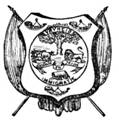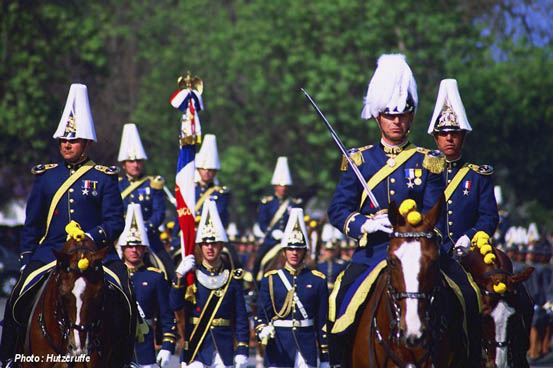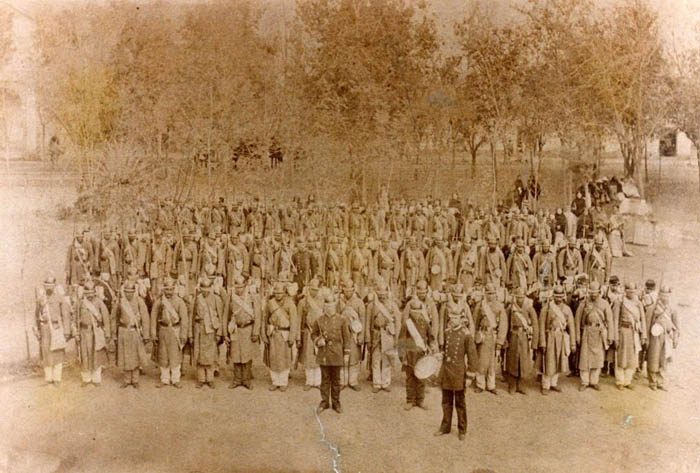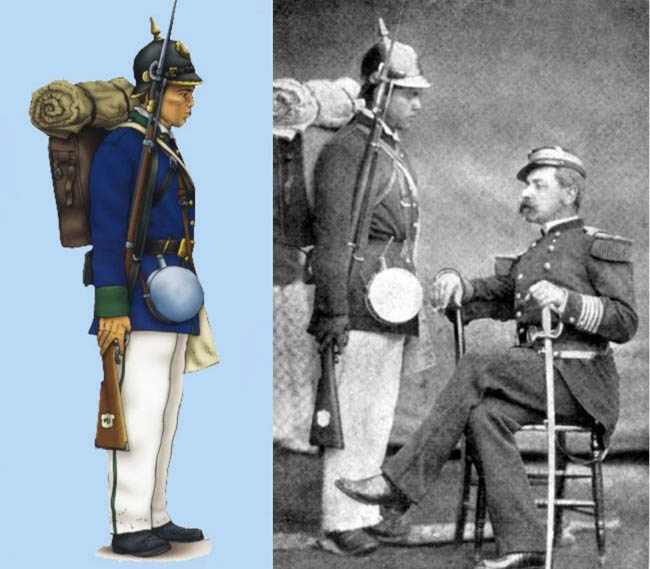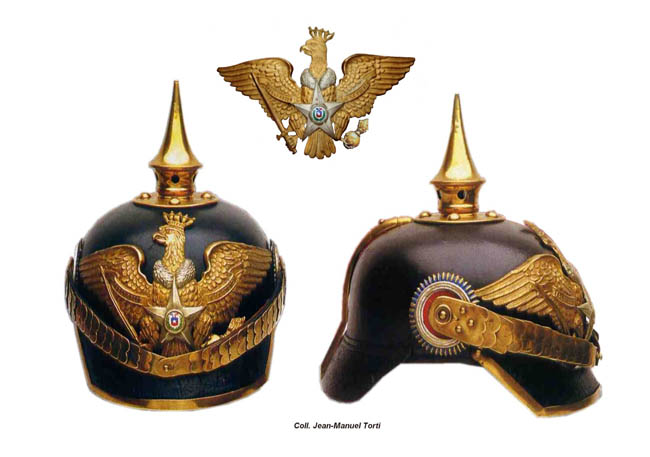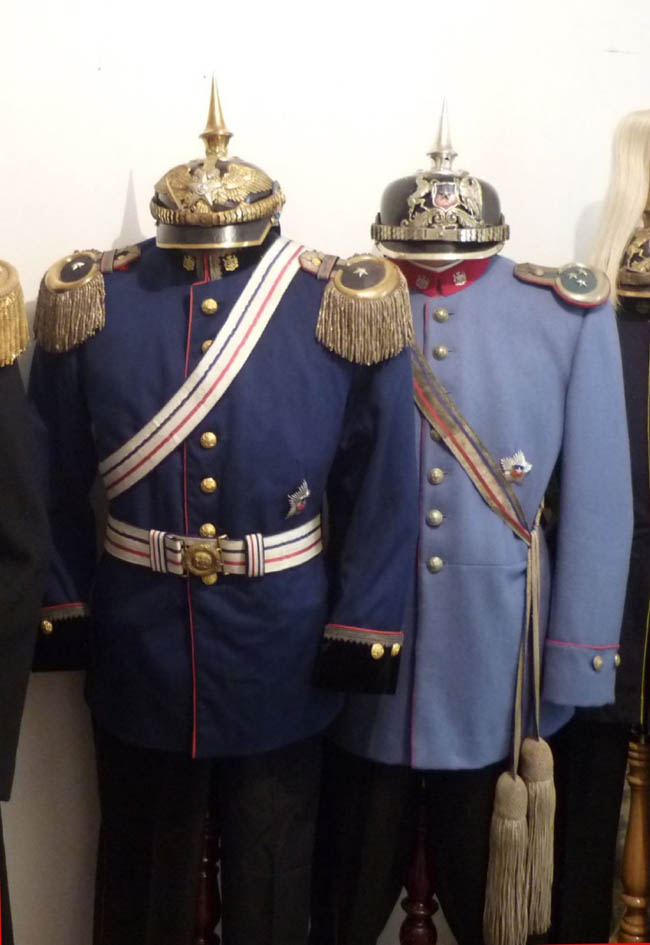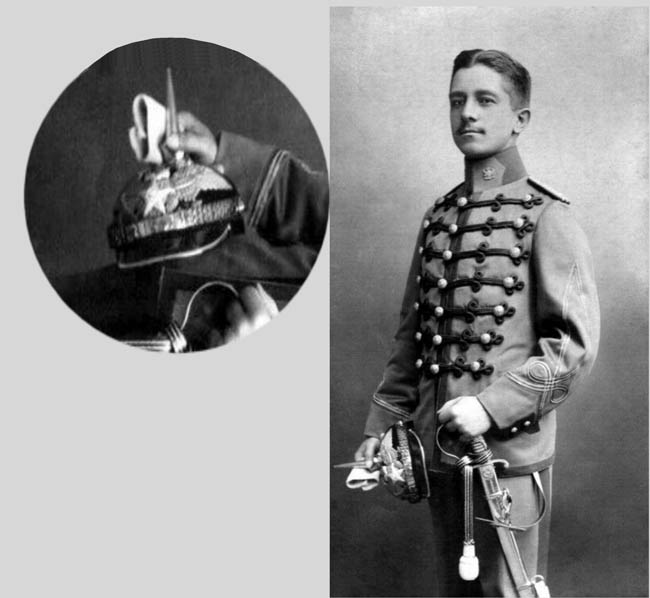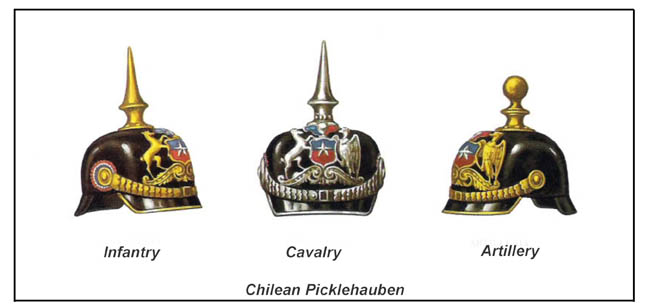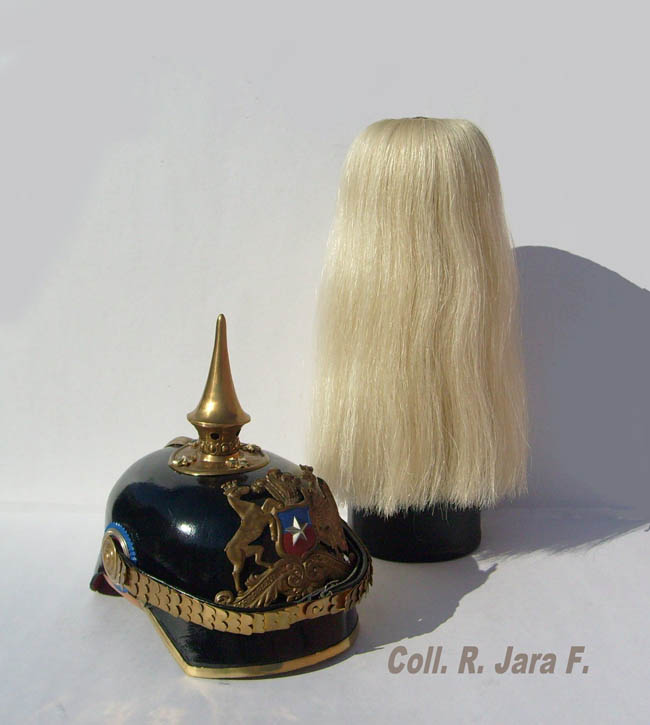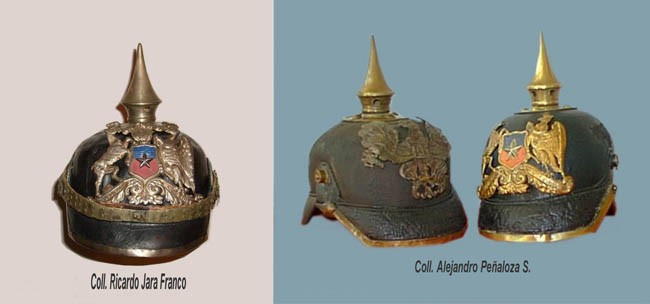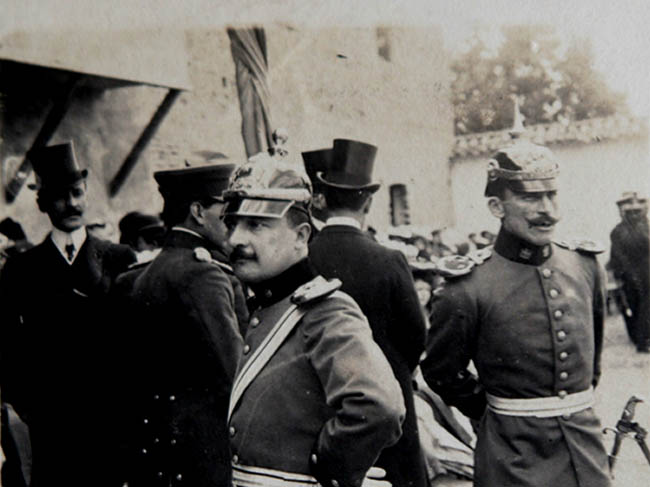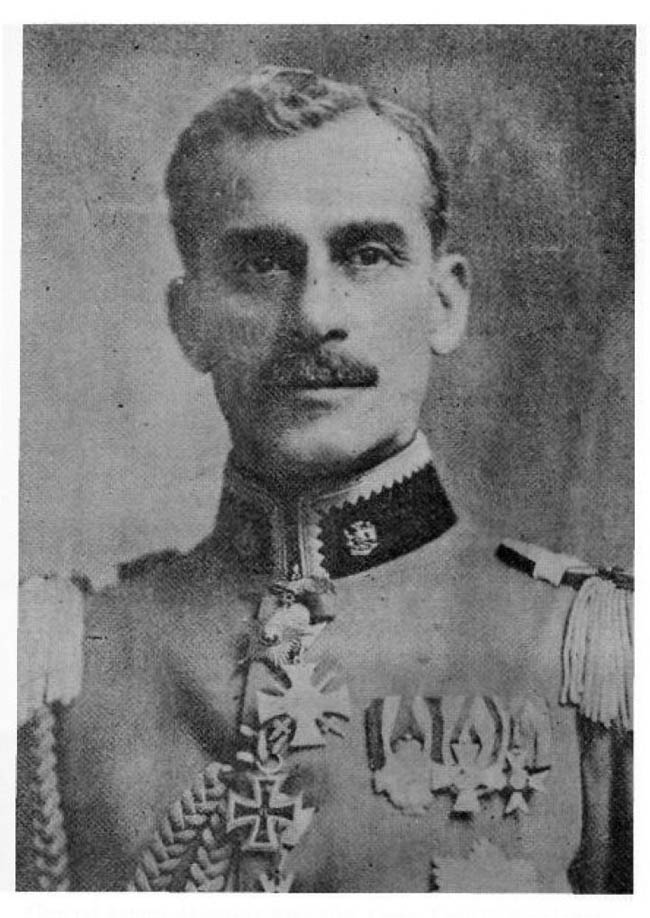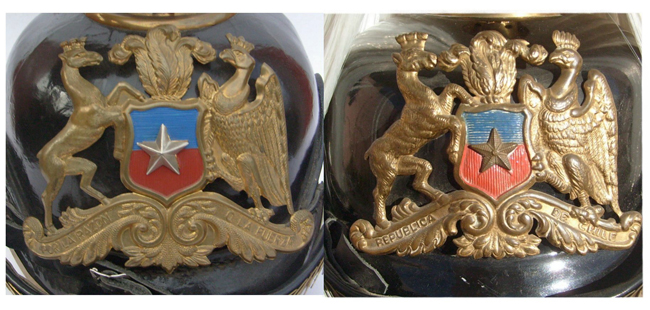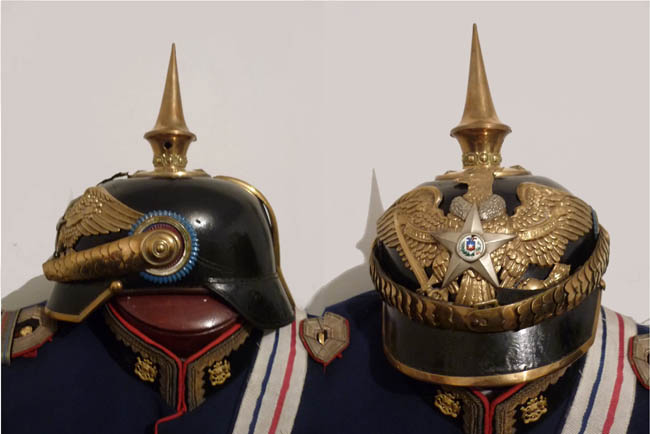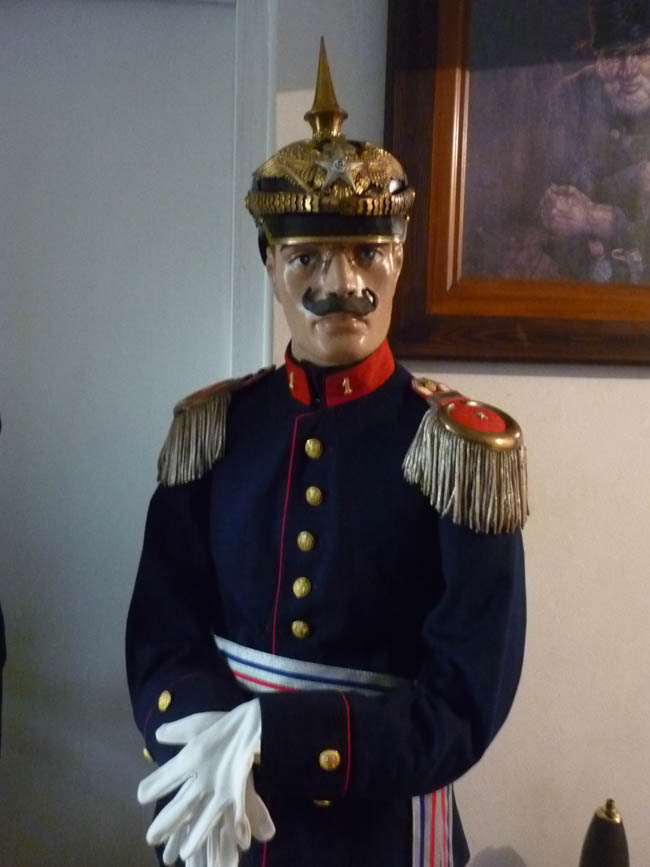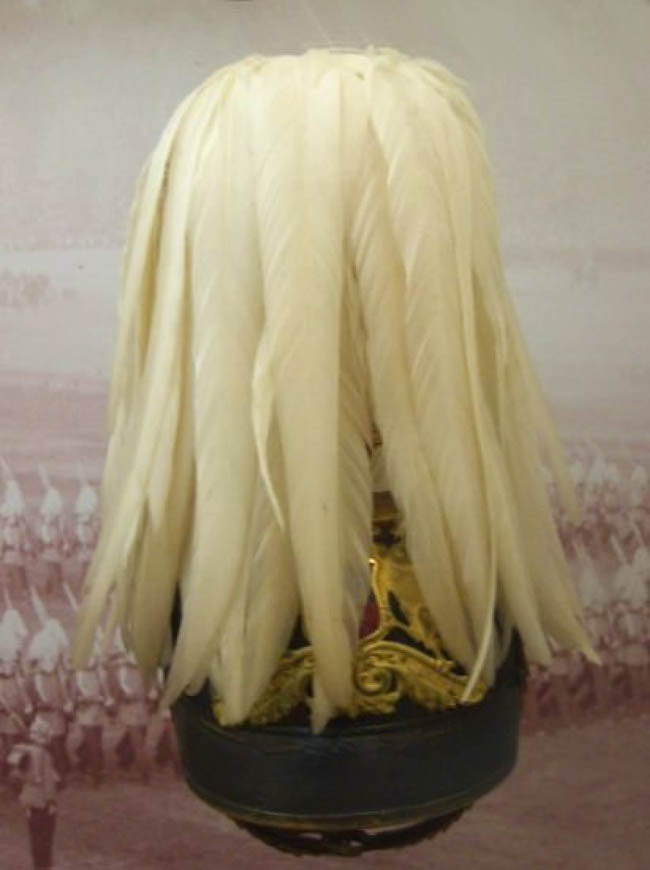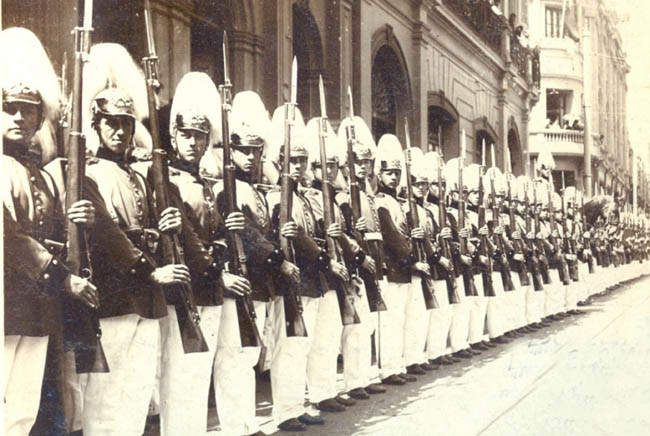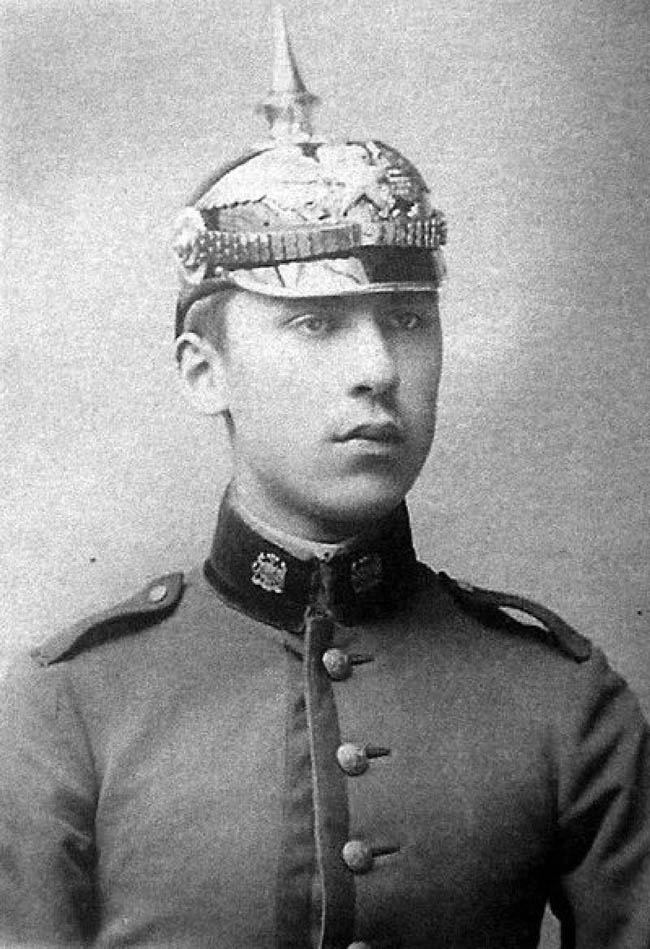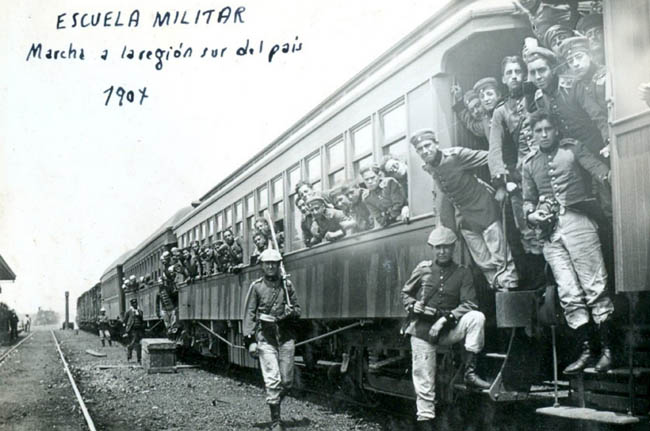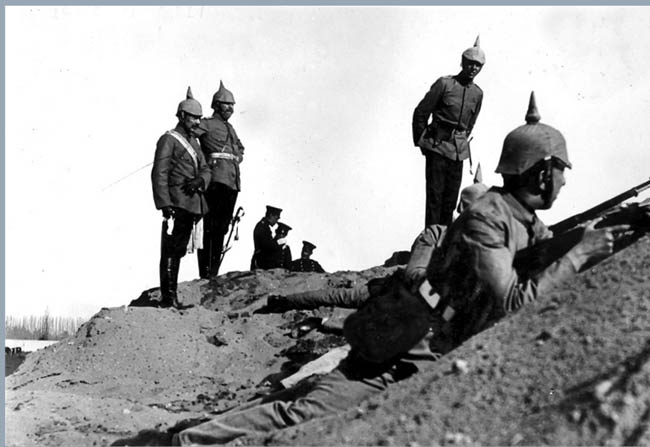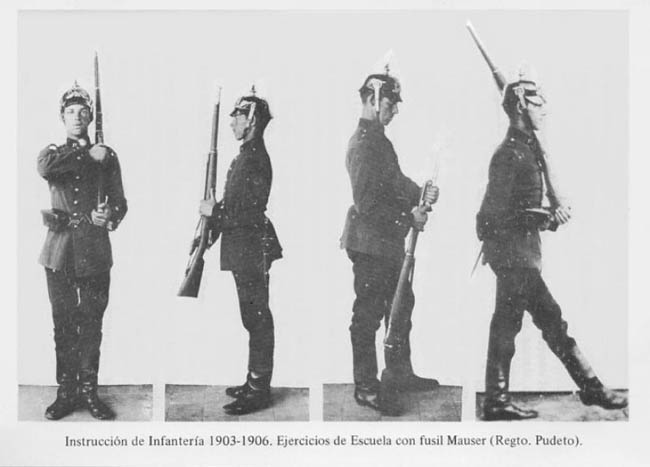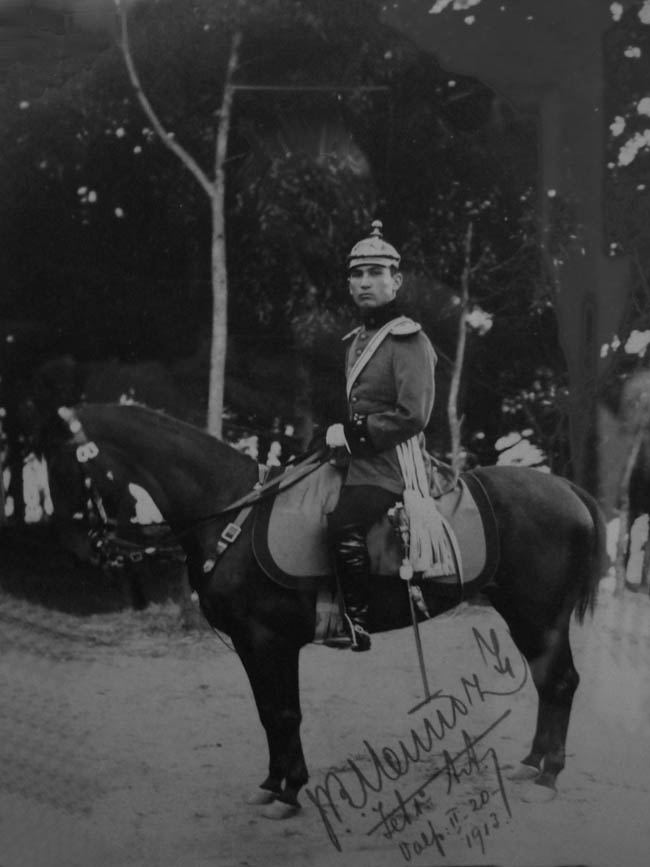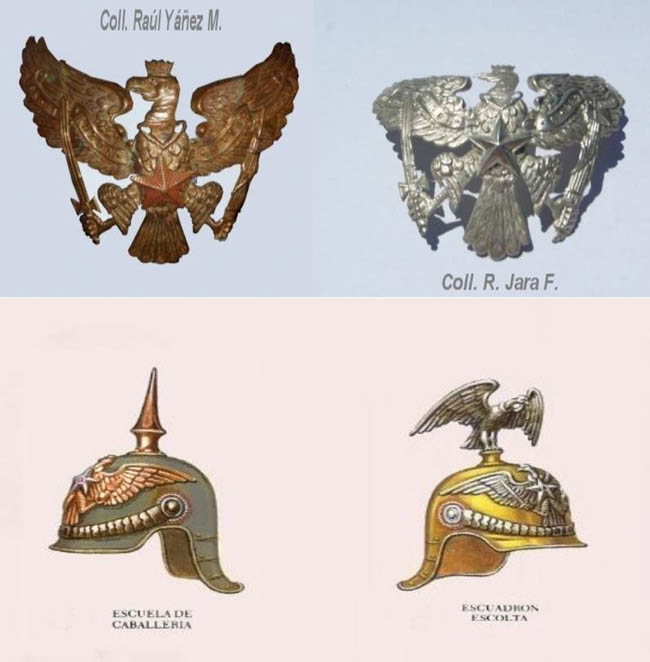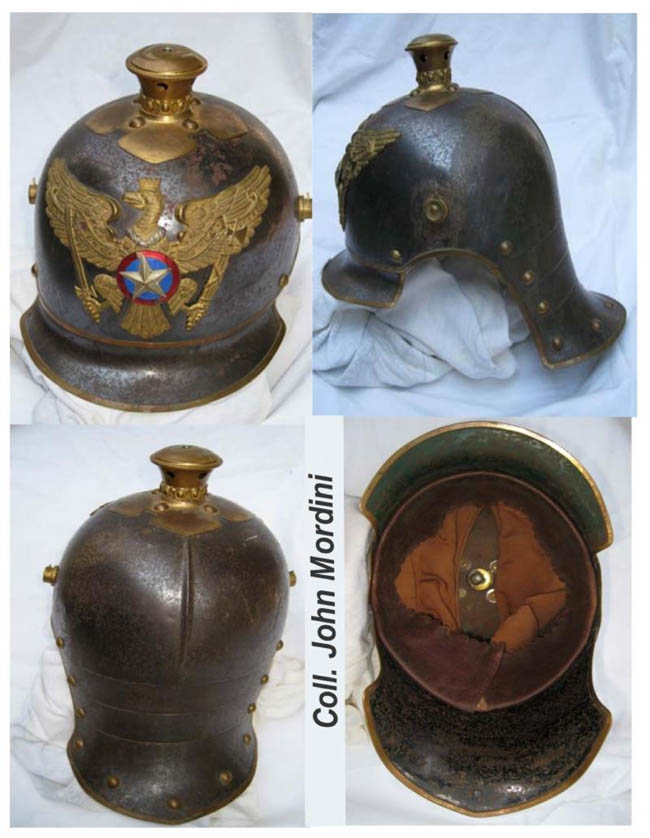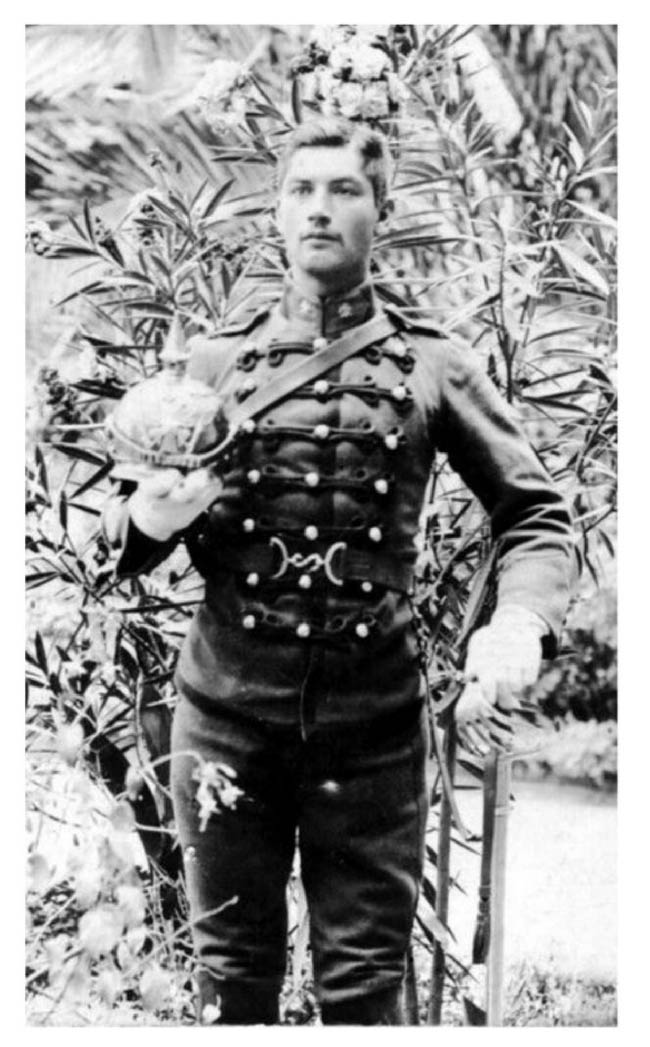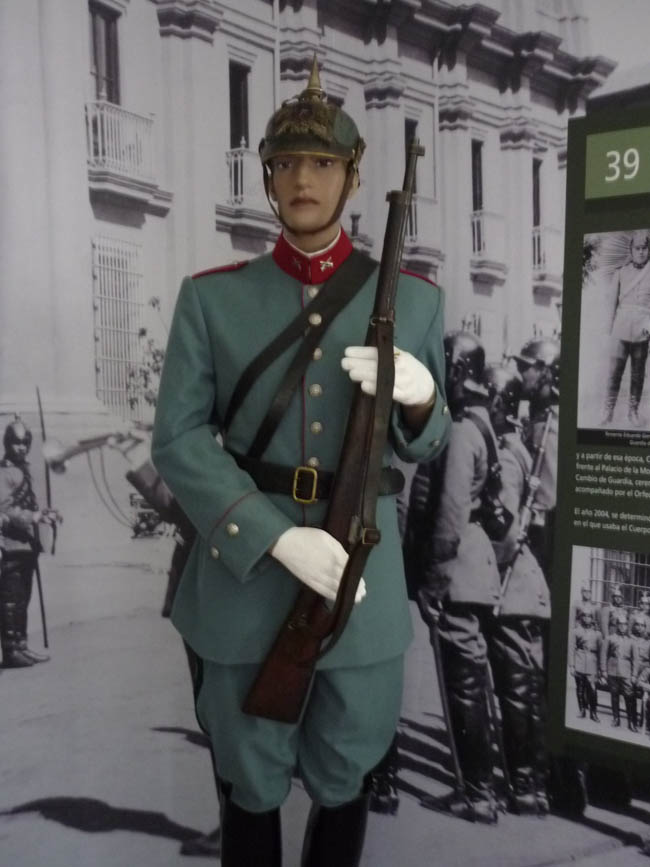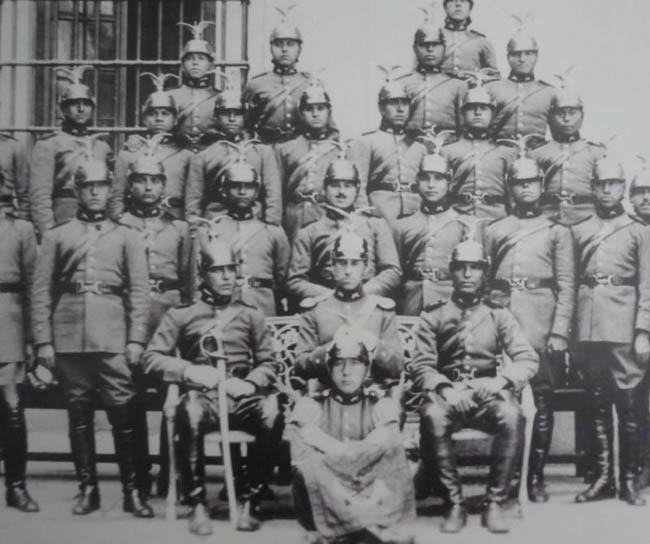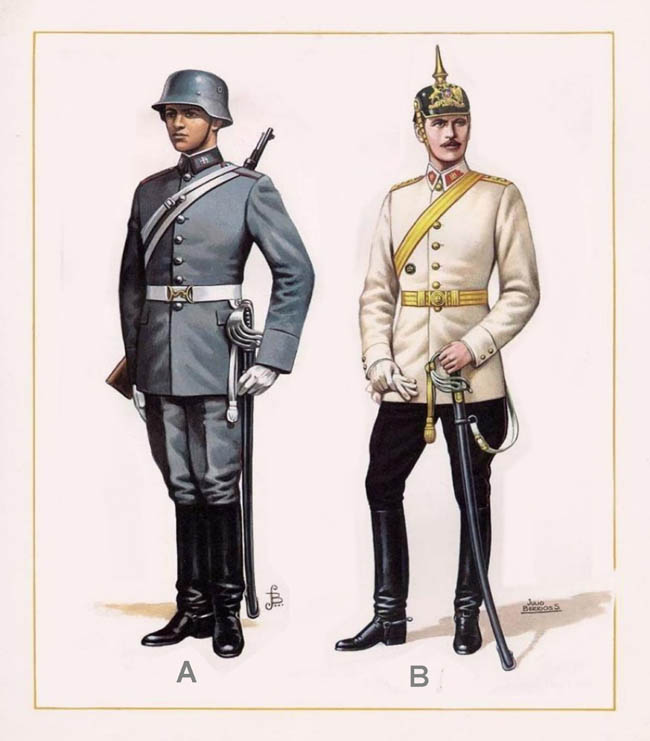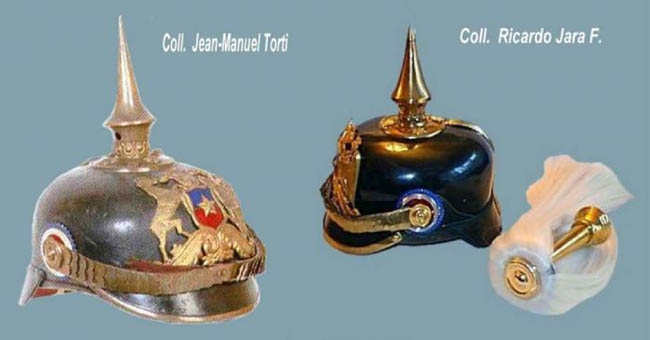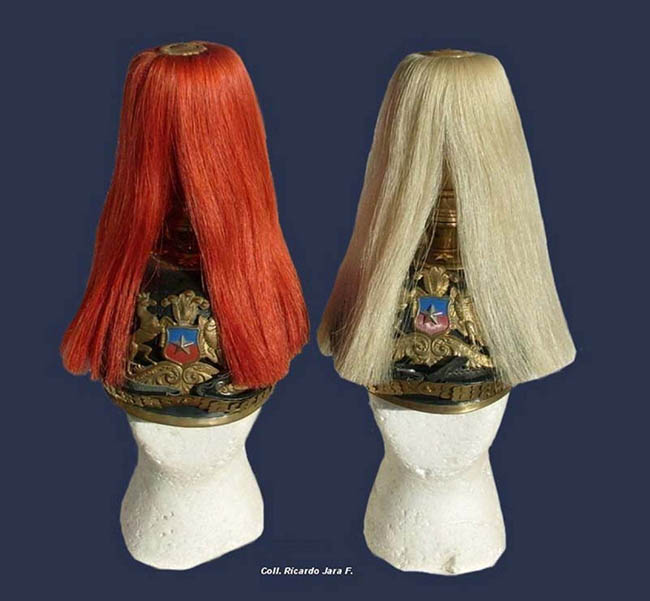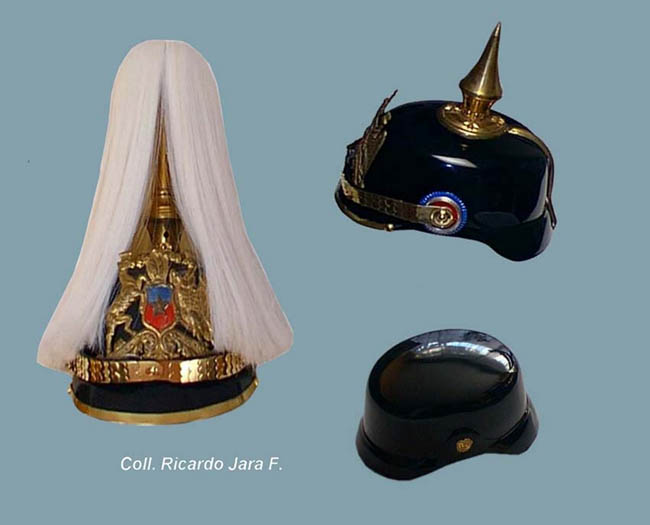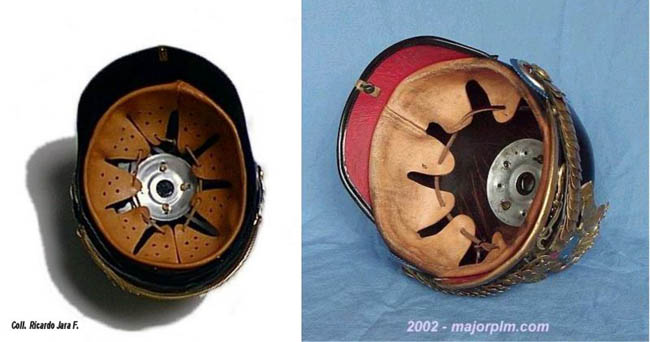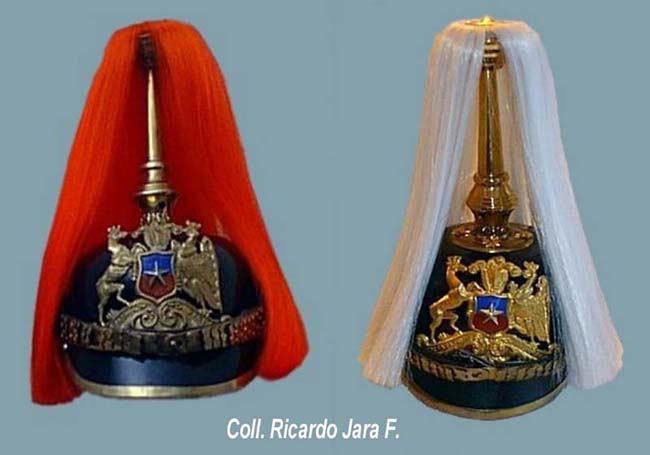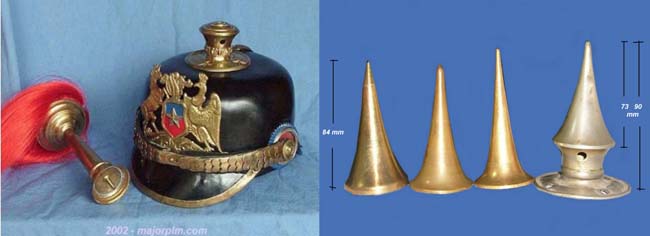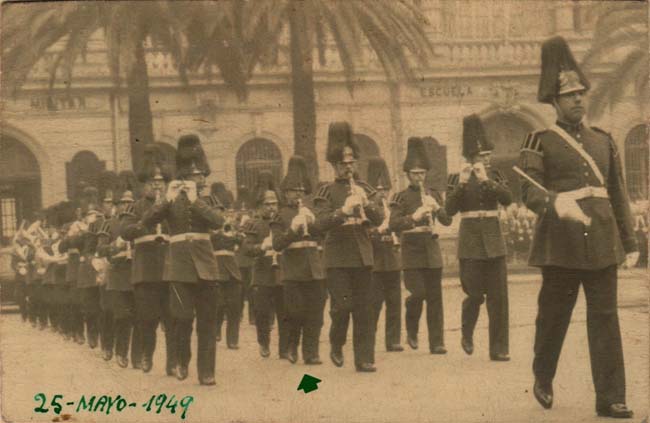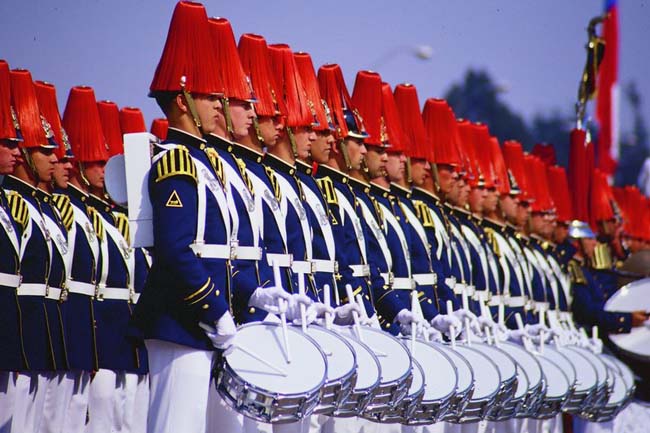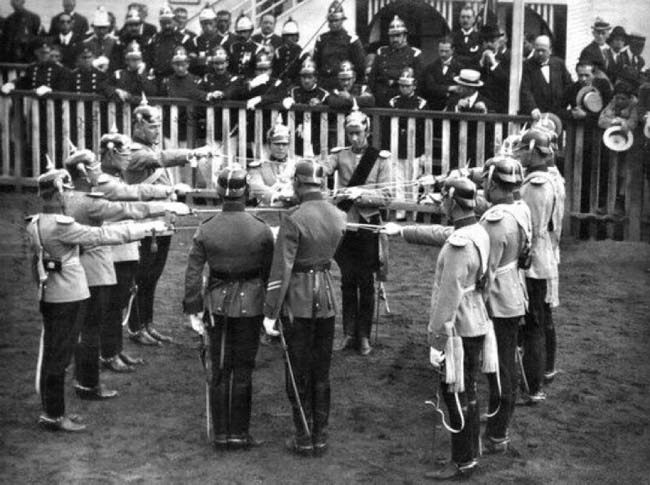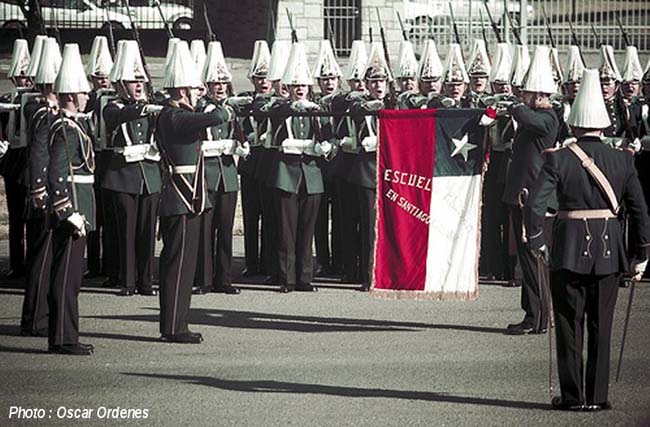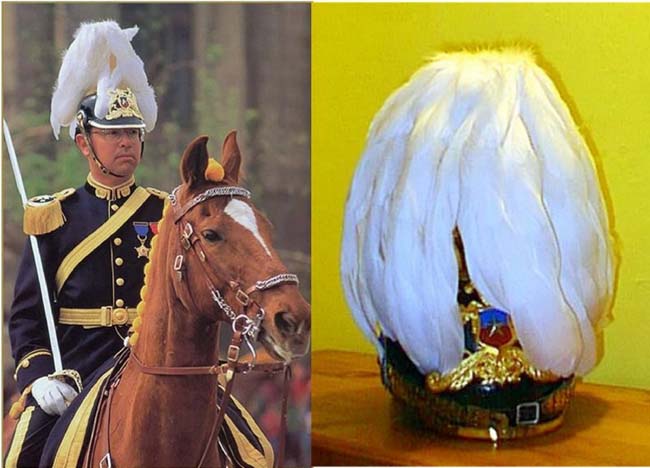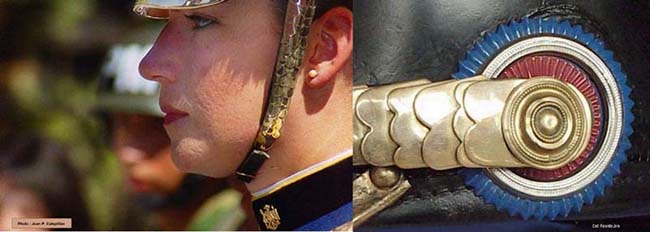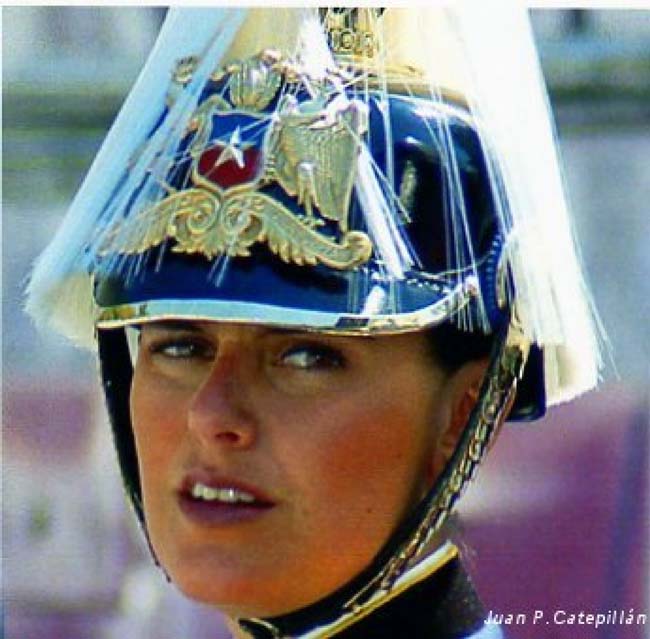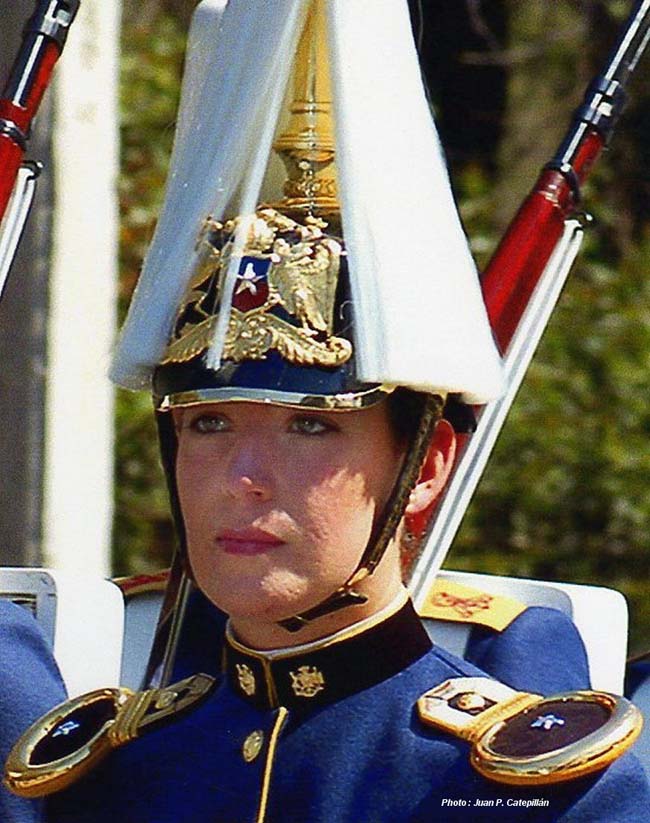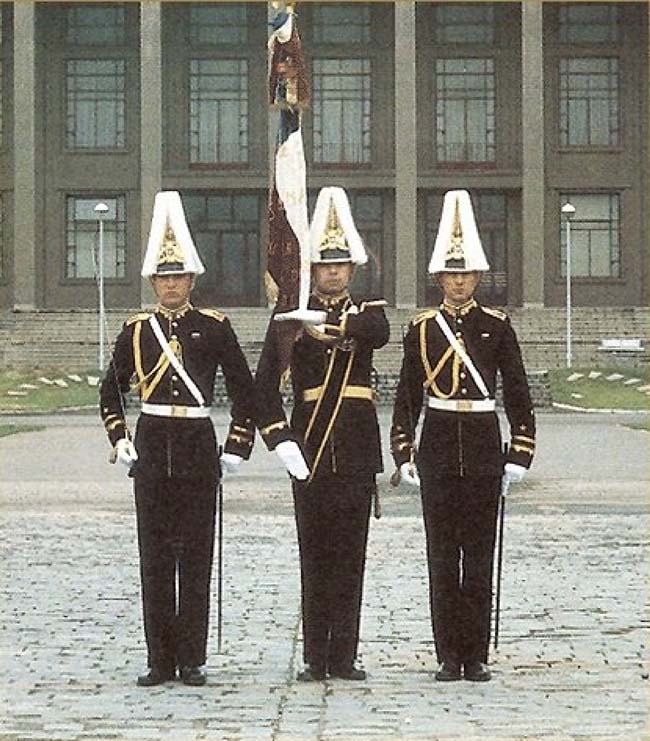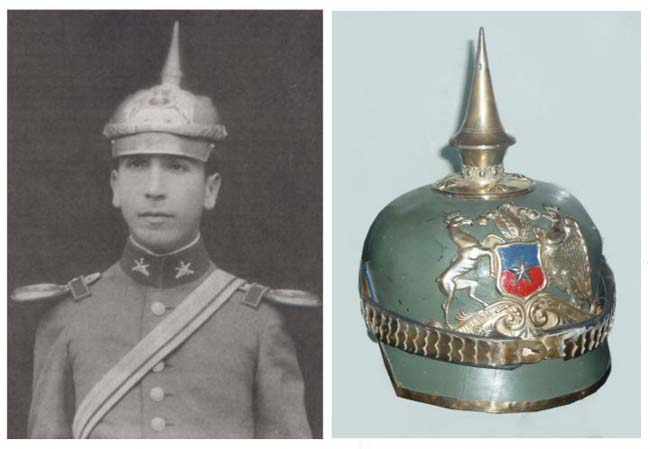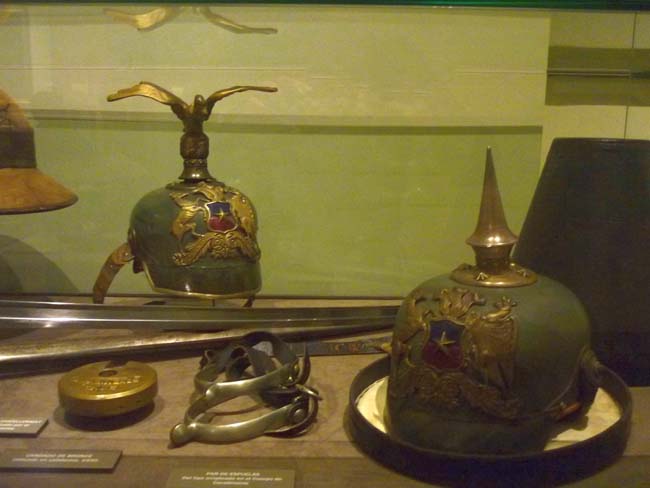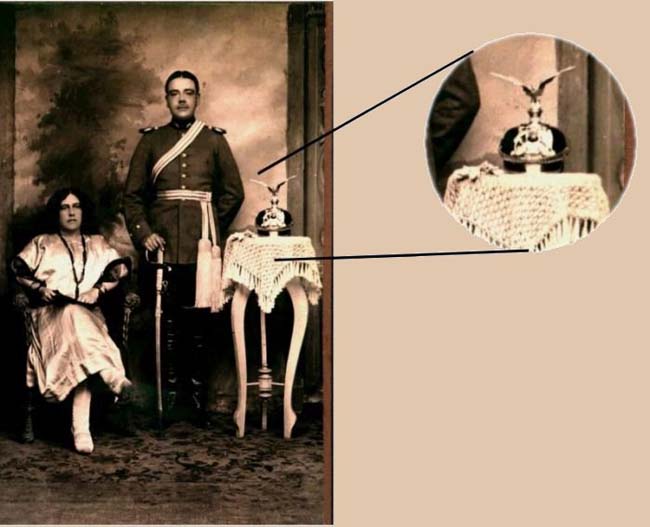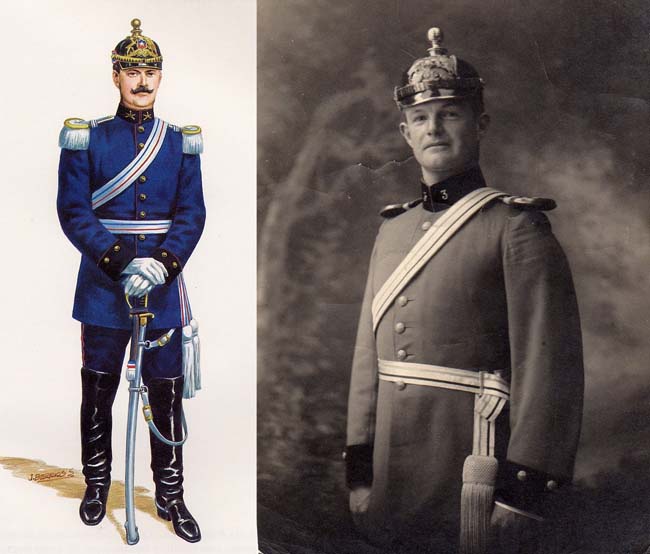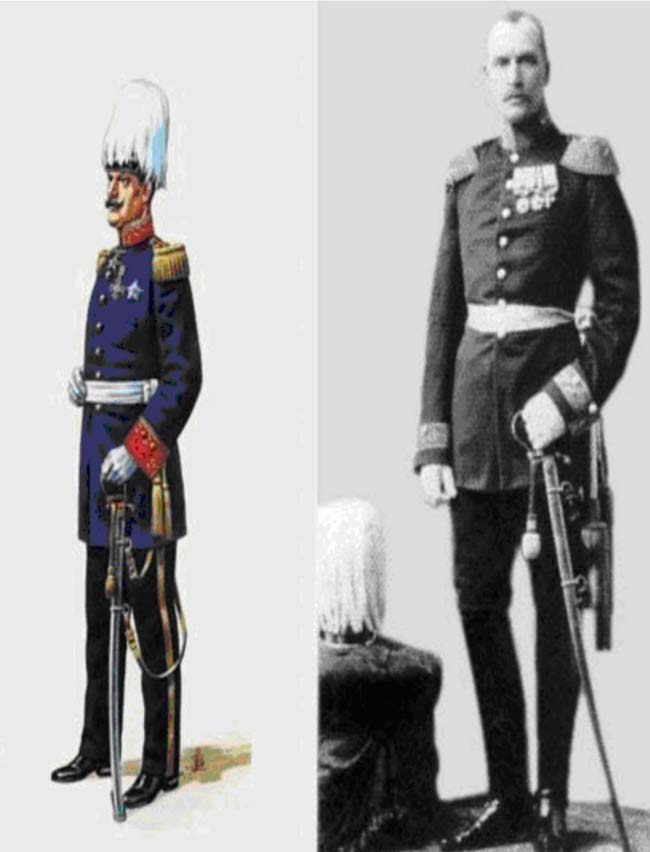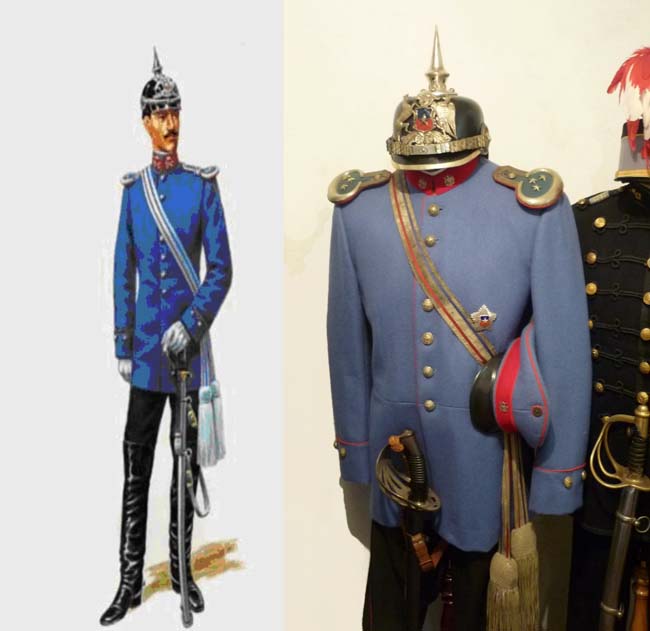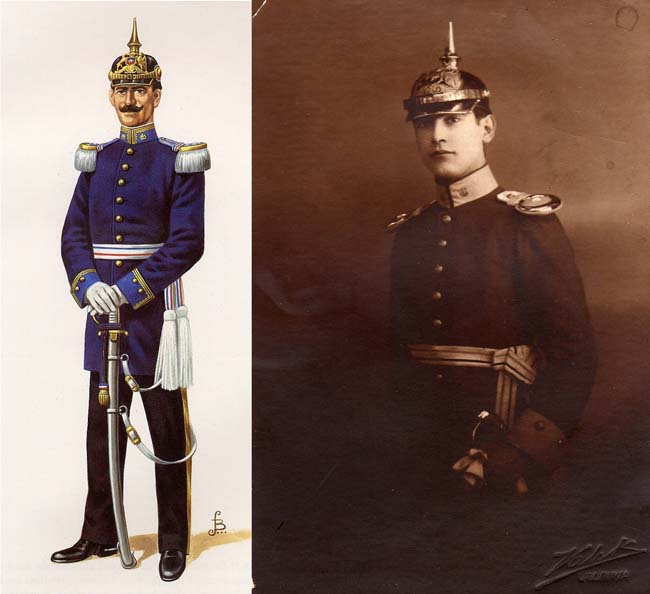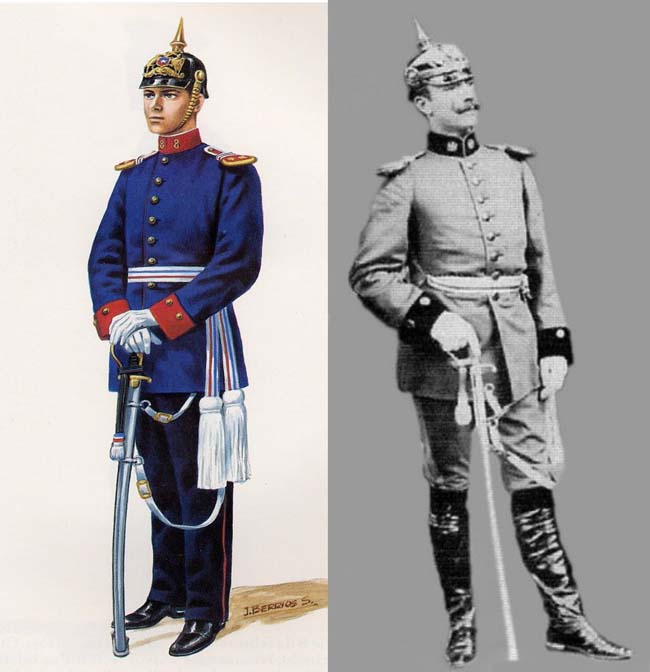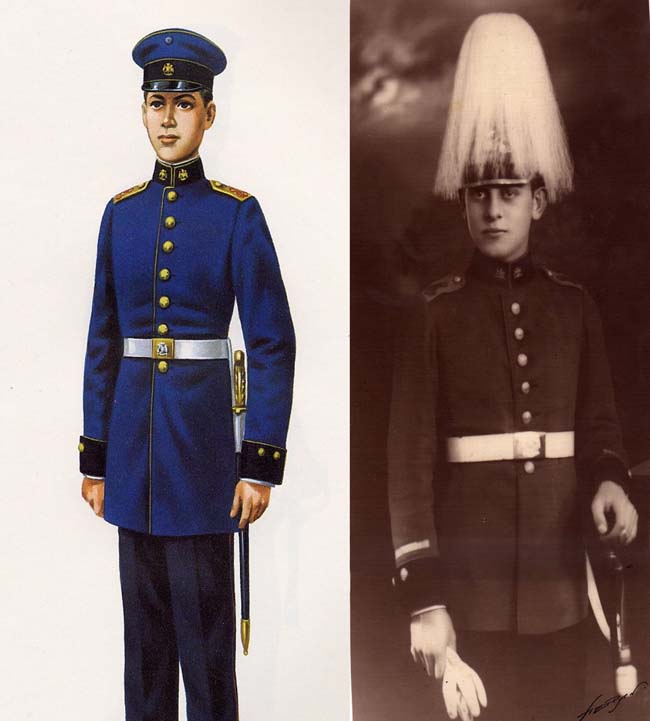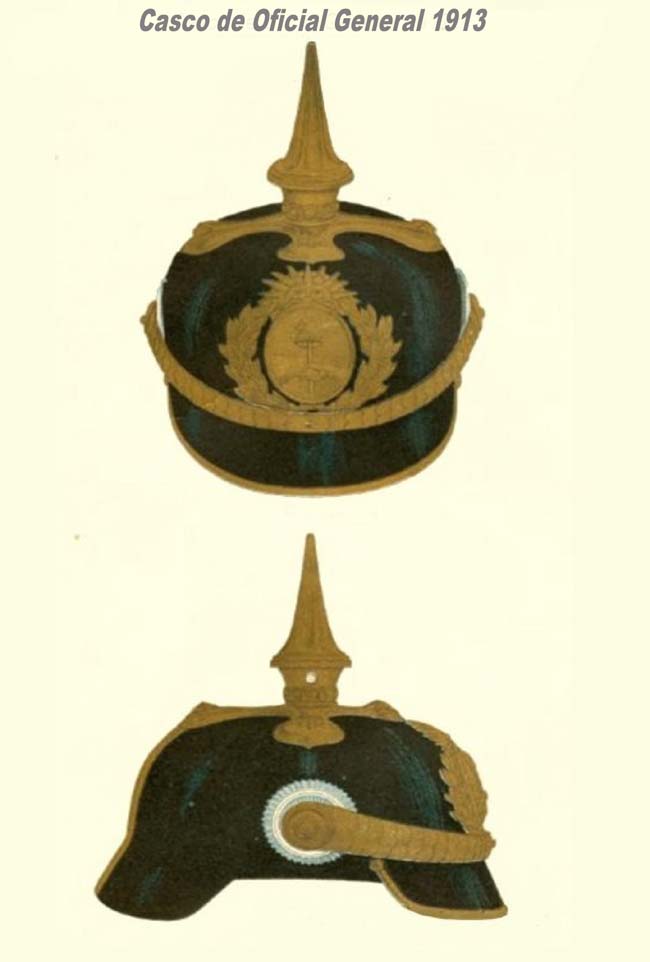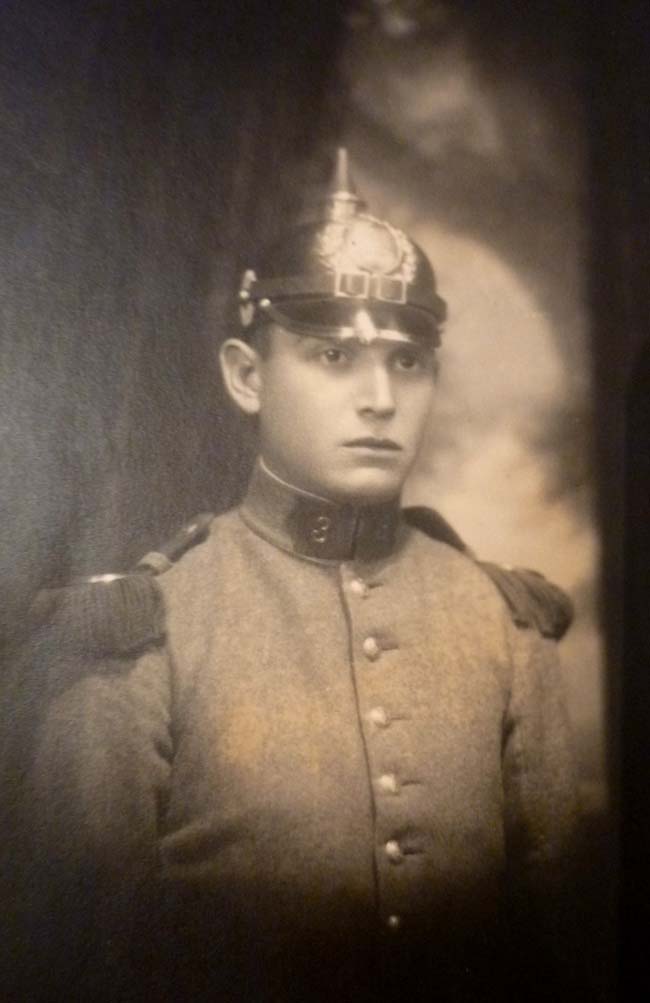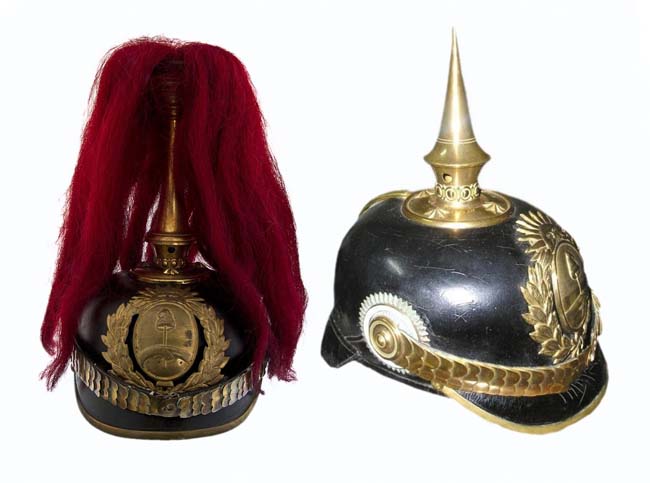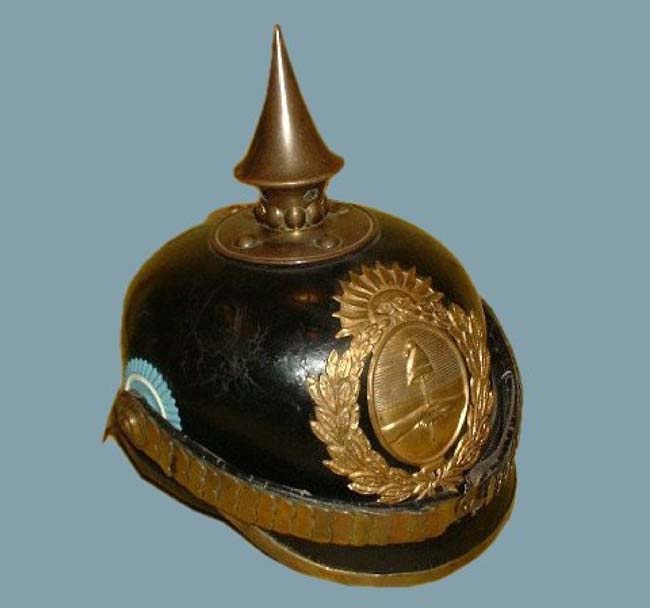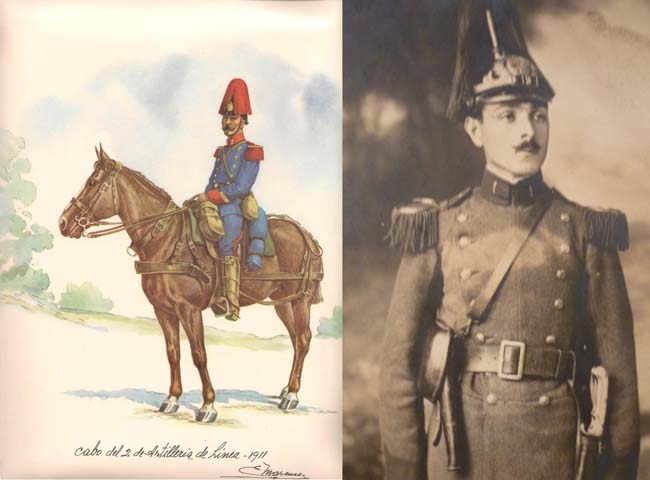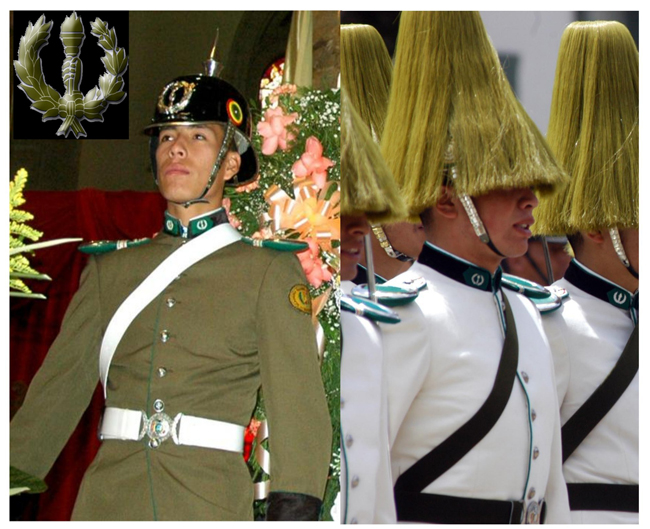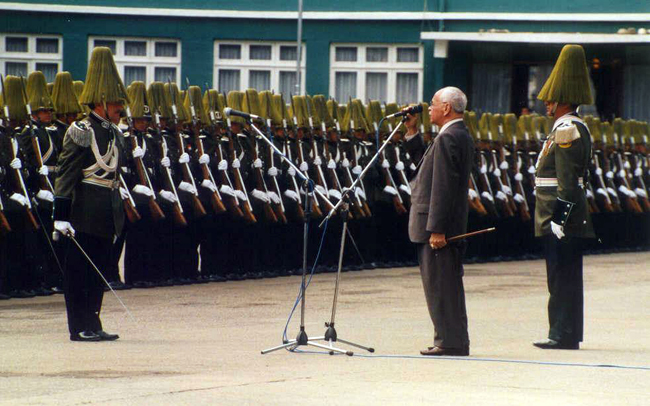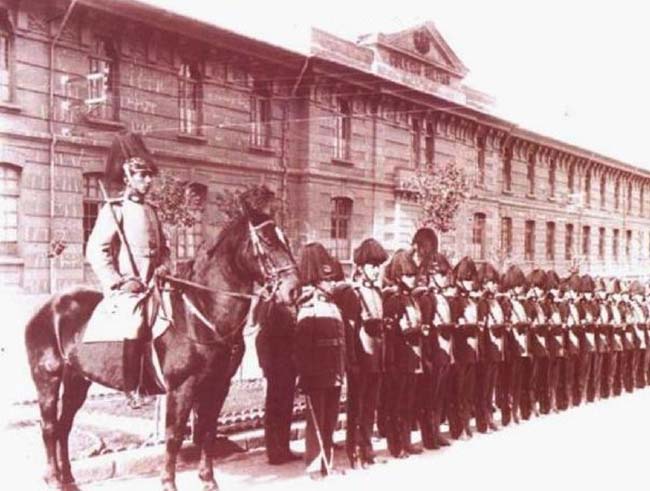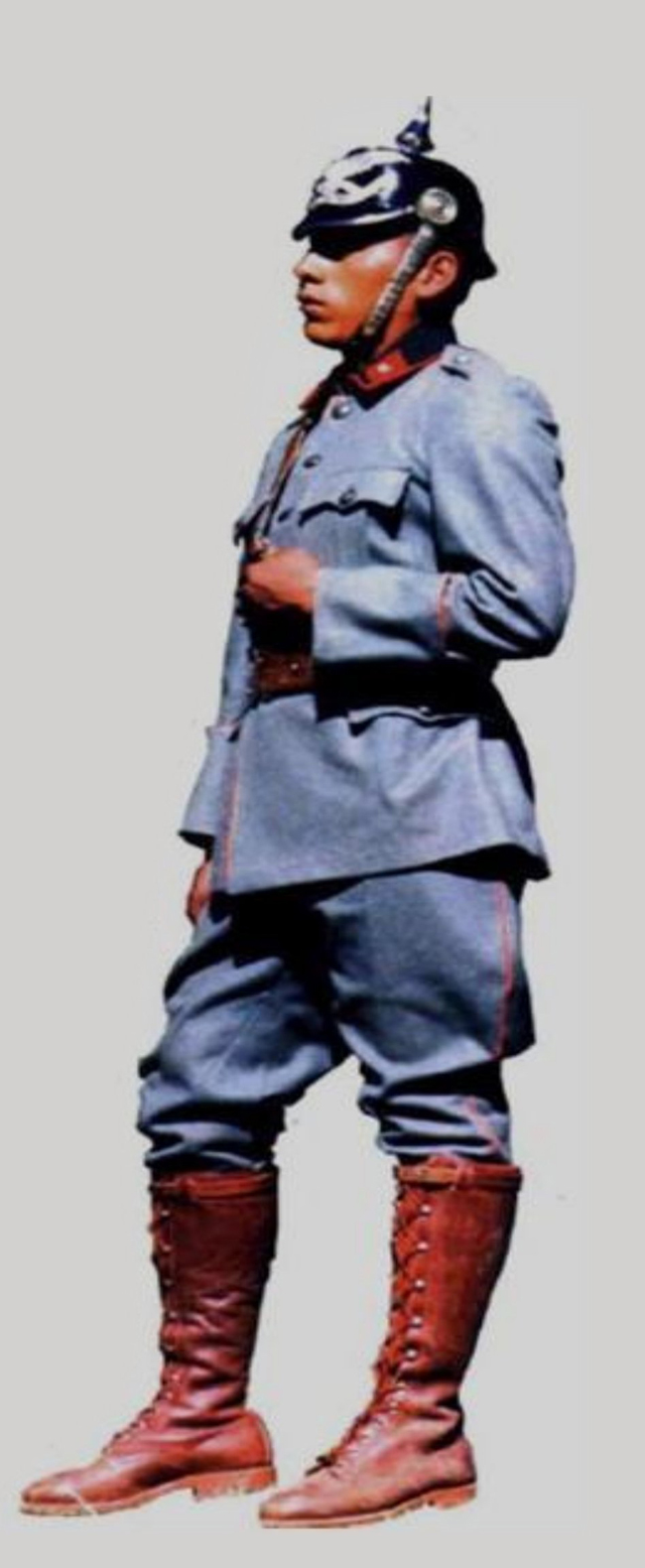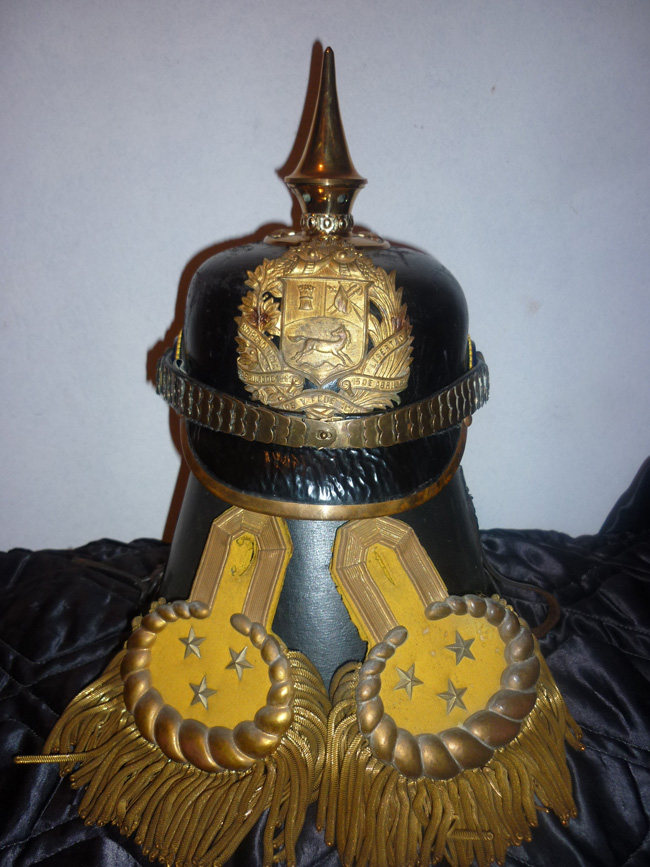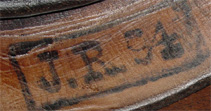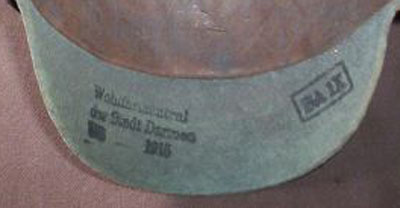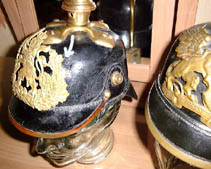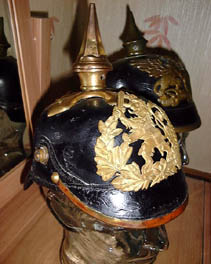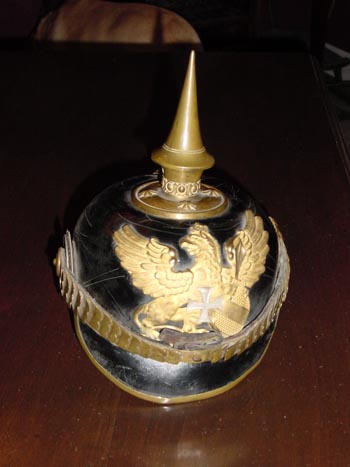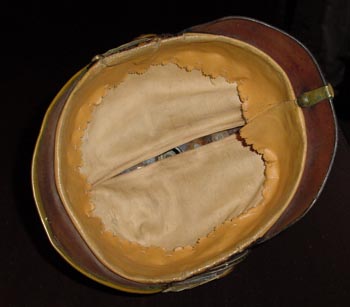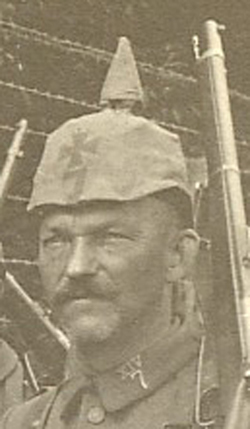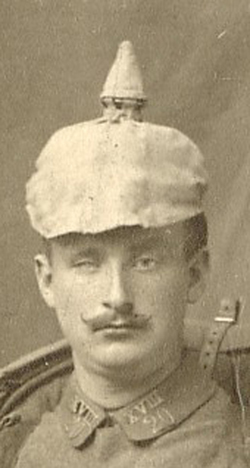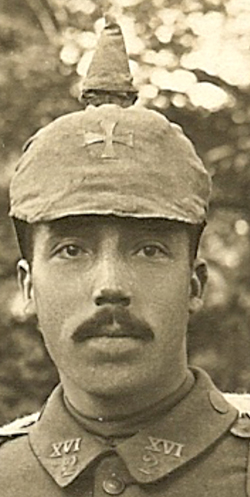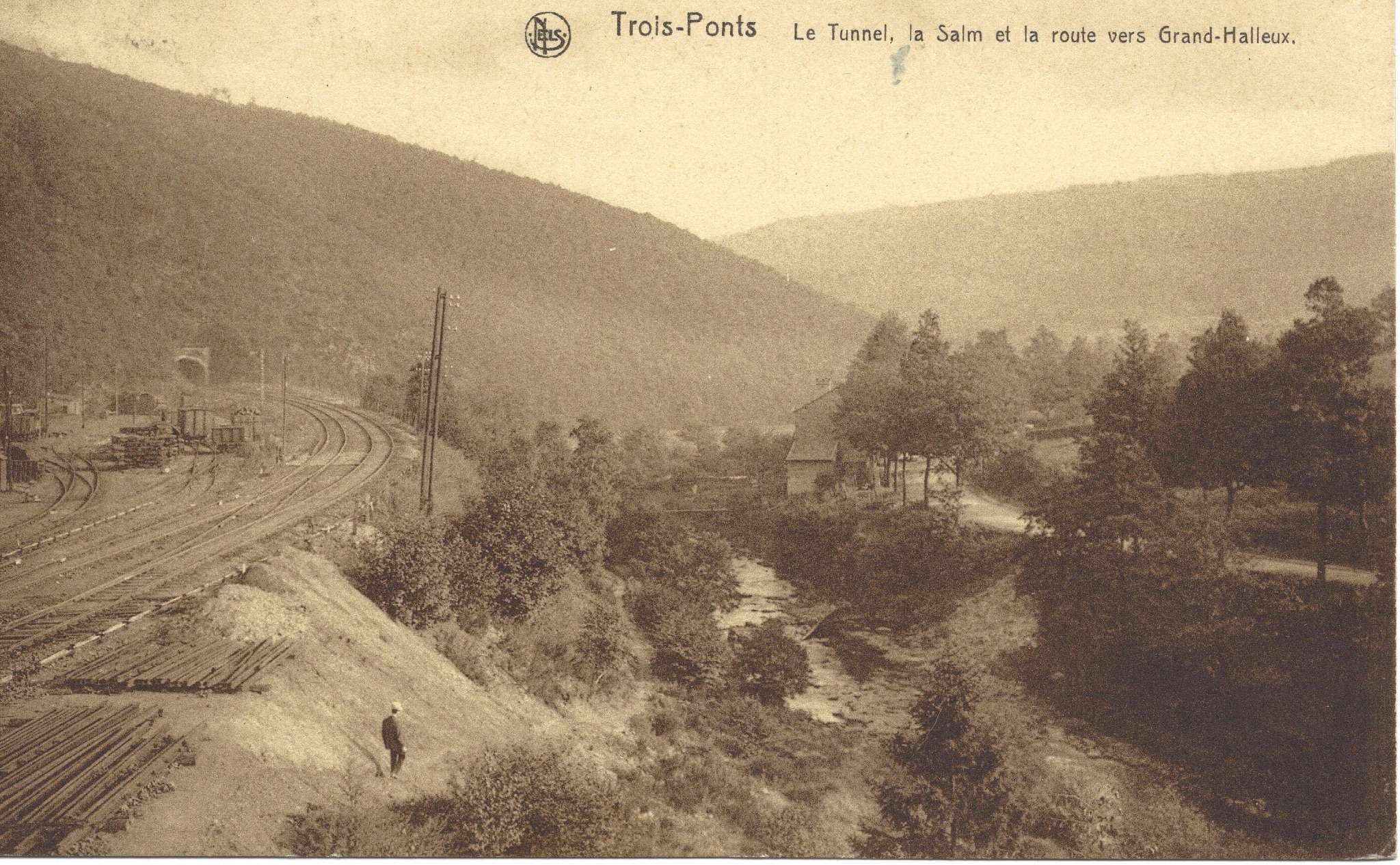

The Free State Artillery Pickelhaube
MC Heunis—O.V.S.A.C. Study No.9
JUL-SEP 2004
|
Little Prussia in the Veldt
|
||
|
If you are interested in receiving any of the OVSAC’s other study pieces on Boer War artillery and re-enactment, please contact the Officer of Administration, MC Heunis at kruppgun@yahoo.co.uk
|
||
| Introduction
Very few relics of military history are as distinctive and striking as the German Pickelhaube. After Prussia’s quick victory over France in 1871 the spiked black leather helmet became a symbol of military strength, moving several other armed forces around the world to imitate the Prussians and to adopt some form of spiked helmet. One of the most interesting states to do so was the small Boer republic of the Oranje Vrijstaat.
History of the Pickelhaube In 1842 the Prussian King, Friedrich Wilhelm IV, introduced a tall spiked helmet for the majority of his foot troops. The helmet with its sharp spike was designed to create the image of a highly aggressive military force. Officially the head dress was called a Helm, but in typical military style the soldiers who wore it came to refer to it as Pickelhaube, which literally means “Pick Cap”. |
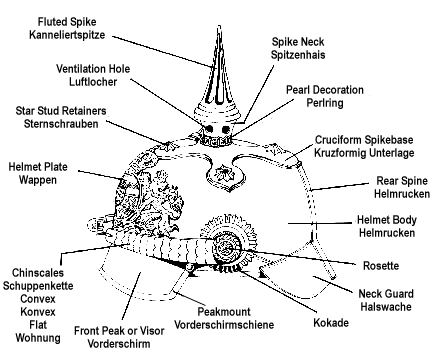
Drawing showing the main parts of a Pickelhaube.
|
|
| The original helmet (Model 1842 or M1842) consisted of a shell onto which a square front and rear visor were sewn. The shell was formed by pressing a piece of steamed leather through a large mould. After this the helmet was covered in many layers of black lacquer until it could be polished to a bright finish. The helmet was equipped with a brass reinforcing trim piece on the front visor and a brass spine at the rear. The completed helmet was almost 38cm tall with a cruciform spike base and a large gilded brass helmet plate. For most units the helmet was decorated with a tall spike, but artillery units wore a ball final to represent a cannon ball or Kugel. | ||
| The spike was ventilated by two holes on the spike neck. Around the neck of the spike was a brass decorative Perlring, literally, a “ring of pearls”. Convex brass chinscales were worn by all ranks and were secured to the helmet with a long bolt with a brass head. The spine was secured to the helmet by external bolts. Originally the front plate was also secured by two bolts that passed through the front of the plate, but in 1843 this was changed to two bolts soldered to the reverse of the plate. On the right side of the helmet a single leather cockade (Kokarde) in the Prussian national colours of black/white/black was worn under the chinscales.
Shortcomings of the original design were immediately evident, but the King had an irrational attachment to his creation. The helmet was so tall that some observers even proposed that soldiers should carry their mess kits inside the top of the helmets! Truly impractical, even by 19th century standards, it was unpopular with the troops and had the tendency to fall off during drill. The continued dissatisfaction with the design of the Pickelhaube necessitated several developmental changes during the following years. The first major change occurred in 1856, when the convex brass chinscales were changed to flat brass chinscales for all infantry units (M1856/57). Calvary and field artillery units however continued to utilize the convex chinscales. At the same time, the leather Kokarde was changed to a smaller sheet metal version. In 1857 and again in 1860 the helmet’s height was also reduced to make the helmet less unwieldy and more practical for use. Experience gained in Prussia’s wars against Austria and Hanover in 1866 and against France in 1871, indicated that the Pickelhaube’s design required further refinement, resulting in the M1867 and M1871 helmets. To simplify production and reduce the cost of manufacturing, the cruciform spike base was changed to a round base, while the square front peak was changed to a rounded form. The round spike base was secured to the top of the helmet by four retaining studs. On the M1867 the rear spine was removed to reduce the amount of brass used in construction, but was reintroduced in the M1871 as the helmet proved to be too weak without it. The new spine was secured to the helmet with hidden bolts soldered to the underside of the spine. |
In January 1871, following the end of the Franco-Prussian War, the new German Empire was founded. The Pickelhaube was adopted by most units in the empire; each of the German Kingdoms, Dukedoms, Earldoms, Free Cities, etc., having its own unique helmet plate and state Kokarde. Many other countries also adopted some form of spiked helmet during this period, including Britain and the United States. Some more changes to the German helmet were introduced in 1887 to reduce the amount of brass used in its construction. The front peak trim was removed, and a ribbed edge was pressed directly into the leather. For infantry and foot artillery units, the brass chinscales were changed to a leather chinstrap for enlisted ranks. For the new leather strap the threaded post and bolt used to secure the chinscales was changed to a loop and hook system. The spike was reduced in height, and the Perlring on the spike neck was removed from enlisted men’s helmet spikes. Officers, NCOs and cavalry units however continued to utilize the Perlring.
A ball-pattern Perlring on a Kugelhelm. |
|
|
The M1891 chinstrap retaining loop and post.
|
In 1891 the loop and hook system used to hold the leather chinstrap in place on the M1887 helmet was replaced with a loop and post arrangement. A new double buckle leather chinstrap was used and the end of the strap was fitted with a brass loop with a “V” cut. The loop was designed to fit onto the corresponding M1891 post, keeping it secure but allowing easy removal. The front peak brass trim was also reintroduced as it was found that its omission weakened the helmet significantly. The M1891 further brought about a final reduction in the height of the helmet, giving it a more domed appearance – a remaining feature on all future Pickelhauben. |
|
| In 1895 the rear spine on all enlisted men’s helmets was equipped with a ventilation hole near the base of the spike. The vent was fitted with a small sliding cover, which enabled the user to increase or decrease the flow of ventilation in the helmet. To further aid in ventilation, the two vent holes on the spike neck were increased to five. The soldered bolt and nut system used to secure the front plate onto the helmet was also changed to a soldered loop that passed through corresponding holes on the front of the helmet.
In 1897 a new Reichs-Kokarde in Red-White-Black, to commemorate the 100th anniversary of the birth of Kaiser Wilhelm I, was introduced for all ranks of the German Imperial Army. The new Kokarde was worn on the right side of the helmet, while the different state Kokarden were moved to the left. After the outbreak of the First World War, the shiny brass and German silver fittings on enlisted men’s helmets were changed to steel and were painted in various shades of grey. This was done primarily to free up brass and silver for the war effort and to make the wearer less conspicuous. Another effort to make the wearer less visible was to make the spike removable. The new pattern spike was slotted and fitted into a corresponding bayonet-style lug on the round spike base. These changes brought about the final and most common Pickelhaube, the M1915. |
Due to the Allied blockade of Germany, a shortage of leather (imported from Argentina) resulted in the German army making helmets from Ersatz (replacement) materials. Manufacturers of kitchen utensils were called on to turn out helmets of thin steel and tin. As the war continued, many other materials were also used, including felt, vulcanised fibre, cloth covered cork, and even paper mache. Some of these helmets were equipped with brass and silver fittings as manufacturers used up remaining parts from pre-1915 helmets, while other carried M1915 grey steel fittings, or even a combination of both.
The end of the Pickelhaube had dawned. Neither the leather nor the Ersatz steel Pickelhaube helmets offered any protection in combat, and therefore the Army Medical Corps demanded that new head gear should be developed to reduce the number of head wounds. In February 1916 a steel helmet (Stahlhelm) was introduced in small numbers to the front line troops engaged in the Battle of Verdun. The resulting reduction in the number of head wounds suffered by the soldiers lead to the general replacement of the Pickelhaube. In the end the German army used Stahlhelms in greater numbers, but it was the Pickelhaubethat left a lasting impression on world history. |
|
| The Free State Artillery Pickelhaube | ||
| In November 1880 FWR Albrecht, formerly of the 4th Prussian Guard Artillery of Berlin and a veteran of the Franco-Prussian War, was appointed as captain and commanding officer of the Oranje Vrijstaat Artillerie Corps (OVSAC). Under his competent leadership the OVSAC was to undergo a major turnabout. (Not so sure… 4. Garde-Feldartillerie-Regiment was not formed until 1899 and in any case was based in Potsdam. Albrecht was not a former Prussian Artillery Officer as claimed by some. I believe Albrecht was a gunner in the Franco-German War and probably rose to NCO rank before leaving Prussian service.Joe) Earlier Free State Artillery uniforms and helmets were based on those of the British Royal Artillery, but in 1885 Albrecht started to introduce Prussian style uniforms. The new uniforms resembled the dress of the 2nd and 4th German Guard Artillery regiments and were imported from Germany. At least two different suppliers were used, CF Wulfert and Eduard Sachs, both Berlin based military effects and uniform factories. The switchover from British to German uniforms was gradual and various photographs show OVSAC Gunners wearing Prussian style tunics with the earlier British style helmets. Exactly when the Pickelhaubemade its first appearance in Bloemfontein is not known, but it is suspected to have been in the late 1880s or early 1890s. |
Major FWR Albrecht in officer’s undress.
|
|
|
Eduard Sachs’ label on the inside of a surviving OVSAC Pickelhaube carry case preserved at the War Museum of the Boer Republics. |
Because the Free State’s helmets were privately purchased they differed from the standard German army issue Pickelhaube. In Germany private-purchase pattern helmets were referred to as Eigentums-helm or also known as Extra-helm or Eigetumsstück. Eigentum translates to “property”, indicating the item was privately purchased by an individual. In the German army any soldier was allowed to purchase an Eigentums-helm, but it usually depended on the wealth of the individual and therefore they were mostly worn by the better off One-Year Volunteers (Einjährig-Freiwilliger) and Officer-Candidates (Fähnrich). The Eigentums-helm was of a better quality than the standard army issued helmets and often incorporated style and comfort features normally only found on helmets issued to officers. | |
| Helmet Construction: The Free State helmet consisted of a domed shell, similar to the German M1891, with a round front and square rear visor. The helmet was finished in a bright polished black, while helmet fittings such as the front plate, ball final and base, front visor trim and rear spine were manufactured from gilded brass. |
||
|
Front Plate: The one-piece stamped gilded brass front plate was of the same design as those worn on the earlier Royal Artillery pattern helmets. It consisted of a large eight-pointed star with a Free State coat-of-arms and scroll (bandeau), reading “Oranje Vrystaat”, surrounded by a laurel wreath. The stamped plate was secured to the front of the helmet by two threaded bolts soldered to the reverse of the plate and passing through the front of the helmet before being fastened by two flat square brass nuts. |
||
|
Kokarden: Unlike some researchers have claimed in the past, only one Kokarde was worn under the chinscales; on the right hand side of the helmet. The Kokarde was manufactured from one piece of metal with a small centre hole (pre-1891 design) and finished in enamel paint in the colours of the lines on the state flag, white/orange/white. As was the case in the German army, the Kokarden on the Free State Artillery helmets seem to have differed according to rank. Surviving examples show at least two types of Kokarden in use: |

OVSAC officer’s Pickelhaube, reportedly that of Major Albrecht. National Museum, Bloemfontein.
|
|
In the German army NCO Kokarden were similar to those worn by Privates, but had an additional ring with a distinctive diagonal ribbing. It is not known whether this was also implemented on the Free State Artillery helmets and to date no surviving examples could be found. |
||
|
Private (left) and officer (right) pattern Kokarden. War Museum of the Boer Republics, Bloemfontein.
|
 |
|
 |

Right and left hand side of OVSAC officer’s Pickelhaube. War Museum of the Boer Republics.
|
|
| Kugel: Being an artillery unit, the helmets of all ranks carried a brass ball final with a round base. In the German army the height of helmet spikes was set at 95mm for officers and 85mm for all other ranks. On privately purchased helmets, like the ones imported by the Free State, the spikes generally tended to be taller and of a better quality. The ball spike top was removable to enable an orange and white falling horse hair plume (Trichter and Haarbusch) to be mounted to the helmet for full dress purposes. | ||
 |

Horse hair plume and Perlring detail on OVSAC officer’s helmet. War Museum of the Boer Republics.
|
|
| Perlring: The neck of the ball spike on Free State helmets was decorated by a brass Perlring. Privates and NCOs wore the regular ball-pattern Perlring, while Officers’ helmets utilized a more elaborate pattern sometimes referred to as the “Dart and Egg” pattern.
Base Mounts: The ball spike base on Private’s and NCO’s helmets was secured to the helmet shell with four domed threaded screws and was fastened on the underside with flat square brass nuts. Officer’s helmets utilized small 8-pointed stars on a threaded post to secure the spike base. On the surviving officer’s helmet of Lt Johan Böning, in the collection of the War Museum of the Boer Republics in Bloemfontein, the ball spike base is held in place by three domed and one star screw. Lt Böning was a one-pip lieutenant, but it is doubted whether his rank was indicated by the number of stars on the base and normally all four screws would have been stars for all officer ranks. |
Chinscales: Like the German Guard Artillery units, all ranks of the Free State Artillery Corps wore convex chinscales. The chinscale strap consisted of two halves with a small lug connecting the two thinner ends together. The other wider ends of the strap were secured to the helmet with a Rosette which had two split prongs that were bent back inside the helmet.
Visor and Trim: Visors on privately purchased helmets were made from higher quality leather and sewn to the helmet shell with fine thread. The visor trim was also of a higher quality, around 6mm wide, curved in shape and considerably thinner than the German army issue. Rear Spine: On the rear of the Free State helmet a pre-1895 plain brass spine ran from the spike base to the bottom of the rear visor to add strength and rigidity to the helmet body. The spine was secured to the helmet with hidden bolts soldered to the underside of the spine and fastened with flat square brass nuts on the inside of the helmet. Privately purchased rear spines did not incorporate the M1895 spine ventilation hole and sliding cover and were of a higher quality than the German army’s pre-1895 spine. |
|

Inside and back of OVSAC Pickelhaube showing square nuts, square tongue liners and pre-1895 spine.
|
 |
|
| Liners: Free State helmets were lined with squared leather tongues. This pattern was commonly encountered on Eigentums-helm and was referred to as the “Extra” pattern. The leather was of a higher quality and it was felt that this style of liner afforded more comfort than the rounded tongues of the standard German army helmet. As far as could be ascertained Free State helmets did not have cloth liners on the undersides of the visors as was the case with some German officer’s and privately purchased helmets. | ||
| President Brand Rifles |
The Free State Artillery Corps was not the only Free State military unit to wear the Pickelhaube. In September 1888 a volunteer unit, the President Brand Rifles, was founded in Bloemfontein to “exercise the young burghers of the City Bloemfontein with rifles”. |
|

Four young members of the President Brand Rifles showing their “unpopular” spike-topped Pickelhaube helmets. |
This unit’s uniforms were also made by CF Wulfert of Berlin and were received in February 1889. The helmets consisted of a domed Pickelhaube similar to the pattern worn by the Artillery Corps, but with a smooth spike in stead of the ball final. Unfortunately none of the original helmets are known to have survived, but contemporary photographs show an eight-pointed star helmet plate (not the same as worn by the artillery), a Perlring on the spike neck, a round base as well as chinscales.
Initially the German uniforms were received well, but since most of the townspeople and members of the unit were of a British background, the Pickelhaube soon became unpopular. A local newspaper, The Friend of the Free State wrote: “…the helmet is the only thing which does not give general satisfaction, it being locally described as a flat Bismarkian arrangement”. By 1890 the members of the unit openly spoke out against the uniforms and another Free State newspaper, De Expressreported: “…at present a rifleman in full dress looks like a bad cross between a flunkey and a railway guard.” |
|
| Photos of the President Brand Rifles seem to indicate that the Pickelhaube helmets were later replaced with more British-looking pith helmets. One set of photographs of President Brand Rifle NCOs show white tropical cork helmets decorated with the same fittings as those found on the unit’s Pickelhaube, suggesting that the fittings on the Pickelhauben were removed and simply fitted to the new cork helmets. | Summary
As with most “impractical” military things, the Pickelhaube did not see wide scale use in the Free State and no recorded instances of Free State artillerymen wearing their helmets during the Boer War could be found. Nevertheless the adoption of these helmets remains a very interesting and often overlooked part of South Africa’s military history. It is unfortunate that only a hand full of Free State helmets are known to have survived and it is hoped that more looted examples will one day be discovered in overseas collections and museums. |
|
| Acknowledgements:
We would like to thankMr Tony Schnurr for the permission to utilise the extremely useful information from his “Kaiser’s Bunker” web-site articles on Pickelhaube evolution and rank identification.
Sources:
Photo Collections Consulted:
Uniform Collections Consulted:
|
||
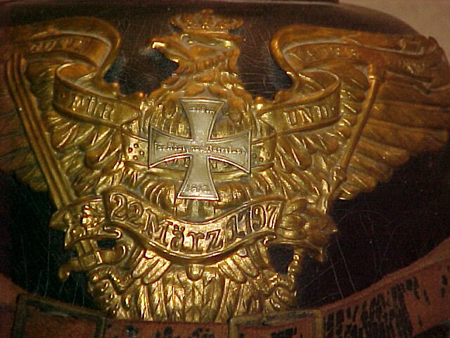
Where Are the Enlisted Landwehr Crosses?
Where Are the Enlisted Landwehr Crosses?
Where Have All the Landwehr Crosses Gone?
Joseph P. Robinson.
3 December 200
This might sound like a song from Peter, Paul and Mary but while I was working on Ersatz things, this kept bothering me. Why are landwehr crosses on enlisted helmets so rare? I am not talking about rare as in almost never seen. I am saying that the numbers do not add up. By all rights there should be a heck of a lot more of these.

Have you ever thought about the numbers involved in the mobilization of the German army in 1914? The Germans initially had a peacetime army of about 700,000 people. Once mobilization began the numbers were a lot larger. Total of the eight field armies; 1,637,000. In addition there were the following other groups. Ersatz Gruppe in Lorraine (6 Divs, 1 Brigade) 120,000. Army of the North (Danish border) 60,000. Border Fortress Commands( very roughly equivalent to 6 Divisions) 120,000. Landwehr Corps 1,2,3,4 in the static defense of Eastern Germany border 160,000.
Total: 1,637,000
120,000
60,000
120,000
160,000
2,097,000 Field Army Requirement.
So in general terms, we have 2,100,000 soldiers split up basically like this:
Active Units : 54% active duty soldiers
46% Reserve soldiers.
Reserve Units: 1% active duty soldiers
44% Reserve soldiers.
55% Landwehr soldiers from the 1st Ban
Landwehr Units: 62% Landwehr soldiers from the 1st Ban
38% Landwehr soldiers from the 2nd Ban
While the exact numbers are not known certain generalizations can be made. Most but not all of the eight armies had existing helmets of one sort or the other. Some of these were older and did not match exactly. There were no existing reserve infantry regiments or landwehr regiments. However, some were formed on an annual basis to support the training requirements of specific corps orders. The key question of this article is: if there were over 2 million soldiers and most of them are either landwehr or reserve; why are landwehr crosses on enlisted helmets so rare?
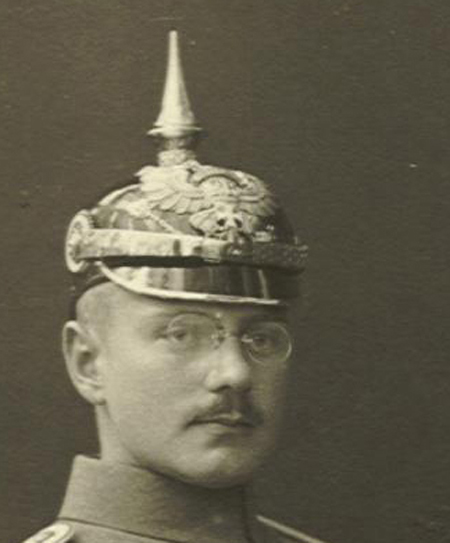
For the officer corps this is not a problem. There were different methods to gain a commission either as an officer of the active force or to get a commission as a reserve officer. Reserve officers would transfer to the landwehr upon their request, and the attainment of the adequate age.
Pictures such as this are common, helmets frequently found, and documentation of unit histories and rank lists abound. It is true that this individual who received his commission in the reserves was not considered an equal to the active officers by their own clique. There were specifically different wappen for Prussian officers of the active, reserve, and landwehr forces. The same cannot normally be said for enlisted soldiers. Understanding these differences in the Prussian eagles is useful. the active eagle looks like this:

The reserve eagle is similar but omits the bandeaux on the wings. These are sometimes used for Beamte without a cross.
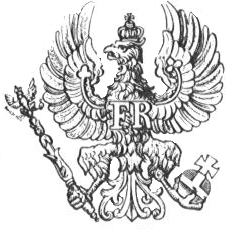
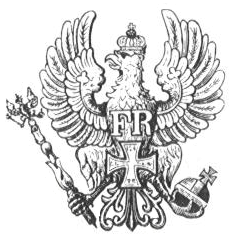 Two key features of this Wappen are the large letters FR a the center of the Eagles chest and the Landwehr cross in a lower position.
Two key features of this Wappen are the large letters FR a the center of the Eagles chest and the Landwehr cross in a lower position.
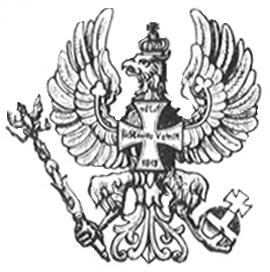 The Landwehr Eagle has no large letters and the Landwehr cross is in the center of the chest or the upper position.while a distinction in Eagle was obvious for officer helmets there was no reserve eagle for enlisted soldiers. Regardless of the eagle, the Landwehr cross should seldom be in the lower position for enlisted helmets. Examples like the picture below exist.
The Landwehr Eagle has no large letters and the Landwehr cross is in the center of the chest or the upper position.while a distinction in Eagle was obvious for officer helmets there was no reserve eagle for enlisted soldiers. Regardless of the eagle, the Landwehr cross should seldom be in the lower position for enlisted helmets. Examples like the picture below exist.
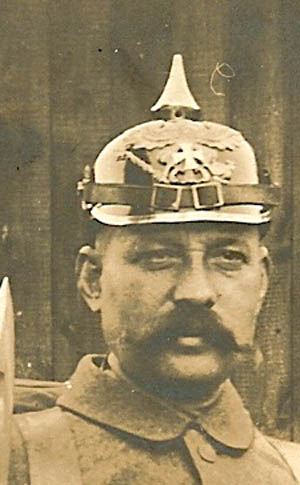
Before the war, reservists and landwehr enlisted soldiers had specific training requirements. They had no helmet at home. In the annual Verordnungsblatt the requirement for a certain amount of soldiers to fulfill the training requirement were published. The Bezirkscommando responding to a tasking from the army Corps district sends out notifications to individual soldiers to report for that years maneuvers. There are no landwehr units or reserve units. So they are created for the exercise. These are called Übungs units. Here is a picture of a 1911 Übungs unit and as usual, they have no landwehr cross on the helmet.
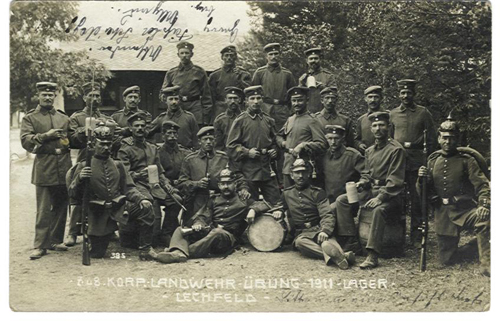
When reservists showed up they were organized into Übungs units and drew their equipment from somewhere. Did the Bezirkscommando have a store? Did the Regiment maintain a stock for training? So what helmets exactly had landwehr crosses on them? What about reserve soldiers filling up active units? If you are a reservist reporting in for your training did the company Kammer have helmets with landwehr crosses on them? A humor book from 1888 tracks induction of any Landwehr Ubung soldier. This gentleman drew his helmet from the company Kammer that was supporting his training. Therefore, he had no Landwehr cross.
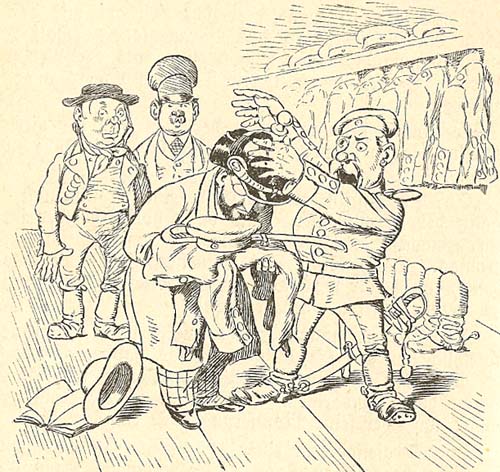
During the war the numbers imploded. Scores of group pictures exist was no landwehr cross. In addition, most pictures that have pickelhaube show them are under a cover. In fact certain War Ministers published directions to use helmets without certain articles or with the wrong color fittings, knowing full well that they would be covered by an Uberzug. Early Uberzugs had markings that could determine a units origin. There were landwehr crosses used by some of the mobilizing troops, and in fact were used on some of the Ersatz helmets like the example shown below.
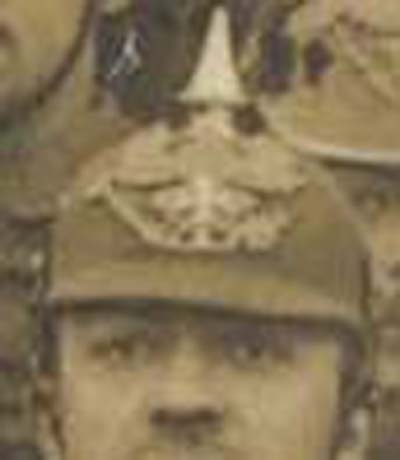
The problem is simple. Based on the number of reservists and landwehr soldiers one would expect there to have been more crosses. Obviously their application was spotty and probably based on availability. Clearly not all of the reservists and landwehr soldiers before or during the war wore the cross. The mysteries continue.
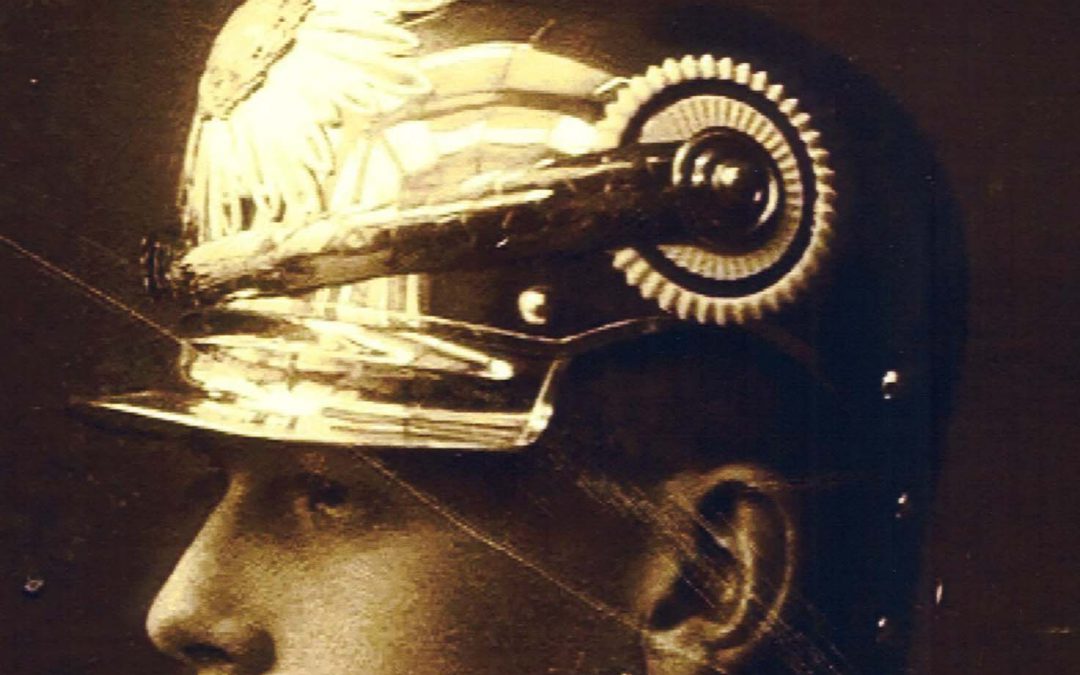
Upgrading Kürassier Helmets
Upgrading Kürassier Helmets
Joseph P. Robinson.
December 1, 2005
Collectors have struggled for quite some time with the upgrading of the steel Kürassier helmets. Only in the last several years has there been an understanding of one year volunteer (OYV), Fähnrich and Fahnenjunker for leather helmets. Metal helmets catch everyone’s imagination, and because officer or steel helmets are so very expensive, few collectors have experience with these. The emergence of the Neumann catalog has improved our understanding of some nagging Kürassier problems.
This photograph from the Trawnik collection shows a Saxon one year volunteer with a number of interesting items on the helmet. First look at the front visor. The one on the picture is known as a step visor. The cockade has no silver ring and it is obviously a 65 mm cockade for someone who does not yet have a portapee. The rosettes are round, not trefoil. The spike base has a round ventilating hole and not the design of the officer’s helmet. The spike is round not fluted. We know that a one year volunteer had to privately buy the helmet so this was not issued. Can/would this helmet be easily converted to officer rank?
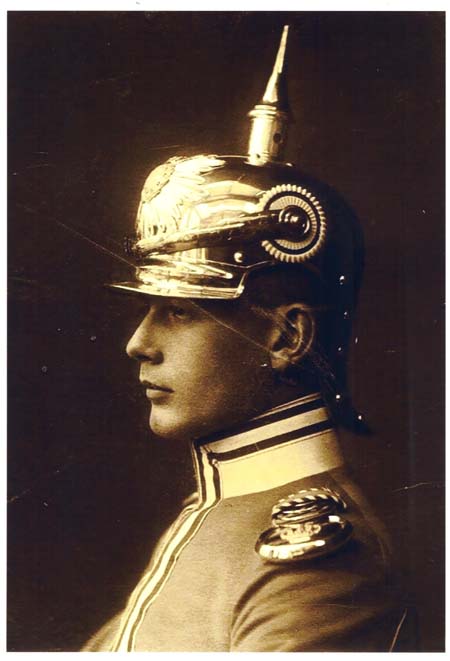
Let’s take a look at the visors.
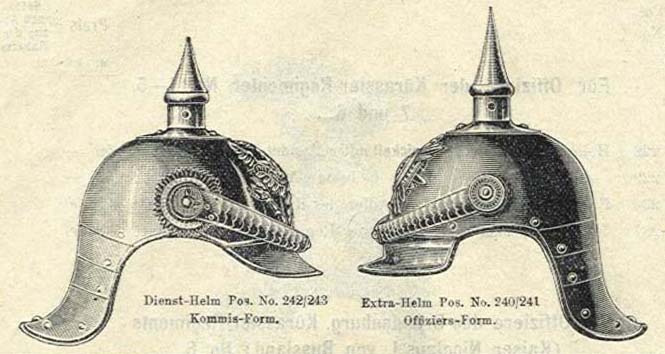
The one on the left is the model 1889. It is known as Kommis-Form. It has a round front visor and the spike is a bit shorter. The one on the right is a model 1867, is known as officer-form, has a step visor, a slightly taller spike, and the back is more straight or vertical. Much discussion in the past has centered on why an 1867 model helmet, would be used after 1889 for lower ranked individuals who had not earned a portapee. Conversely, there was not a lot of photographic evidence about those with a portapee but not a commission. A lot of discussion centered on the wear out date. Surely the older helmet styles would not be discarded, and both styles would serve for quite some time in a unit as the wear out date of a steel helmet must be much longer than the 10 years of the leather helmet. However, the helmet form on the right could be bought up through the Junkers catalog in the 1930s.
Analysis has shown that there were four types of helmets. The last three types were all private purchase helmets. Individuals had to buy them from some sort of retailer. Anyone could do it, including the lowest ranked soldier.
1. Issue helmets, also called Kammer quality. These steel helmets can perhaps best be identified by finding a unit mark stamped in one of various locations around the helmet.
2. Diensthelm. Also roughed steel helmets used by individuals who had to individually purchase a helmet, such as a one year volunteer or a Fahnenjunker. They were rough, identical in many ways to an issue helmet and designed to be used for every day and field duty. These are also called Eigentums helm, extra helm, or extra-Kommis helm
3. A helmet for Fähnrich or Fahnenjunker. This would be a high quality helmet with some, but not the entire galaxy of officer upgrades. The intent was to upgrade this helm to full officer when the individual was promoted to lieutenant.
4. Officer quality helmet. Used by a fully commissioned officers from the rank of lieutenant through Colonel.
Issue helmets were the property of the state. The Reichstag voted the money to buy them., the Reichstag voted the money to replace them.. It was not the intent of the unit or the state for individuals to upgrade an issue helmet. Repairs made to the issue helmet were made by the Bekleidings Instandsetung, a Corps level organization designed to fix equipment. Issue helmets were consistently complained about by the wearer as being heavy, poorly ventilated, and chafing to the skull. Felt pads were placed in the top of many steel helmets to stop them from rubbing the top of the individuals head.
The Diensthelm was something needed by those who could not get an issue helmet and were clearly not officers. A one year volunteer needed a Diensthelm for everyday duties, because the OYV was a low ranking enlisted individual. Some OYV types could be commissioned as a reserve lieutenant after two training periods in the reserve. That is after his year of active duty. Many leather Diensthelms were converted to reserve officer status directly. A few minor changes, add a landwehr cross to the wappen and pop-you had an officer’s helmet. Not all Diensthelms were converted, and clearly it was in the interest of the owner to have as high a quality helmet as he could, if he was going to try to convert it. There were so many changes in the Kürassier helm to make a Diensthelm an officer helmet, that it was generally not allowed.
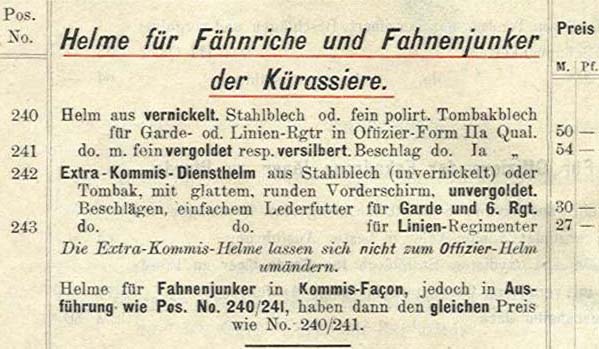
In this catalog there is a clear statement that saying Diensthelm cannot be modified to an officer helm. . It shows the Diensthelm was made out of steel that was not covered in nickel. Chin scales, wappen and other fixtures that were not mercury fire gilded.. It was possible to buy a Diensthelm in either Kommis- form or officer-form.
The helmet for Fähnrich and Fahnenjunker’s was a higher quality helmet that had a nickel finish or a fine polish for the tombak.. You could upgrade the Quality of gilding or silver. These were only available in officer-form and the liners were significantly different and better than the old leather ones. These were fully convertible and upgradable to full officer status. As shown below, the upgrade was dependent upon the original condition of the helmet. Prices were offered in different ranges for instance from 24-27 marks. You could either pay to have it changed over or you could pay much more and have it renovated and changed over. Cockades, rosettes, spike and base, might all be replaced. While this would be a major upgrade it does not seem to be too difficult to accomplish. In the matter of cockades it does not appear as if there was an Unteroffiziere ohne portapee specific cockade for metal helmets. It appears as though it either had a silver ring denoting portapee or it did not. Cockades for these helmets were all 65 mm.
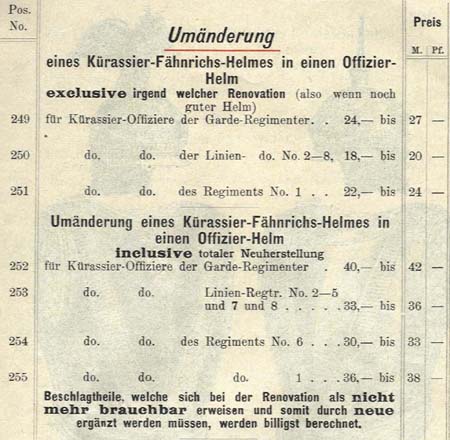
In addition to a total renovation, you could also get parts, fixed. You could get your eagle re-silvered, your wappen or chin scales fire gilded, or a liner installed. The commercial market supported the requirements to keep the helmets in top shape. As a comparison a new line Kürassier officer helmet would cost in the low 60 Mark range.
So the main points of this are (Yes I know this is based on only one catalog):
1. There were four kinds of Kürassier helmets.
2. Diensthelms in Kommis-form could not be converted to officer-form
3. Diensthelms in officer form were not converted (Probably because of the lack of nickel in the shell.)
4. There were three different kinds of. Private purchase helmets that was quite different.
5. Step visored helmets could be bought at any time.
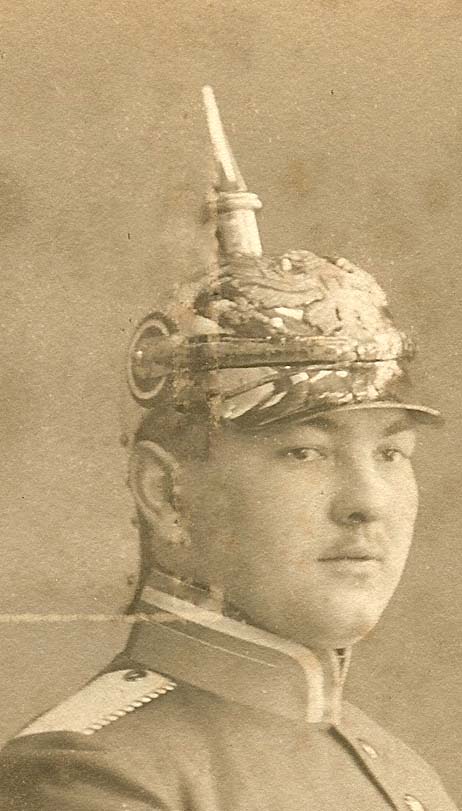
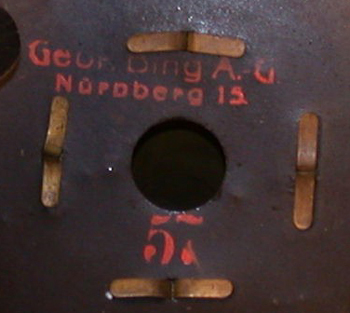
Spiked Helmet Maker Marks
Joeseph P. Robinson
| This concept came out of a list in the old Kaiserzeit Magazine. This current attempt has both pictures and more volume than the old listing. However, it is a work in progress. There is no telling how many errors are in here, duplications or missing parts. There may be quite a few extra makers that are not listed. However we have to start somewhere. So here is a start. Please send your pictures and makers information in and I will post them. This is a common reference. We all will gain from it. The list of contributors is at the bottom. If I forgot to add you it is my fault. Please let me know and I’ll put your name on the list. These are being faked. Especially those stickers. | |
| Aden – Hannover |  |
| Awes Marke (A. Werner & Sohne) –Berlin
Also found on spikes and buttons on rear spines.
|

|
| Babbenfold & Co. — Barmen– B.A.X. | |
| J. Bambus & Co.
Rolled and sewed Filz |
 |
| Hugo Baruch & Cie –Berlin |  |
| May Basch in Luchenwalde —Filz Helmets | |
| W. Becker & Co.– Elberfeld | 
|
| ?. Becker & Co. Berlin |  |
| Max Brückner
Globus Bavarian Inf brass. |
 |
| Carl Billep –Spandau |  |
| Metallwaren Fabrik Gebrüder Bing –Nürenburg — Metal Helmets |  |
| Heinrich Bohlen und Sohn |  |
| Lederfabrik BONAMES Jacob D. Mayer & Co. |
 |
| Firma Ludwig Bortfelt –Bremen (cork) |  |
| A. Burgmaier –Munchen |  |
| Hermann Clemen- -Elberfeld
These are stamped on the underside of the front visor trim. |

|
| Franz Cobau –Berlin
|
 |
| Vorm. A. Cohn — Guben |  |
| Emile de la Croix –Berlin. |  |
| Alexander Dahl Helmfabrik –Barmen, Ritterhausen | 
|
| Damaschke
|

|
| Depaheg Pattent — Fibre helmets
J.B.Dotti This mark is off of a pristine M1857/60.
|

|
| F. & A. Diringer-MÜNCHEN |  |
| M & G DOMPBRTZ???? –Crefeld
On an ersatz oilskin shako
|
 |
| D.O.V. (Deutscher Offiziersverein)
|
 |
| ?Drong????
Provided by Louis Mayer |
 |
| J.M. Eckart — Ulm am Donau |  |
| Ludwig Ess-Ingolstadt
|
 |
| L. Estelmann—Strassburg
|

|
| L. Ettinger –Posen |  |
| Herm. Flohr –Cöln |  |
| öFrster & Co. — Filz Helmets | |
| Gammersbach — Rolsdorf |  |
| W. Gemmlich – Berlin |  |
| Firma Goldschmidt –Luchenwalde — Filz Helmets
Name on support disk |

|
| O. F. Günzrodt –Regensburg |  |
| Emil Hagen |  |
| Hast & Untoff
Dresden |
 |
|
Berlin-Gubener Hutfabrik Stamm.H.Guben
|
 |
| Helbing u. Sackewitz |  |
| Wilhelm Hern –Freiburg |  |
| Firma von der Heyden –Berlin —( kit helmets) | 
|
| Adolph Hoffmann –Berlin
A.PB. Hoffmann–Berlin |

|
| Hohmann & Söhne — Kaiserslautern |  |
| Franz Horg(e)(t) | |
| Inclande (—-st) –Freiburg | |
| Gebr Israel |  |
| Wilh. Jaeger |  |
| Julius Jansen –Strassburg | 
|
| C. E. Junker |  |
| G. Kaernbach — Braunschweig |  |
| Zerbe & Kaufman — Mannheim |  |
| Kern, Kläger & Cie — Neu Ulm | |
| —-Kleinheinz –München |  |
| A Klucke |  |
| KRUMMELBEIN & CO GMBH LUCKENWALDE LIEFERUNG 1915 |  |
| Lachmann –Berlin |  |
| Seb. Leberfing — Munich |  |
| Karl Leburg –Straussburg | 
|
| Firma Lembert–Augsburg | |
| J.G. Lieb & Söhne — Biberach | 
|
| Berthold Lissner –Guben |  |
| S. Lubung Strassburg im Elsass | |
| Verkaufskontor Luckenwalder Hutfabriken |  |
| Ludwig & Co. — Frankfurt | 
|
| Maller & Co. | |
| Marke Guarde du Corps |  |
| Mars-Orient |  |
| Maury & Co
Offenbach am Main & Mainz |

|
| Martin Mayer –Mainz |  |
| Mohr & Speyer –Berlin | |
| Mühlenfeld & Co –Barmen |  |
| _Müller–Chemnitz |  |
| H. Muller & Co. –Offenbach a. Main & Stuttgart | 
|
| Mathias Müller –Liepzig | 
|
| Müller & Sarung — Dresden |  |
| Otto Nachtigall –Berlin |  |
| M.A. Neumann –Konigl. Hoflieferant –Berlin W. | 
\ |
| J. G. Nieb Sohme– Biberach |  |
| Karl Negele | |
| A. Nolden |  |
| Oekonomie Kunstinstitut –Berlin | 
|
| G. H. Osang –Dresden
These are stamped on the underside of the front visor trim. These are also found in the roof of the helmet near the spike on later Saxon metal models. |
 |
| Prima Qualitat |  |
| Rabat & Guttmann — Breslau |  |
| Gustav Reinhardt–Berlin
|
 |
| Mitteldeutsche Gerberei & Riemenfabrik– Neu Isenburg
|
 |
| L. Ritgen –Karlsruhe iB (im Breisgau)
|

|
|
Gustav Röhricht- Berlin
|
 |
| Hans Römer –Neu Ulm |  |
| Rumler — Breslau |  |
| Eduard Sachs –Berlin | |
| M. Schambeck– Konigl. Bayer. Hoflieferant | |
| J. M. Schart (?) — Ulm A. B. |  |
| Fr. Schlemmer –Kaiserslautern |  |
| Schletcher Compagne | |
| A. Schmidt –Leipzig
|
 |
| L. Schmidt-Rauch–Darmstadt |  |
| Carl Schneider –Brieg |  |
| Firma Schulhof –Berlin — Filz Helmets | |
| Ed. Schultze –Potsdam |  |
| Schulz & Holdefleiss –Berlin N. |  |
| Martin Schumacker –Stuttgart |  |
| Schwarzenberger & Co. –Nurnburg |  |
| Schweitzer–Munich |  |
| Ernst Siegemund –Dresden |  |
| Siemens-Martin-Stahlblech — Metal Helms | |
| C. A. Stahle–Stutgart |  |
| Moritz Stecher– Freiburg-sa | 
|
| Instandsetzung Stecher — Freiburg
Possibly the repair facility of the maker listed directly above. |
 |
| Johannes Steinberg– Berlin
East Africa Sun Helmet. |
 |
| —- Steinmetz –Breslau | 
|
| L. STROHMEYER & Co- KONSTANZ |  |
| Bruno Sturm –Guben | |
| Suum Cuique |
|
| Vereingte Textilwerke GMbh –Berlin W9 Vodstrade | |
| Carl Trenner –Berlin Tempelhoff |  |
| Actien Gesh. Thiele — Dresden | 
|
| F.H. Thieme –Magdeburg | 
|
| Robert Upleger– Danzig | 
|
| Hast & Uhthoff — Dresden |  |
| L. Verch — Charlotenburg
|
 |
| Wilhelm Voigt –Magdeburg | |
| Herm. Weissenburger & Cie. –Canstatt |
 |
| GmbH Wetzlar |  |
| Rudolf Wiener |  |
| C. G. Wilke –Guben |  |
| Rudolf Wismar–Elberfeld |  |
| C. Henke Witterr |  |
| A. Wunderlich –Berlin
|
 |
| A Zinna –München | |
| M. Zoltsch — München |  |
| Unsolved Examples | These are marks that have been found but are not readable. Any help is appreciated! |
| The first two words are Deutsche Helmfabrik
then??????? |
 |
| Prussian M95 OR |  |
| Schwaben?????? |  |
| Prussian M95 OR |  |
| Prussian M15 OR |  |
| Prussian M15 OR |  |
 |
|
| Contributors include:a person who prefers not to be named, whom we shall call Mr. X., Amy Bellars, Mike Huxley, Randy Trawnik, Ron Levin, Max Chaffotte, Tony Schnurr,Chip Minx, Michael Hyman, James LeBrasseur, Reservist1, Charles Booth, Brian Loree, Danny Watson, several annonymous ebay donators who gave permission, Gus Bryngelson, Rebecca Copple, Dave Carlson, Dave Mosher, Mick Edwards, Tony Cowan, David Zeller, Mark Avery, Mike Freiheit, John Mordini, Mike Prictor, Scotties Guns and Militaria, Tim Quinlan, Tammy Venne, Kieth Gill, Stu Williamson, Belginator, Robin Lumsden, Geri Neumann, Steve Russell, Karl O. Salvini,Martin Vear, Denton Walter, Karel Van Bosstraeten, Roy A., Daniel Leroy, Andy Archer, Chuck Liles, Philippe Quesnay, Robert Hinsley, Denton Walker, Bob Jones,Jeroen Meijer,Ronny J. Kastoun, Chris Hanson, David Milo, M. Buchner, Laurent Mirouze, John Mann, | |
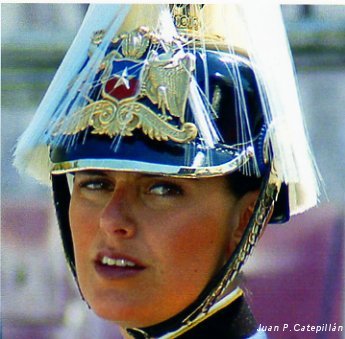
Latin American Pickelhauben
Any additional information about this matter, will be duly appreciated.
My email is :
ricardojarafranco at gmail.com
http://www.youtube.com/watch?v=VfBnQWD9IIQ
Ricardo Jara Franco
August 18, 2011
|
CHILEAN SPIKE HELMETS Chile is probably the last country in the world to dress and parade in the old Prussian-style. The Regulation of Uniforms of 1898, and the Ordnance from February 06, 1905, put an end to almost two centuries of French influence in the Chilean uniforms and military instruction system. The Chilean Army now appears in all the splendor of Spiked helmets and under the influence of old Prussia. This influence remained stronger in the Chilean Armed Forces, but especially in the Army, compared those of other Latin American countries. Also, Chile has exercised a strong formative influence on the Armed Forces of others countries in the area : The Armed Forces of Colombia, Ecuador, Venezuela, Honduras and El Salvador have come under the tutelage of Chilean military missions, in some cases for very long periods, and others countries have sent military personnel for post-graduate training in the Military Schools, and for experience with units of the Chilean Army. The Prussian ceremonial uniform is not a contradiction to the NATO standard that Chile pursues for their Armed Forces nowadays.
The Director of the Military Academy (Colonel), his Staff and the Flag-bearer with gorget. How strangeit is to see an officer dressing as the ” I. Garde-Dragonen-Regiment Königin Victoria von Grosbritannien und Irland” or cadets dressing in the uniforms of the “Grenadier-Regiment König Friedrich Wilhelm II Nr.10” , in 2011! Picture: Hutzcruffe. http://www.youtube.com/watch?v=l26FSmsISnw The first pickelhaubes appeared in 1900, in the “General Bernardo O’Higgins” Military Academy, School of NCO of the Army (Escuela de Clases), War Academy, and in the Squadron of Cavalry of the Presidential Guard, in the parade formations and in guard’s service. However, in 1879, the “Chacabuco” battalion used a lot of pickelhaubes that were originally Peruvians but captured by the Chileans, in the war of 1879-84 against Peru-Bolivia (Pacific War). However, these helmets didn’t participate in battle being relegated to police activities. These helmets amazingly still carried the German Imperial eagle, and were model M/1867.
“Chacabuco” Civic Battalion (stationed in San Bernardo, 1879), carrying Prussians helmets confiscated from the Peruvian State during the Pacific War ( 1879-1884 ) – with their original Prussian badge. Picture : Coll. Gen. Roberto Arancibia Clavel.
Engineer Domingo De Toro Herrera, Commandant of the 6th Line Infantry Regiment ”Chacabuco” next to a soldier wearing a pickelhaube captured from Peru, 1879.
After 1899, Germany and Austria manufactured Spiked helmets dedicated to Chile regularly. The shape and model were similar to those of the Kaiser Army (pattern 1891 and 1895),used by the Prussian Garde Regiments.
Pickelhaube used by the Army (Enlisted Men’s Helmet), with this first helmet plate, and then dedicated exclusively to the Military Academy. Coll. Jean-Manuel Torti.
Above left: Uniform of a Major from the Chilean Army, with square visor helmet and the helmet plate, prior to 1905. Right: Cavalry Captain, from the Military Academy- round visor, with a helmet plate, post-1905 (with silver metal).Coll. Raúl Yáñez M.
First lieutenant Vicente Villalobos, picture taken at the Cavalry-School in Hannover, Germany, 1903. The Imperial eagle plate was replaced by a very similar one specifically made for Chile. Starting in 1905, the national coat of arms was made in Germany, and later on in Chile. This emblem was adopted in 1824, and changed with their motto in 1854 by the Army; it represents the Chilean national emblem: a huemul – Hippocamelus bisulcus – (small fawn, today in danger of extinction), and a condor, contouring a bicolor shield with the slogan: “Through reason or Forcer”, in Latin: “aut consiliis aut ense”. During certain periods this motto was replaced by the sentence “Republic of Chile “. From the 1970´s on, the front plate uses the original motto, which is the official slogan of the state of Chile since 1920.
Army square visors Spike helmets. The artillery helmet has the cockade on the right side only, the Infantry and Cavalry helmets possess both. These models definitively disappeared, in between 1924 to 1927.
Army’s square visor Helmet, with white horsehair parade plume (1905 to 1927).
Left: Cavalry helmet (Enlisted Men’s Helmet), used up to 1924-27, with silver metal: The other branches used brass metals. Right: Prussian Spike Helmet and Chilean Infantry Helmet, same period, NCO model (used chinscales, with M/1891 side post).
Chilean Captains Arturo Ahumada B. ( Artillery ) and Diego Guillén Santana ( Infantry ), reformers of the Colombian Military Academy, 1907-1909.
The same Officer of the previous picture, General Arturo Ahumada Bascuñan (1872-1955). See the officer’s medals, obtained in Germany between 1914-1917.
Left: “Through Reason or Force” Right: “Republic of Chile “. The Military Academy adopted a brass eagle with imperial crown as its emblem (First Model)!! An imperial eagle is rare to see and a very sought after item for collectors and museums alike. There is a white metal foil that simulates the feathered neck of a condor, with its deployed wings that has in its claws a grenade and a sword. On it’s chest is a silver star, and the slogan “Through Reason or Force “.This exclusive model of the Military Academy was in use from 1900 to 1927. The helmet was replaced in 1927 after the railroad tragedy of Alpatacal. During a trip to Argentina the helmets and their emblems were almost totally lost in a fire that also took the life of twelve people, including the Director of the Academy. The helmet was replaced by similar helmets to those that had been used by the rest of the army since 1905 with the Chilean coat of arms on the front. The only difference was the round visor used exclusively by the Military Academy, while the rest of the Army used a square visor.
The first helmet emblem used by the Army up to 1905 and by the Military Academy up until 1927 (Officer’s Helmet M/1891) . Coll. Raúl Yáñez M. Infantry Major of the 1st Infantry Regiment “Buin”, prior to 1905.Coll. Raúl Yáñez M.
General´s helmet, post-1905, with parade feather plume.
“General Bernardo O’Higgins”, Military Academy on parade. Picture taken in December 23, 1915.
Student of the Non-Commissioned Officer School (Escuela de Clases), 1906.
Military Academy departing for Summer’s maneuvers, 1907.
Cadets participating in infantry maneuvers, September 07, 1909. Infantry instruction with Mauser rifle ( ”Pudeto” Regiment, 1903-1906) Picture: Coll. Lt. Col. Edmundo González S.
Artillery Lieutenant in parade uniform, picture taken in February 20, 1917. Valparaiso. Coll. Raúl Yáñez M. Chilean Cuirassier Helmet
Chilean Condor for Cuirassier helmet: Brass color for the Cavalry School (with spike), and silver for the Presidential Escort (with wing-spreaded condor on top).
Beautiful and rare Cuirassier type helmet, used by the Chilean Army (Cavalry School). These were only used for big State ceremonies between1900 to 1930. This helmet, belongs to John Mordini ´s collection.
Cavalryman of the Cavalry School, in orderly uniform. The picture taken Circa 1912, clearly shows the Cuirassier helmet M/1889-94. In front: Private from the “Carabineros” Regiment (belonging to the Army), around 1920, which in 1927 became the National Police nucleus. Picture: Carabineros de Chile Museum. Behind: Cavalry Squadron (from the Cavalry Regiment Nr.4 “Escolta”) , on duty as Presidential escort, in front of”La Moneda” (Presidential Palace).
Officer and Non-Commissioned Officers (NCO) from the” Carabineros” Regiment, Guards of “La Moneda” Presidential Palace (House of Government), Ca. 1918.
From 1940 up today, this Cavalry Squadron (Presidential Escort) maintains the old uniform of the Regulation of 1940 (O.C. N° 89, April 11, 1940). For troops as in Figure A, carrying a model M/1891-96 Chátellereault J.H. (M.A.C.) saber, and for Officers (from 1984 to 1998) ,as in Figure B, with Prussian helmet (Note the presidential badge to the right side, at the height of the fifth button ).
The Chilean Army, discontinued the use of the spiked helmet in August of 1924.The last official use was for the parade that was organized in honor of Prince Humberto of Saboya, in the actual O’Higgins Park (early Marte field), nevertheless the helmet was used for a few years more, circa 1927, in the provinces.
Left: Model used by the Military School, from 1927. In this case, uses the “long spike” and the round visor. Right: present model, made of leather, with artificial hair and cone spike.
In 2006, the Austrian company responsible for providing leather helmets to the Military Academy ceased production. Chile then began to buy in Eastern Europe to fill the needs of the army, but now all the parts and brass pieces are locally produced.
Left: nspiked helmet of the Parade Band. Right: Spiked helmet used by Cadets and Officer. Both hairbush are made of horsehair. An experimental fiber spike helmet was tested during the 90´s. It was not accepted as it did not match the leather helmet in ventilation and weight. But probably this rejection was more heavily based on tradition and historical background. Ecuador, Venezuela, Bolivia (Anapol) and Colombia use fiber helmets.
Experimental fiber pickelhaube.
Left: Liner of an experimental fiber helmet. Right: Liner of an actual leather helmet.
The same hairbush as the previous ones, but with artificial hair (1960).
Left: Detail of the hairbush mount and round base. Right: Details of spikes used in the helmets of the Military Academy. Spike of “Cone” ( 84 mm. ), “Short” Spike ( 82 mm. ) ,” Long” Spike ( 91 mm ), and Cavalry Spike ( NCO, 73-90 mm ) . The Cone Spike is used at the present time .During the use of the Spike helmet by the Army (1900-1924), the troops used a short spike, and the Officers a long one. RED HAIRBUSH Corps of Drums and Fifes of the Military Academy (formed by Cadets), 1907. To the left, Major Günther von Below, German instructor.
Fanfare section of the Military Academy Band, 1949. Picture: Magno Lazcano C.
Corps of Drums, Fifes and Bugles of the Military Academy with Prussian swallow’s nests and Academy Schellenbaum (or “Jingling Johnnie “), 2007. With a Drum Major : http://www.youtube.com/watch?v=1mU7gL_m20I&feature=related With a Bugle Major : http://www.youtube.com/watch?v=idKT3bycxS8&feature=feedf Military band during parade practice : http://www.youtube.com/watch?v=In0Kj-ARaZA&feature=feedf http://www.youtube.com/watch?v=jUwhmacL8R0&feature=feedf
OATH OF ALLEGIANCE TO THE COLORS
Oath of allegiance to the colors, Officers of the 8th Cavalry Regiment “Exploradores”, Antofagasta, 1921.
Military cadets make their oath of allegiance to the colors. 2007 DETAIL
Director of Military Academy (Colonel) with his special Spike helmet, with parade feather plume. This helmet is exclusive to the Director, thus it is very desirable and scarce, for collectors.
Chin scales detail (brass scales, 16-17 or 18) and cockade with ring, locally produced.
National Coat of Arms.
Parade funnel detail, and shoulder boards of Officer ((2nd lieutenant). Picture: Juan P. Catepillán Flag-bearer of the Military Academy. CARABINEROS DE CHILE ( CHILE´S NATIONAL POLICE FORCE )
Second lieutenant of Carabineros de Chile Humberto Reyes Rojas, 1929, picture taken in Tacna, Peru. Picture: “El Mercurio” journal. Right: Officer Spike helmet from Carabineros de Chile, National Police since 1927.Carabineros de Chile Museum.
Carabineros Helmets, from 1908 to 1930. Picture: Carabineros de Chile Museum.
Captain Larrain. Guard of Presidential Palace (Carabineros, 1920), with a beautiful pickelhaube with a condor of deployed wings. MEMORIES
Left: Artillery Major in Parade uniform, with artillery ball, 1905. Right: Officer of the 3rd Artillery Regiment “Chorrillos”, ca. 1910.
Left: General in parade uniform, 1905. Right General Sofanor Parra Hermosilla, with parade feather plume. Picture taken circa 1912. Illustration: Cavalry Lieutenant and Regimental Adjutant, in parade uniform 1905, with the adjutant’s belt worn over the shoulder. Picture: Cavalry Captain from the Military Academy, with M/1891-96 Chátellereault saber Coll. Raúl Yáñez M.
Left: Engineer Colonel, 1905. Right: Engineer Second lieutenant. Picture taken circa 1915.
Left: Infantry Lieutenant, in Parade uniform, 1905. Right: Infantry Lieutenant Julio Franzini (in Ecuador from 1901 up to 1906), with the First model helmet plate, 1904. Left: Cadet, Military Academy, 1920. Right: Cadet, 1920. ARGENTINEAN SPIKE HELMETS 1910 – 1924
Cruciform spike base and fluted spike for Argentinean General’s helmets. Illustration: ”Reglamento de Uniformes Militares de Argentina, de 1912”
Cadet Juan Domingo Perón, 1911.
Infantryman of the 3rd Infantry Regiment, wearing his Model 1910 pickelhaube (with leather chinstrap).Coll. Raúl Yáñez M. Uniforms of French influence with German pickelhauben. From : “Evolución de los Uniformes Militares Argentinos” by Major (Argentinean army) Sergio O. H. Toyos
Cavalry Officer’s helmet with round base and plain spike, 1910-1924. Coll. Wilson History and Research Center.
Argentinean Non-Commissioned officers ( NCO) Spiked Helmet, 1910
Left: Corporal of the 2nd Line Artillery Regiment, 1911. Illustration: Eleodoro Marenco, 1966. Right: Officer of the 1st Line Artillery Regiment, 1912. Coll. Raúl Yáñez M. BOLIVIAN PICKELHAUBE
Bolivian Police Academy (Anapol) , with avocado hairbush.
Bolivian Police Academy: “Academia Nacional de Policia “(Anapol). Officers and troops, on parade formation.
Bolivian soldier, Ca. 1930. |
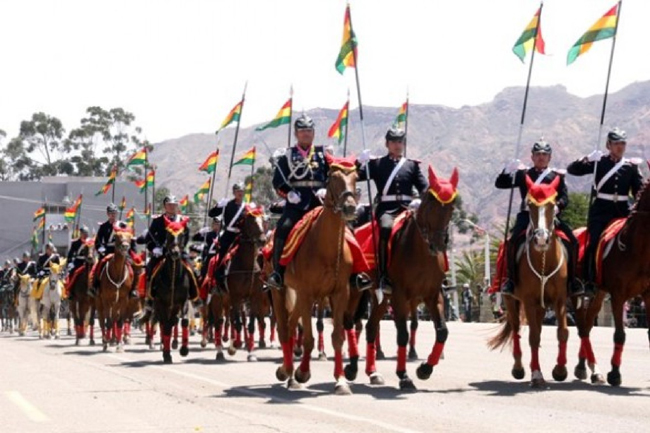
Officers and troopers, on Presidential Escort. 2010. Foto: Venemil.
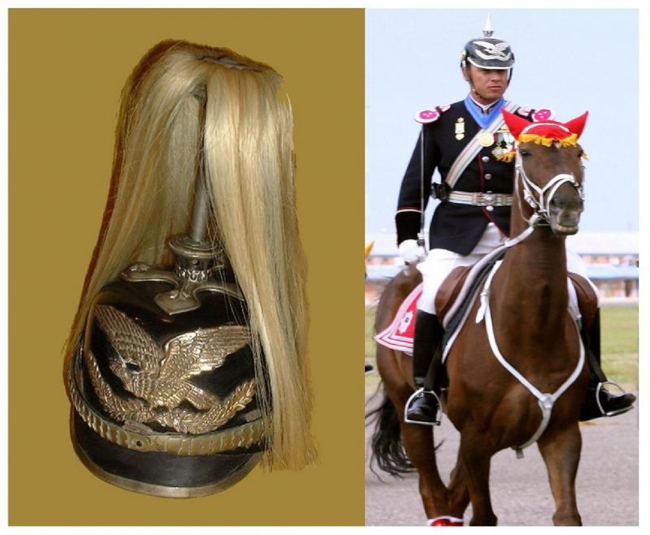
Helmet of the Bolivian Military Academy “Colonel Gualberto Villaroell“. Made by WKC ( Weyersberg, Kirschbaum & Cie., Solingen, Germany )
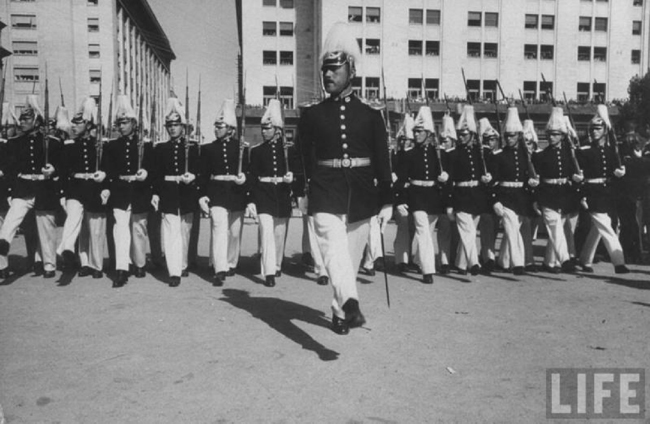
Bolivian Military Academy. Ca. 1950
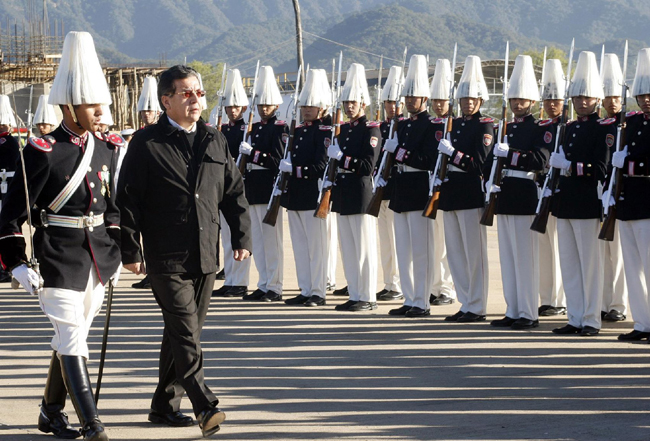
Bolivian Military Academy “Colonel Gualberto Villaroel“.
http://www.youtube.com/watch?v=A2Lf_L_h9HY&feature=related
High School marching bands
http://www.youtube.com/watch?v=3SR5BCczTtI&feature=feedf_more
BRAZILIAN PICKELHAUBE
1889 – 1928
Their use began in 1889, with some distinctive modifications in 1890 and 1894. The Brazilian helmets show a Portuguese heritage with the style of the front badge, accessories and decorations; their uniforms, are a very interesting blend of French, British and German military fashion. 1903 was the final year for the Brazilian Army spike helmets. They were in use with Police Corps and Firemen until the year 1928.
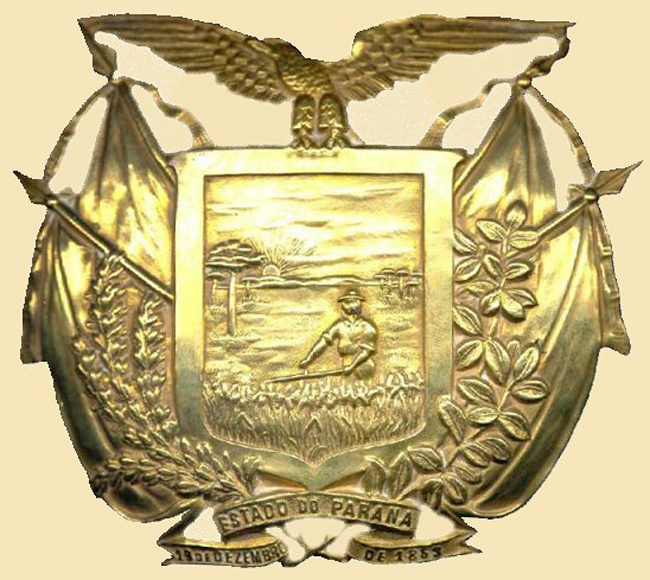
Old helmet plate of the Military Police of Paraná, “Regimento de Segurança”, 1913

Assorted models used by Brazil. Wikipedia (Guilman).
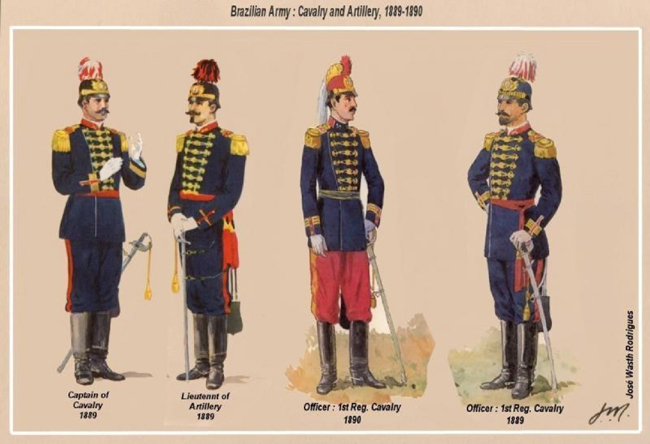
Officers of the Brazilian Army, between 1889 and 1890. Illustration: José Wasth Rodrigues.
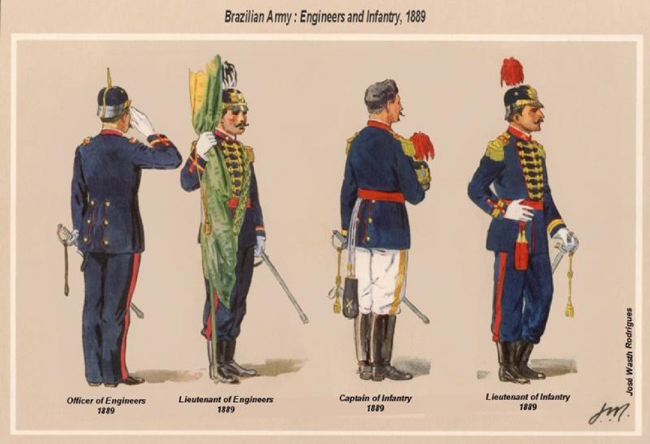
Officers of the Brazilian Army, 1889. Illustration: José Wasth Rodrigues.
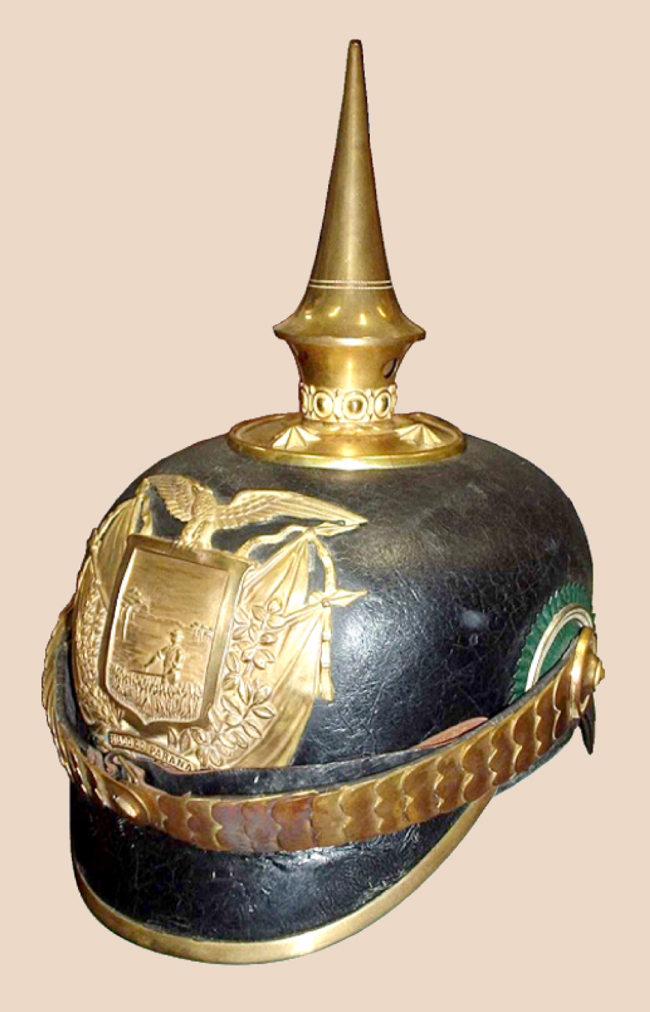
Pickelhaube of Military Police of Paraná State, Brazil, 1913-1917. Picture : Wikipedia ( Portuguese )
COLOMBIAN SPIKE HELMETS
1907 – Present-Day
The use of the pickelhaube, begins with the great restructuring of the Colombian Armed Forces of 1907. At that time a Chilean military mission imposed the use of the Prussian spike helmets, that has survived until the present. In Colombia, the spike helmet enhances the presentations and parade of the Military Academy, Guard Battalion of the Presidency (Presidential bodyguard), the Police Cadets School and some High School marching bands.
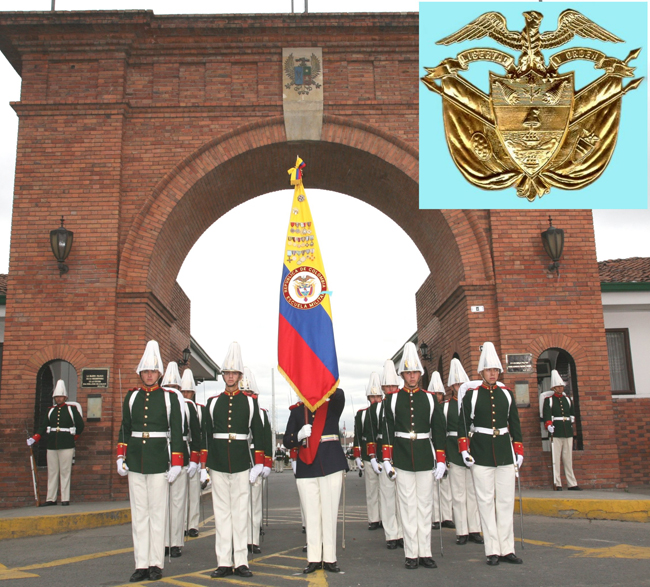
Military Academy (Escuela Militar de Cadetes) “General José María Córdova“ founded on April 13, 1907 (Decree Law N° 434).
http://www.youtube.com/watch?v=T4M9Z1ZuUdY
http://www.youtube.com/watch?v=fBIFQuCuIBI&feature=youtube_gdata_player
Military Academy Band, playing an old Chilean march : “ Adiós al 7° de Línea” ( Good-bye to the 7th of line )
http://www.youtube.com/watch?v=69v_EqZTjiA&feature=youtube_gdata_player
The Chilean original version.
http://www.youtube.com/watch?v=dsHVaWxAXUQ&feature=youtube_gdata_player
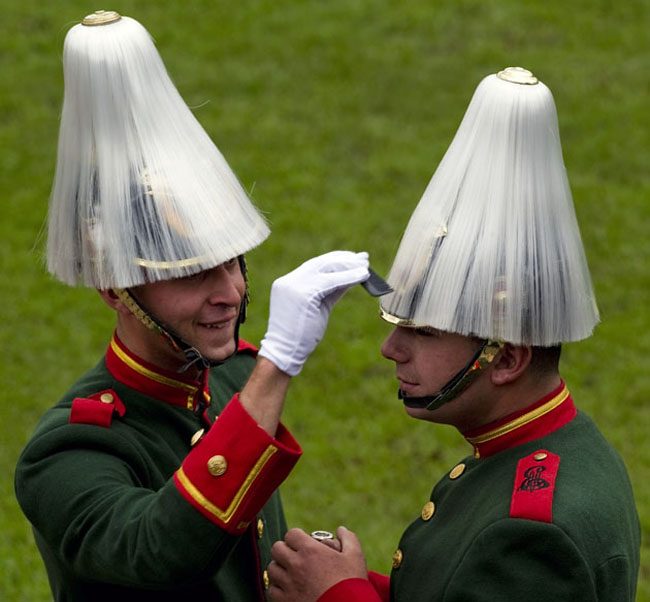
Cadets belonging to the Colombian Military Academy.
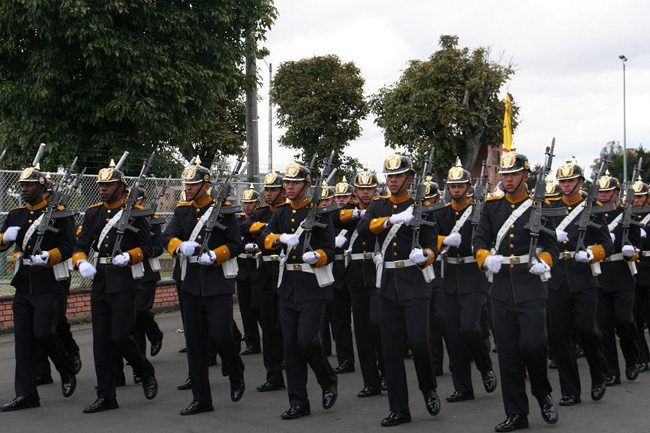
Guard Battalion of the Presidency (“Rondón” Cavalry Company), created on August 16, 1928.
http://www.youtube.com/watch?v=0u1bM3wJADc
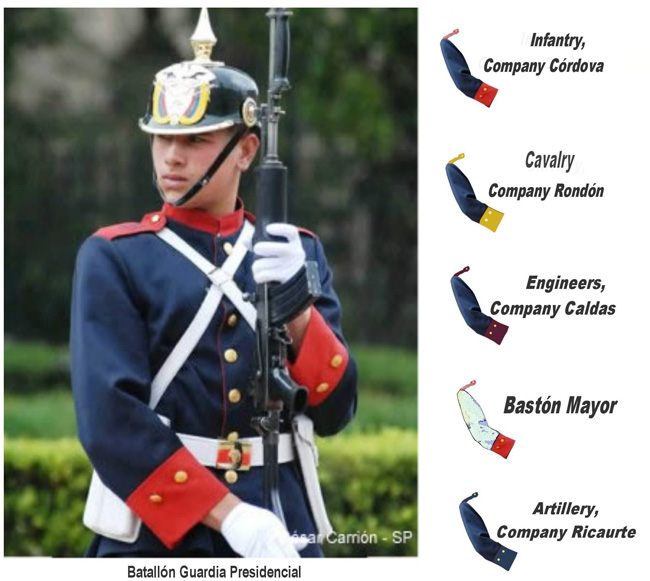
Guard Battalion of the Presidency (Infantry Company” Córdova”).
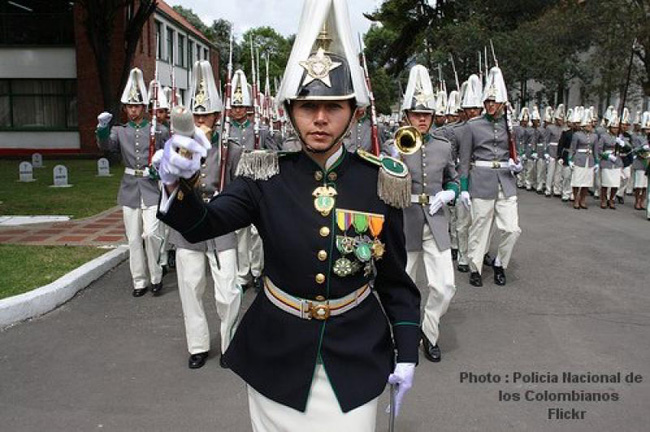
Cadets and Officer of the Police Academy ” General Francisco de Paula Santander”.
Parade in a rural area :
http://www.youtube.com/watch?v=RYm7ItG3HYk
High School Marching Band, playing an old Chilean march : “ Adiós al 7° de Línea” ( Good-bye to the 7th of line )
http://www.youtube.com/watch?v=0Mf4IESY8vI&feature=feedf
ECUADORIAN SPIKE HELMETS
1907 – Present-Day
A Chilean military mission begun the adoption of the Prussian instruction and uniforms for the Army of Ecuador in 1903. The Regulation of January 10, 1907, made it standard for the Army and the Military Academy. The cadets of the Ecuadorian Military Academy “Eloy Alfaro” has kept this tradition until today. The current helmets are made of fiber and they possess two lateral vents on each side.

Military Academy Cadets from “Eloy Alfaro” Military Academy. Picture taken in 1911.
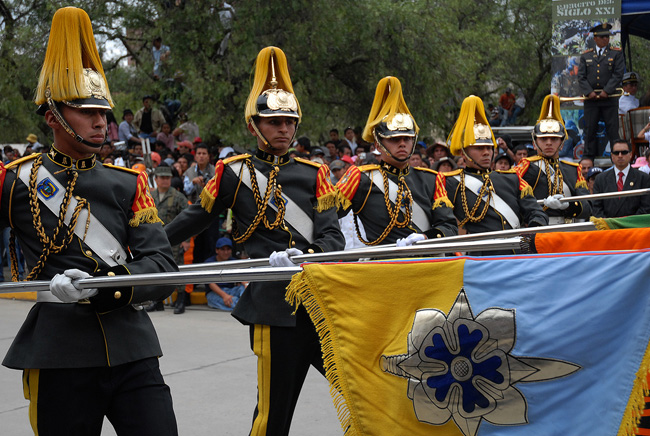
Cadets carrying the pennant from the “Eloy Alfaro” Military Academy, with yellow hairbush.
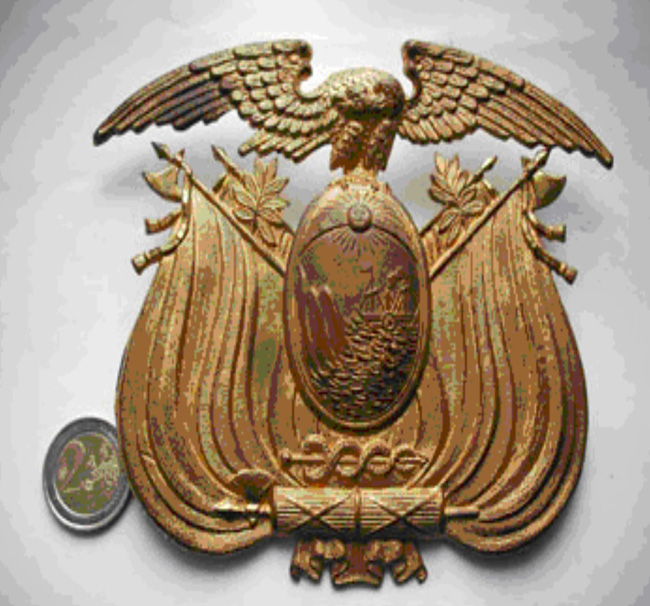
Front badge of Ecuadorian Prussian helmets.
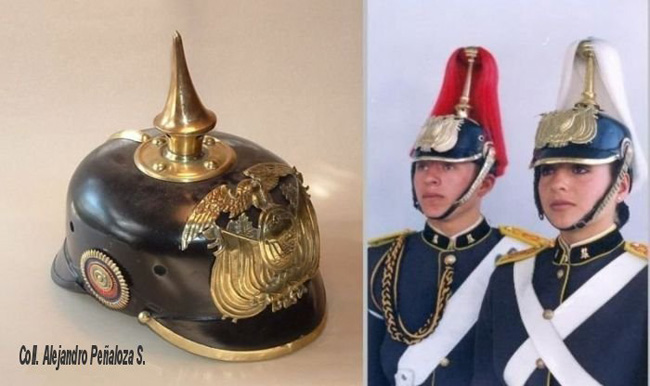
Fiber helmet of the Ecuadorian Military Academy. Note the lateral vents.
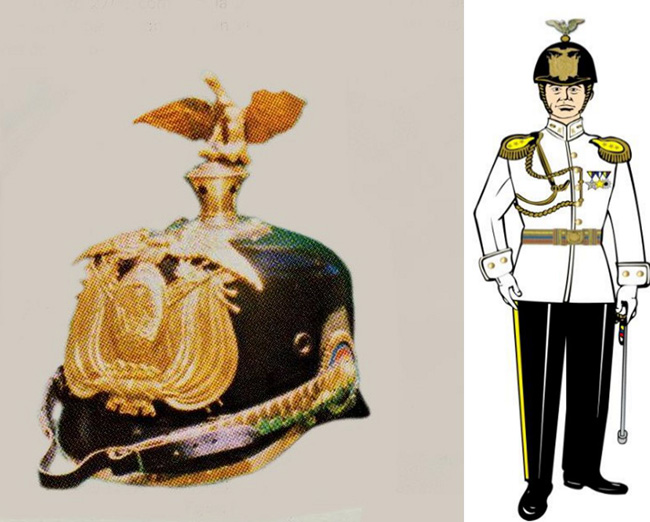
The“Great Parade” fiber helmets, used by the “Eloy Alfaro” Military Academy Senior Officers. The Staff officer graduates use golden condor helmets (Left), the officers without title (General Staff), use helmets with silver color condor (right). Ecuadorian Army Uniforms Regulation 2007, article 50.
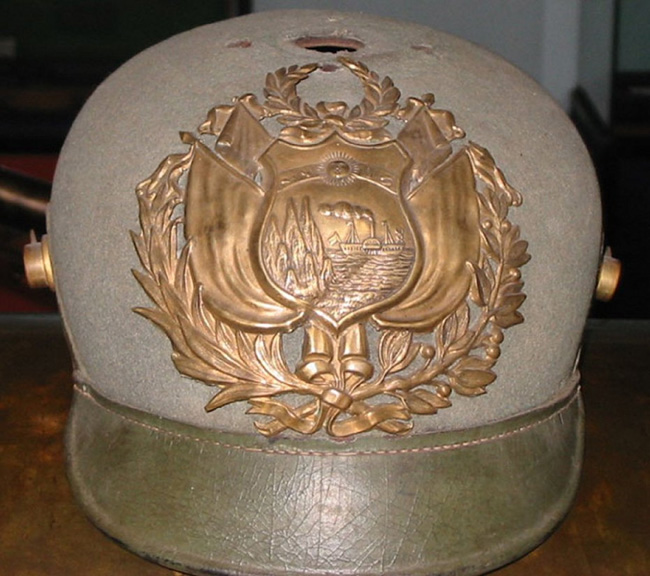
Helmet from Ecuador, this one is different to the above samples and it is similar to the 1848 original model. Sent by Eduardo Espinoza
http://www.youtube.com/watch?v=vXSZXWuVJh4
http://www.youtube.com/watch?v=Kq8cA6zu_70&feature=youtube_gdata_player
EL SALVADOR SPIKE HELMETS
1901 – 1927
In 1890 a German Military mission was hired by the Salvadorian Army, being reinforced later by a Chilean military mission, which operated in the country from 1903 to 1909 and from 1951 to 1957. The Prussians helmets are a sample of this influence.
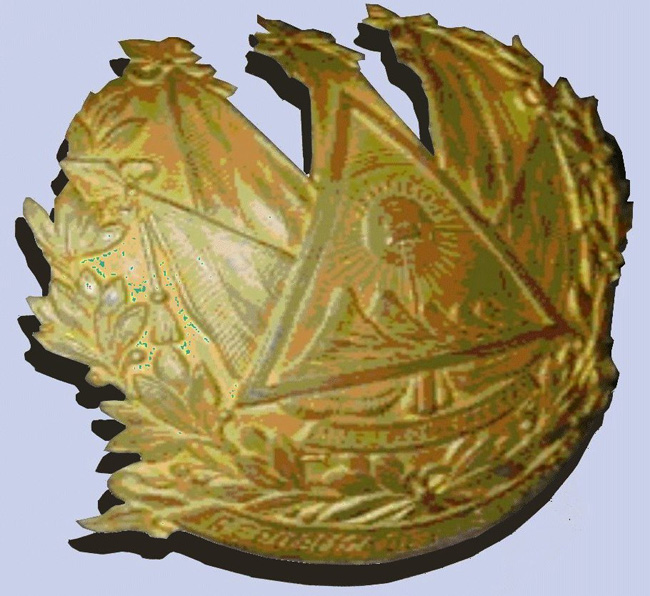
Front badge of spike helmets of El Salvador.
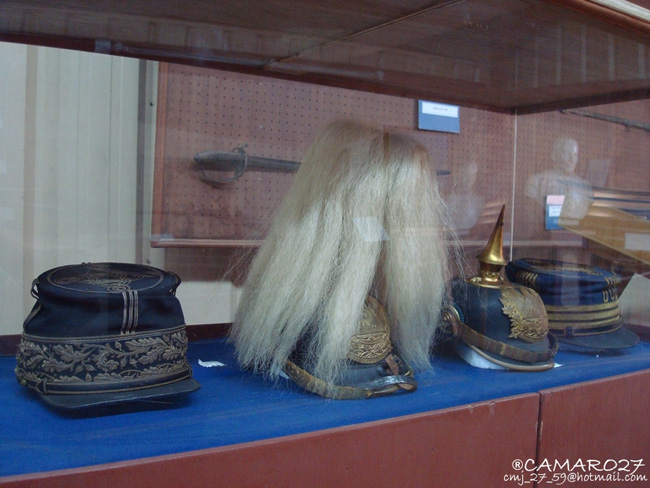
M/1895 Prussians helmets, in the “Museo de Historia Militar” of El Salvador. Picture: Mr. Carlos Rodriguez Mata
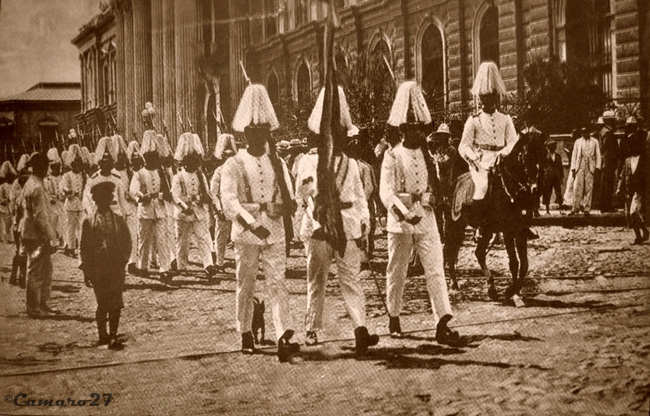
A group of Cadets from the Military Academy, in front of the “Palacio Nacional”, City of San Salvador, El Salvador, 1924. Picture: Mr. Carlos Rodriguez Mata.
HONDURAN SPIKE HELMETS
1904 – 1912
The Military Academy of the Army of Honduras was organized in August 31, 1904 (Law Decree Nr. 56), by the Chilean Captain Luis Oyarzún, which introduced the use of the pickelhaube among the Officers of the Army.
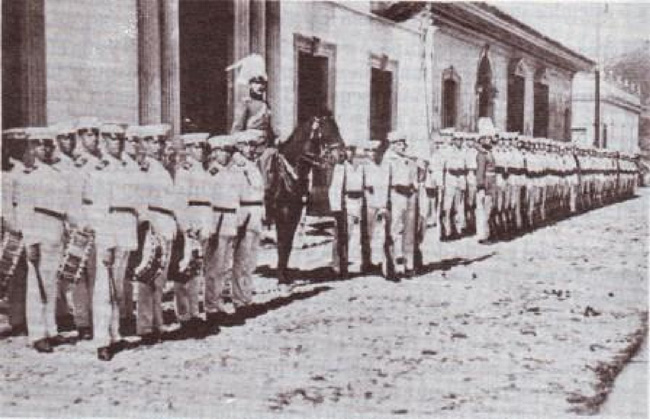
General Abel Villacorta, 1908. Picture : “Dirección de Historia Militar, de las Fuerzas Armadas de Honduras”
MEXICAN SPIKE HELMETS
1905 – 1910.
The Mexican pickelhauben had a very brief existence. It was born under the Porfirio Diaz Presidency, and the Uniform Regulation of 1905. It was a curious mixture of German, French and British military fashion, and was made obsolete by the Mexican Revolution in 1910. Nevertheless it was only eliminated by the Uniform Regulation of Sept. 1919, and it persisted in some Military Schools until the mid-1920’s (for example, in the Infantry School). It was only employed by Officers of higher grade, the Cadets of the Military Academy, and the Military Schools, that is the reason why the scarce helmets that exist today are of extraordinary quality.
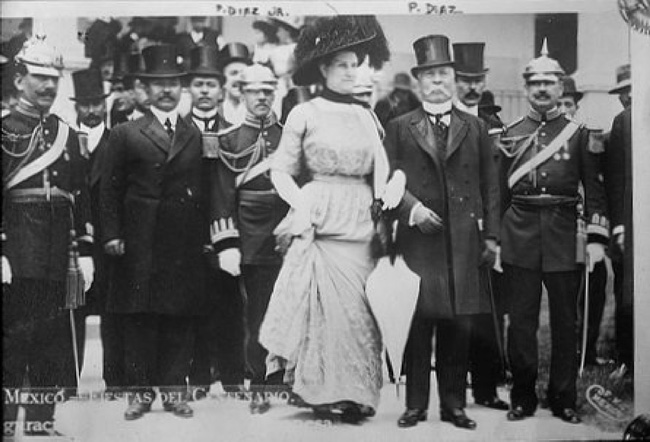
Picture from the Centennial of Mexico. Officer Porfirio Díaz Jr., Mrs. Carmen Romero Rubio and General Porfirio Díaz (in civil attire). Sept.01, 1910. Picture: “Seis Siglos de Historia Gráfica de México 1325-1976”, Gustavo Casasola.

Cadets of the Military Academy, September 16, 1910. Picture: “Seis Siglos de Historia Gráfica de México 1325-1976”, Gustavo Casasola.
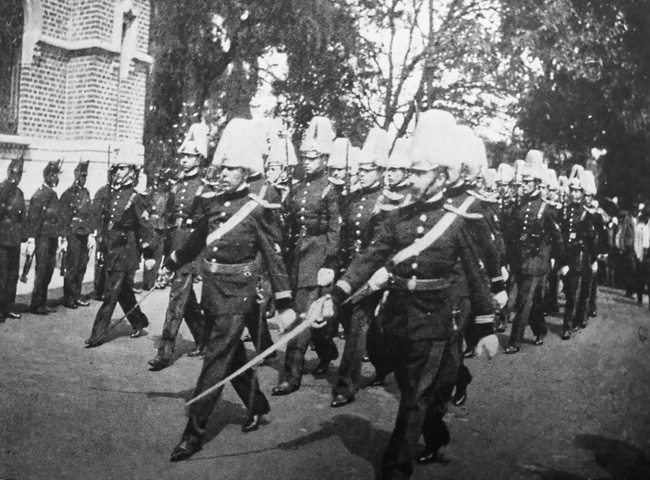
Military Academy, September 8, 1910. Picture: Gustavo Casasola, “Seis Siglos de Historia Gráfica de México 1325-1976”.
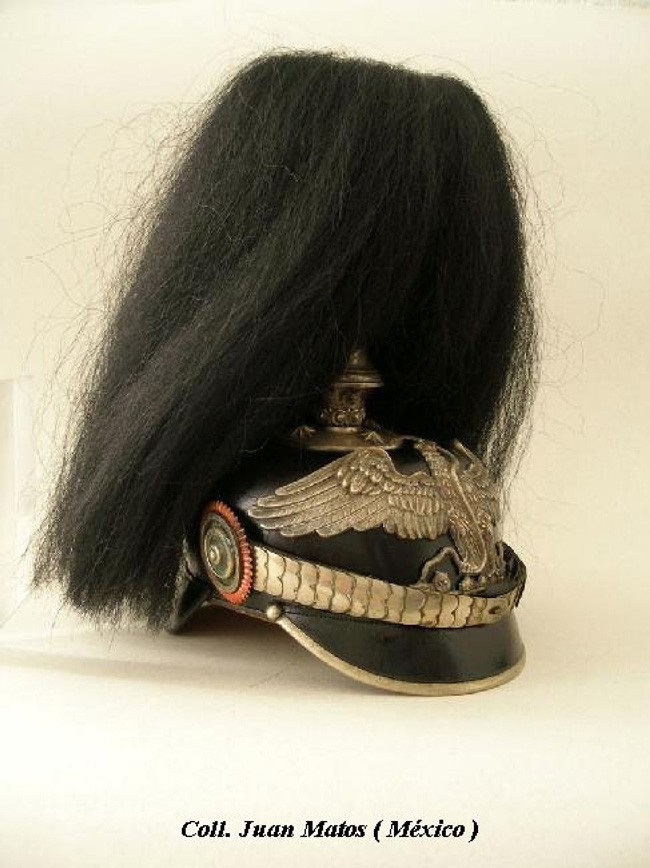
Cavalry Captain´s helmet, 1910. Coll. Juan Matos, Mexico.
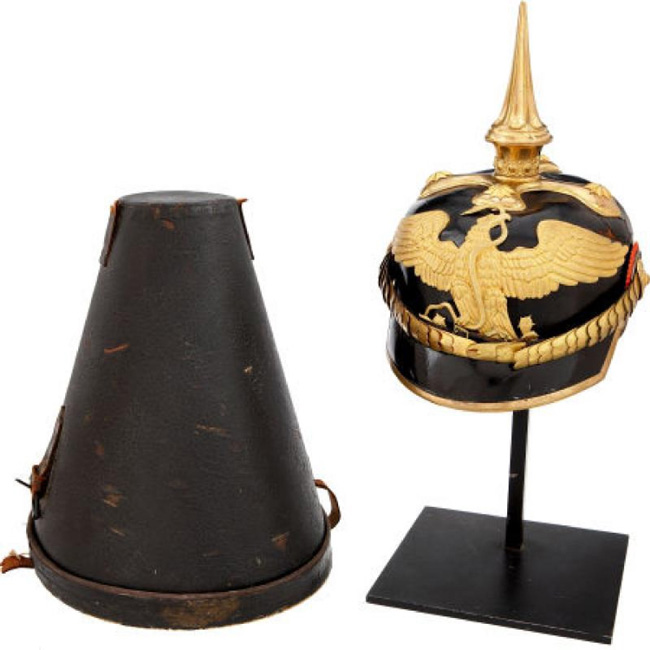
Gen. Gonzalo Acosta Mason helmet (Historical.Ha.com).
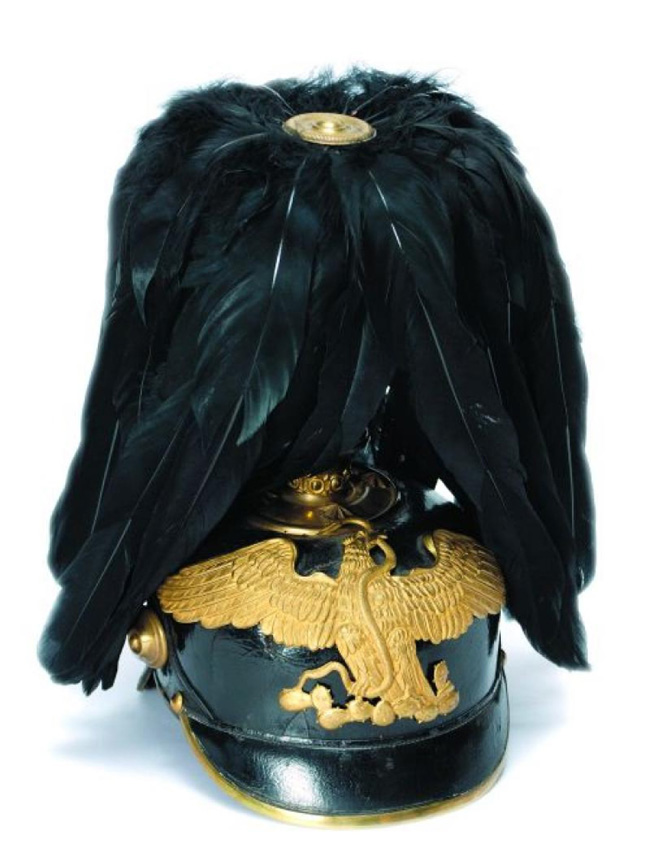
Cavalry General helmet, with parade plume, 1910. This helmet was Auctioned on September 07, 2010, by the House Louis C. Morton, in USD$ 11,556.
NICARAGUAN SPIKE HELMETS
1893 -1909.
The German influence was present in the Army from 1893, and it ended in 1909, with the anarchy and the subsequent American intervention in 1912.
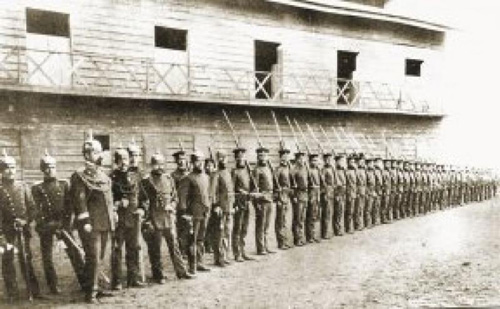
Formation of the Military Polytechnic Academy of Nicaragua, 1901. The tallest Officer in the picture is the Engineer Camilo Castellón, Secretary of War, and the Officer at his right, is the Colonel Kart Uebersesig, German Instructor and Director of this Academy.
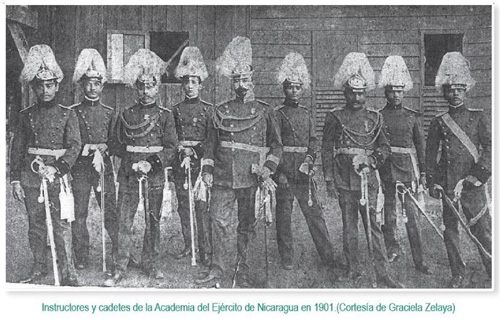
Instructors and Cadets of the Military Polytechnic Academy of the Army, (Mr. Castellón to the center, and the colonel Uebersesig to the right),Nicaragua, 1901.
PARAGUAYAN SPIKE HELMETS
1900 – 1930.
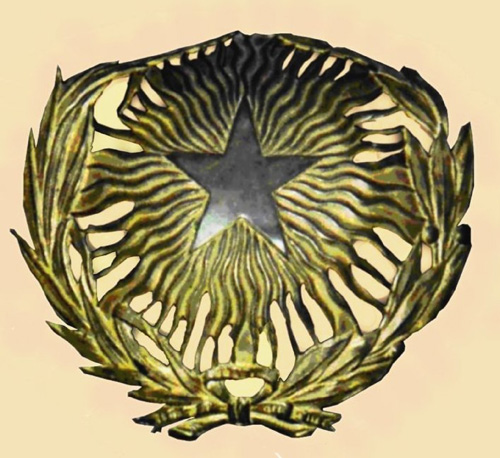
Front helmet plate of Paraguay
The Prussian helmet served in the Paraguayan Army since 1900, and with the advent of the French military missions in the late 20s that changed the organization and the equipment of the Army, they definitively disappeared from its inventory.
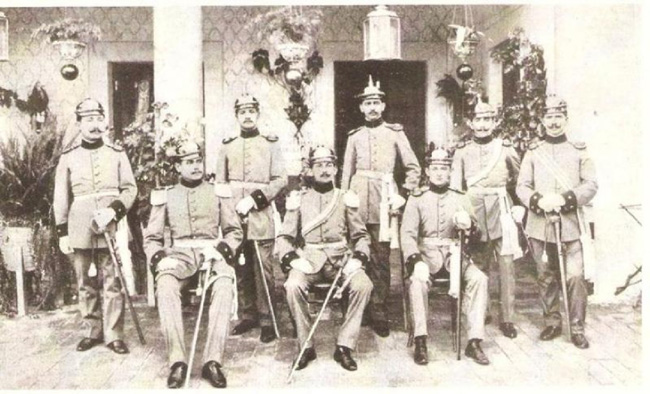
Paraguayan Officers. Ca. 1928. Coll. Ernesto Sosa.
PERUVIAN SPIKE HELMETS
1872-1880.
They were used from 1872, and until the defeat of the army, in 1880. The army began to use it since the Uniforms Regulation of 1872, in the parade and daily uniforms. It is know to have been used, at least, by 2nd Cavalry Regiment ” Lanceros of Torata”, the 1st Line Infantry Battalion ” Pichincha” , and an Artillery regiment or battalion.
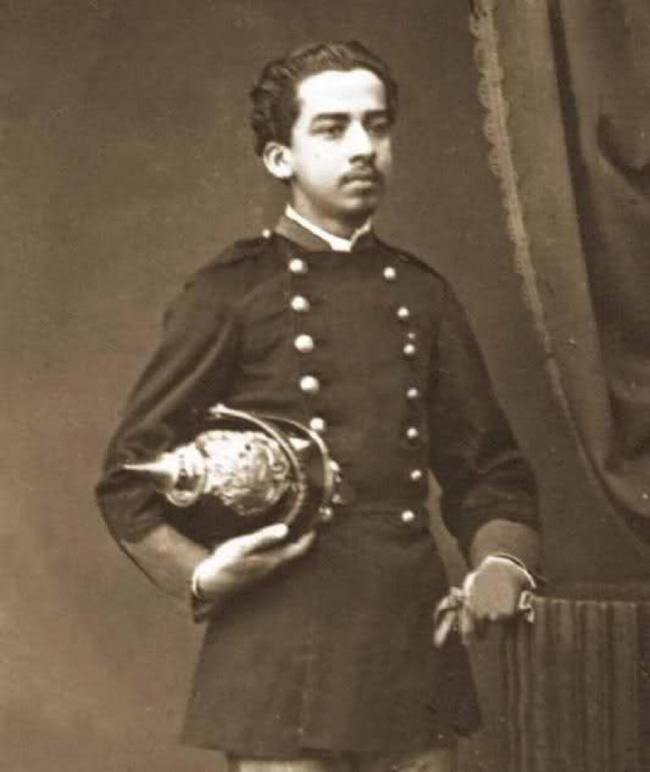
Wonderful picture of an Artillery Lieutenant of junior grade ( Alférez ), in daily uniform, Lima, 1879. The Picture is from the book: “La Guerra de Nuestra Memoria, Crónica Ilustrada de la Guerra del Pacífico”, by Renzo Babilonia Fernández Baca, January 2009, Peru.

Cavalryman of the 2nd Cavalry Regiment. “Lanceros of Torata” (1872) Ilustration: “Evolución Histórica de los Uniformes del Ejército del Perú (1821-1980)”, Peruvian Army, Dic.2005.
URUGUAYAN SPIKE HELMETS
1924 -1932.
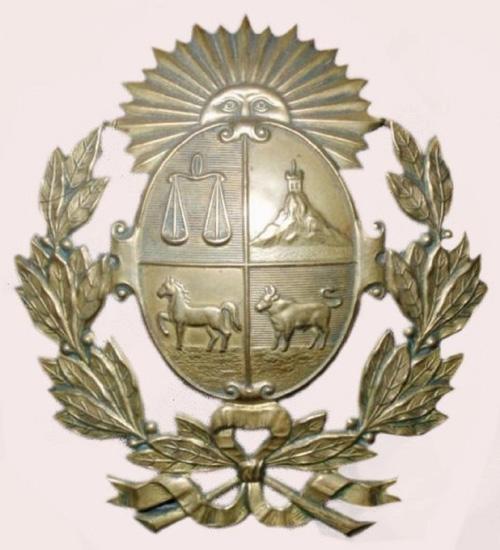
Coat-of-Arms of Uruguay
The Country possesses a strong French tradition in its Armed Forces, however between 1924 and 1932, the “Guardia Republicana” (Mounted anti-riot Police), used a type of spike helmet similar to the M/1895 model, with its corresponding hairbush and the national Coat-of-Arms.
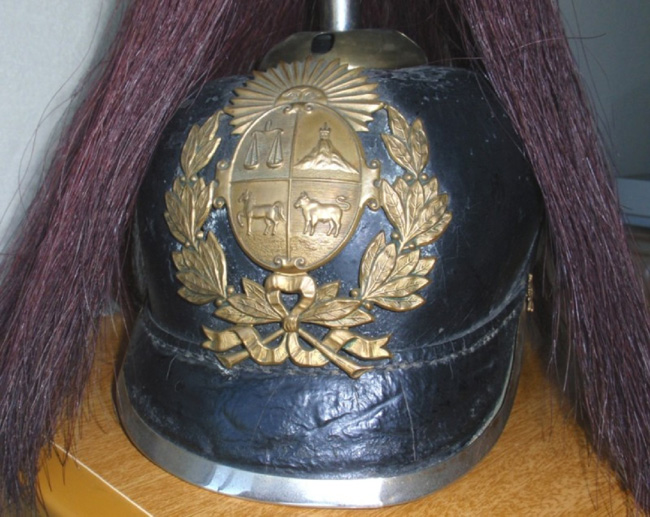
Spike helmet of the Republican Guards (Mounted Anti-Riot Police). Coll. Carlosraul187, MercadoLibre Uruguay.
VENEZUELAN SPIKE HELMETS
1918 – 1945 and 1971 till Present-Day
The pickelhaube appeared with the reorganization impelled by the Chilean military mission from 1910 on, that brings to the Army the characteristic view of the Prussian pattern. In 1918, the Military Academy of Venezuela, adopted the spike helmet that remained in use until 1945 (in 1936, it changed from black color to turquoise). However, it reappeared on June 24th, 1981, and on 2007, the National Shield was changed, to the new Bolivarian Coat-of-Arms. Starting in September 2010, different colors of hairbush were adopted for the different levels of the Academy Cadets. The Air Force Academy adopted between 1982 and 1986 a strange model of pickelhaube that had a short period of use.
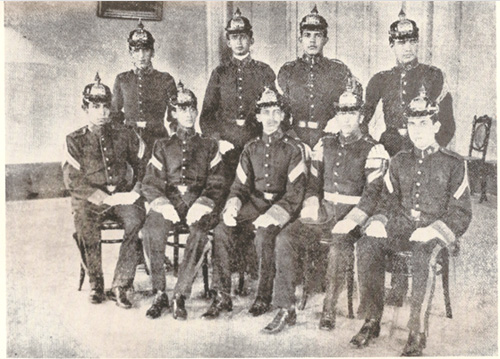
Cadets of the “Escuela Militar” of Venezuela, 1918. Picture: Foro Militar de Venezuela.
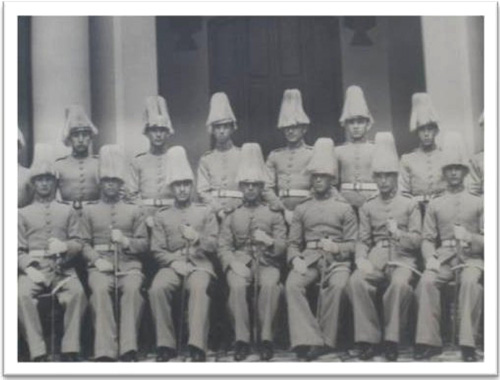
Cadets of the “Escuela Militar” of Venezuela, period 1936-1945. Picture: Foro Militar de Venezuela.
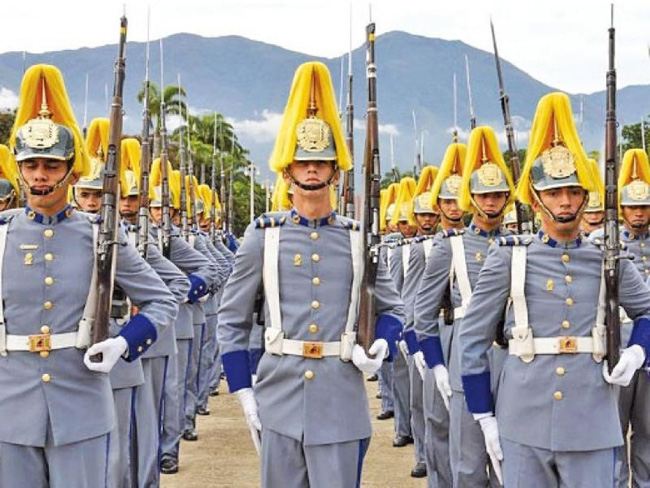
Cadets of the “Academia Militar” – Military Academy- of Venezuela, current – 2nd year academic level -.(Former “Escuela Militar” to 1998)
http://www.youtube.com/watch?v=e7s1D1IjbcM
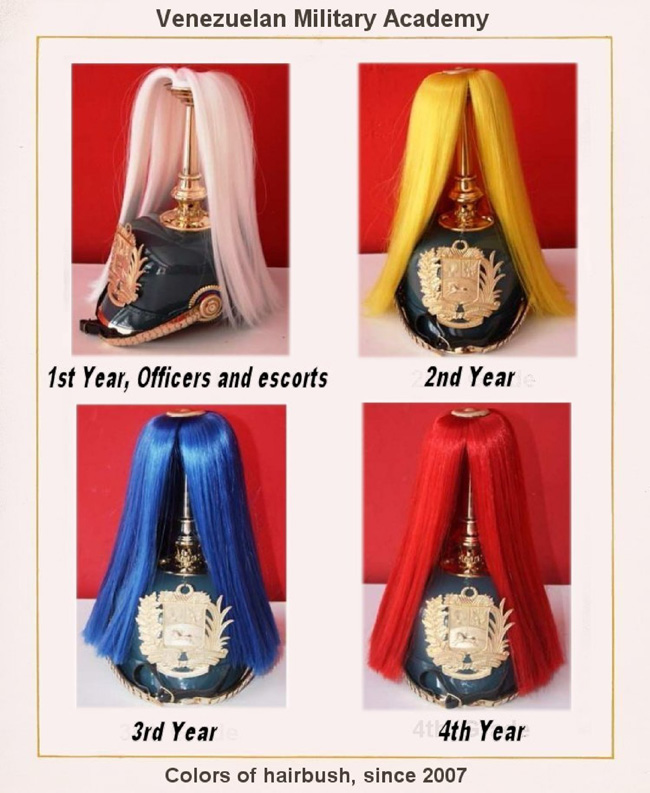
Parade plume colors, for each academic level of the Venezuelan Military Academy ( Since 2007 )
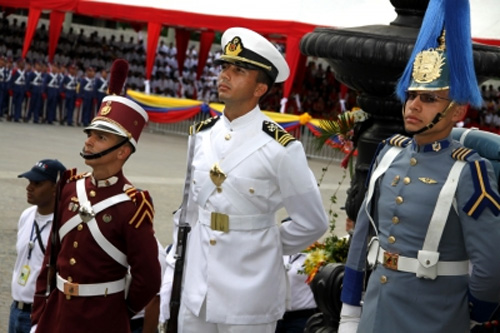
Cadet of the Military Academy, in parade uniform (3rd Year)
Spike helmet from the “Escuela Militar de Venezuela”, prior to 1936. Coll. Raúl Yáñez M.
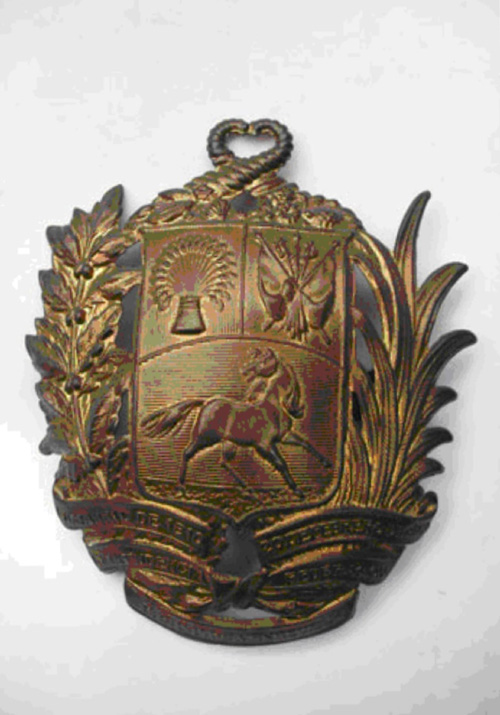
Helmet Plate from Venezuela, previous to 2007
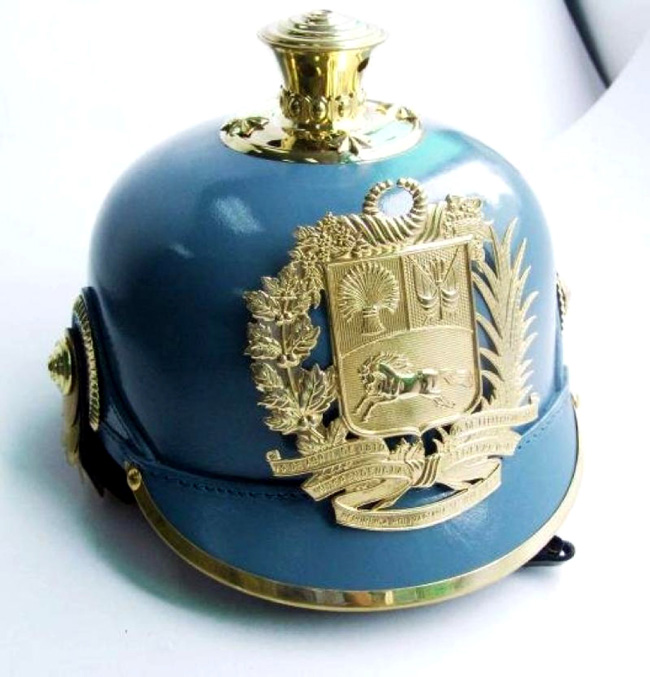
Current helmet of the Venezuela Military Academy, with the new Bolivarian front badge.Note the horse facing left and compare with the previous badge. The change took place in 2007.
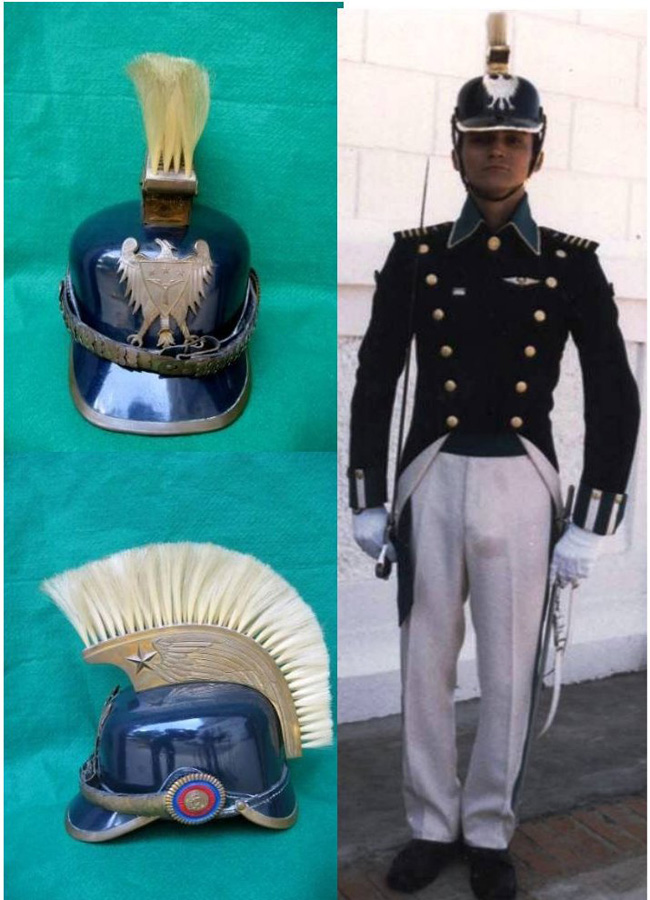
Cadet of the Air Force Academy (FAV), with their peculiar helmet, used from 1982 to 1986.
Bibliography :
1.- “Les Coiffures Prussiennes de l´Armée Chilienne”, Gazette des Uniformes, Nr. 204, Sept. 2002, by Jean – Manuel Torti
2.- “L´Armée Chilianne Prussianisse”, Gazette des Uniformes, Nr. 154, by Juan Angel Torti
3.- “Historia del Ejército de Chile: Nuestros Uniformes”, Tomo XI, 1985, EMGE.
4.- “Cuatro Siglos de Uniformes en Chile”, by Antonio & Alberto Márquez Allison, Library of Congress UC485.C5M37 1976.
5.- Abstract: “La Escuela Militar y el casco Prusiano, Antecedentes Históricos”, by Colonel Alberto Márquez A., Chilean Army
6.- “The Kaiser’s Army in Color, 1890-1910”, C. Woolley
7.- “Memorial del Estado Mayor del Ejército de Chile”, Feb. 1913. Chilean Army magazine
8.- “Retrato: Los Héroes olvidados de la Guerra del Pacífico”, M. Pelayo, C. Arce, E. Gardella, Santiago, 2007.ISBN: 9562845826
9.- “Uniformes de la Guerra del Pacífico: Las Campañas terrestres 1879-1884”, Greve y Fernández. ISBN: 978-1-85818-582-8
10.- Abstract “Información sobre el casco de la Academia Militar de Venezuela (A.M.V.), by Eddie Ramirez
11.-“Seis Siglos de Historia Gráfica de México 1325-1976”. Gustavo Casasola.
12.-“La Guerra de Nuestra Memoria, Crónica Ilustrada de la Guerra del Pacífico”, by Renzo B. Fernández Baca, Peru, January 2009.
13.-Abstract “Evolución de los Uniformes Militares Argentinos” by Major Sergio O. H. Toyos, Argentinean Army.
14.- “Armed Forces of Latin America”, by Adrian J. English/Jane’s Publishing Co., 1984, ISBN 0710603215
15.- “La influencia del Ejército chileno en América Latina 1900-1950”, by Roberto Arancibia Clavel, CESIM, Santiago, 2002. ISSN 0717-7194
16.- “Evolución Histórica de los Uniformes del Ejército del Perú (1821-1980), Peruvian Army, Dic. 2005
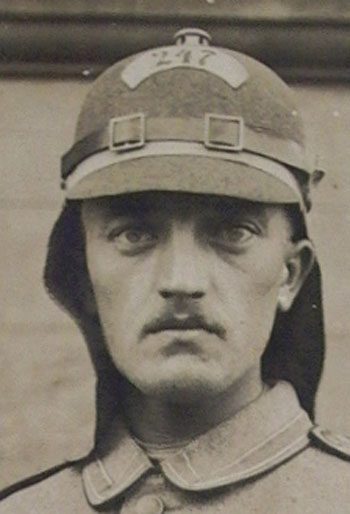
Scroll Helmets
Scroll Helmets
Joe Robinson
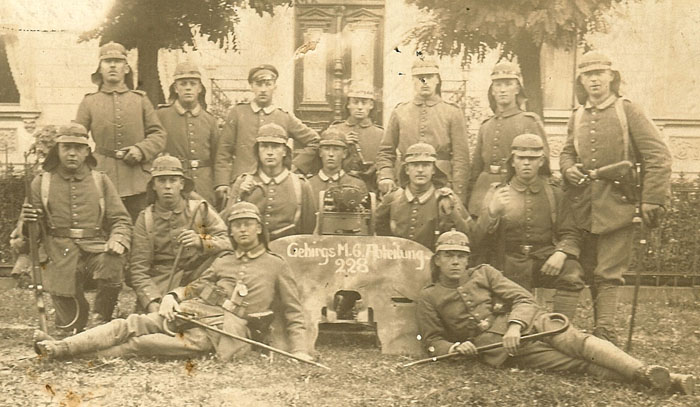
Several years ago a friend of mine named Martin asked a series of simple questions concerning a filz helmet he had bought that had a scroll Wappen on it. My opinion flipped back and forth and I really do not think I did Martin any great service. However, it started me off on a search for “truth” concerning the scroll helmets. I have yet to figure it all out but thought I would put some thoughts down. My paltry efforts are all due to Martin and I thank him.
There is very little information on these helmets and very few pictures. As one of the benefits of earlier versions of this article more pictures have come out of the woodwork and collections .
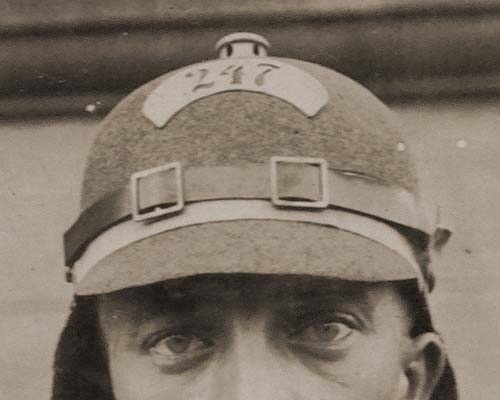
On the eighth of December 1915 the Prussian War Minister authorized the use of an experimental helmet for use with some troops earmarked for Serbia.ii Instead of having an eagle for Prussia as a helmet Wappen these helmets had a metal number shield in its place. The shields are known as scrolls. Thus was born the legend and confusion of the scroll helmets. The Illustrated War News printed a picture of some machine-gun troops with this helmet in 1915.

In the modern conventional wisdom confusion raised its ugly head and the sources for the specific helmets were lacking. So I thought I would start looking at it from the simple approach of what, where when, who and why.
What
Using the generic term of scroll helmet is far too simplistic. There are several items that are consistent. For instance these helmets were almost never worn with the spike. It is not clear if they were ever issued a spike. There were no cockards worn. There seems to be three specific types scroll Wappen.
1. This is the type most commonly seen in pictures. It consists of a metal semicircle of simple shaped scroll with cut out numbers. The method of attachment to the filz helmet cannot be determined from the pictures. We will refer to this as type 1. There is a variant to the type 1 which has a design on the edge and a lip around the outside. We will refer to this as type 1A.
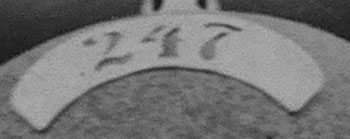
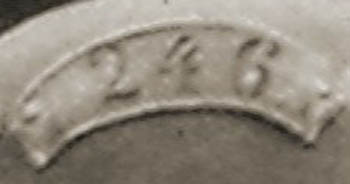
2. This type is commonly seen in surviving artifacts and examples. It consists of a metal plate with embossed numbers. The helmet plate is secured through the use of split brad retainers. We will refer to this as type 2.

3. This type is commonly seen in references and unfortunately has been the subject of reproduction. It consists of unit number below the letter “R”. The numbers are either cut out or embossed. We will refer to this as type 3
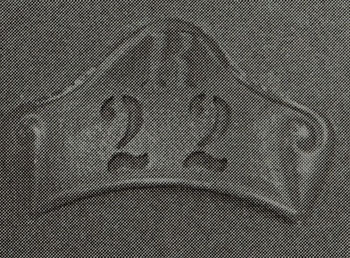
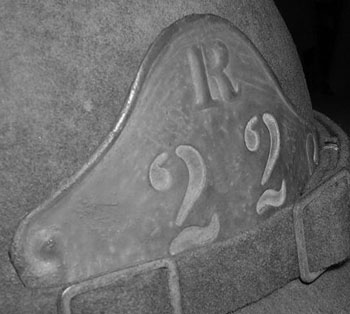
The helmets are generally made of an Ersatz substitute material. Most of them are made out of filz. However they have been documented with cork covered with cloth. They were worn with an M15 type bayonet spike base that is ventilated. There is a ventilation cover on the rear spine. There are M 91 posts made of gray metal. They are found both with and without a visor trim and the chin straps are made of leather.
That helmets were often worn with a long neck covering. This is known by several names but we will call it “Nackenschutz”. The Nackenschutz was a separate item and attaches to head gear through a separate band and buckle. Lacarde makes reference to the band being elastic. The Nackenschutz did not need to be worn with a helmet.
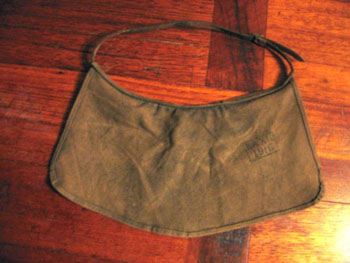 iii
iii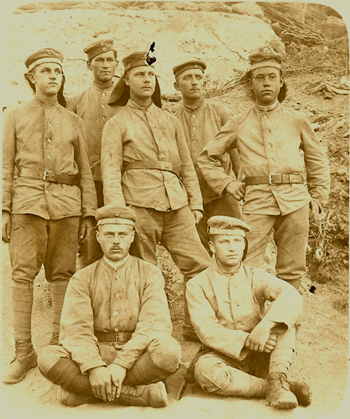
Johansson has an example of a type 3 in his book “Pickelhauben” on page 60. It is a filz helmet with a ventilated spike base and a scroll with cut out letters. He calls the metal “pewter”, and states that the R22 designation stands for Infantry Regiment 22. There is no visor trim. It has a black leather chinstrap with gray metal buckles. On page 61, he shows a type 2 used on a cork helmet with a white cloth covering. This appears to say 116. It has a brown leather chinstrap with no buckles. iv
Lacarde in volume 1 page 112 shows a type 1A with a number 212, a visor trim and two gray buckles. He mentions steel fittings. v (This helmet is from Fort de la Pompelle and a shown later in the article)
Kraus in his book “The German Army” shows an example on page 70 that is a type 2, with the number 135. The helmet is clearly marked to Bekleidungsamt XVI. Kraus goes on to admit that this helmet is of unknown origin. It has a leather visor trim, a black chinstrap and cockards. On page 71 he has a helmet that does not have the scroll but has a unit number painted directly onto the front of the helmet. This helmet also has a Nackenschutz and is clearly marked to the 205th Pioneer Company. vi The Belgian Army Museum has a similar helmet shown here in a picture taken by Max Chaffotte. So far I have been unable to determine the source of this helmet.
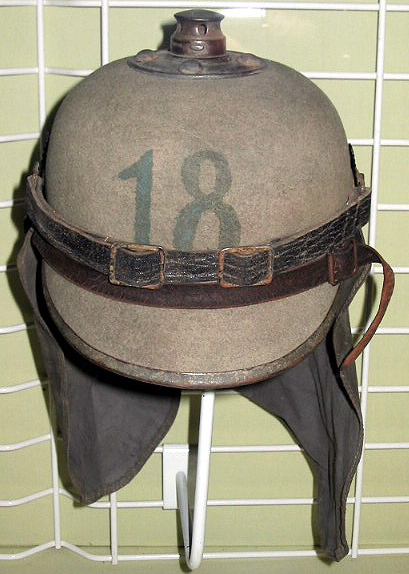
In the Wurrtemberg book — Konigreich Wurtemburg die Militärische Kopfbedeckungen — on page 56 there is a picture of a soldier wearing a type 1 with a Nackenschutz but no visor trim. The picture is attributed to Gebirgs Maschinengewehr Abteilung 250, this is a Wurrtemberg formation created 7 September 1915. vii
On page 87 of the two-volume book by Kraus there are a series of diagrams. These include a type 3 R116, a type 2 227, a type 3 R22, and a type 2 that looks to be 237. viii
Where
References are full of two different locations for these helmets. Serbia and Macedonia.
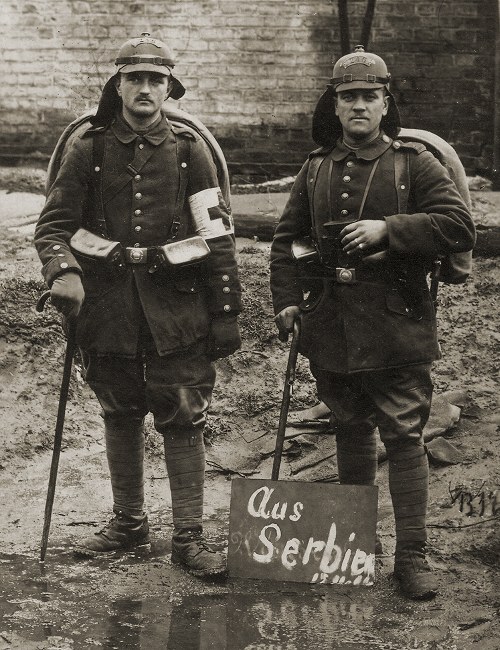
Both of these are illustrated on this map. Everyone knows where Serbia is however this was the fourth invasion of Serbia in 1915. Macedonia is a different concept. You can see Macedonia on the very southern border of Serbia. What exactly is Macedonia is still debated. Bulgaria, Serbia and Greece all had land claims to parts of Macedonia. Each country’s different interpretation of what Macedonia was continues to this day. A small bit of trivia is that the modern country of Macedonia is actually known as FYROM. That abbreviation stands for the Former Yugoslavian Republic of Macedonia. That name was finally settled on after vehement disputes over who owned Macedonia between Bulgaria, Greece and the new country.
For our purposes, Macedonia is the front between the Central Power Armies and the Entente armies headquartered in Salonika.
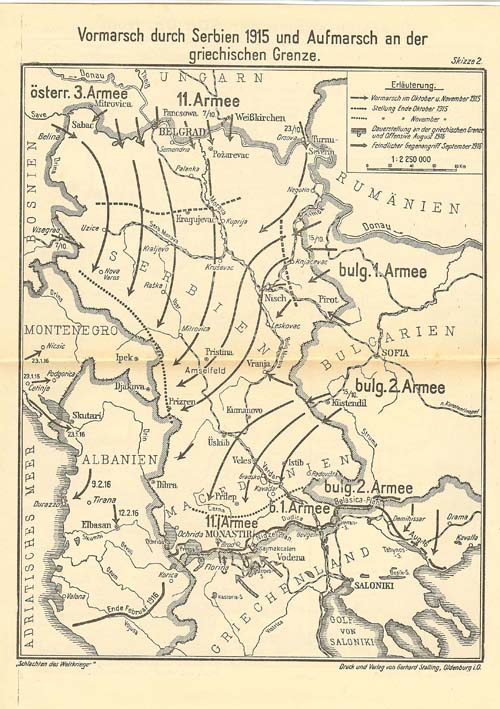
ix
When
This can be a very sticky question. The original Prussian order from the War Minister was dated to August 1915. The invasion of Serbia that these troops allegedly were involved in started in October of 1915. The very first picture on this page is dated November 1915. The manning of the Macedonian frontier continued until the end of the war. It is unclear when helmets were no longer worn on the Macedonian front. Below is a picture of Gebirgs Maschinengewehr Abteilung 249 in Macedonia dated 11/7/1916 wearing a tropical helmet. The gentleman on the right wrote a series of postcards from April 1917. Pictures from Palestine show tropical helmets without scrolls still being worn in 1918. The Prussian War Minister decreed that there would be no more use of filz helmets on the front after August 15, 1917. Did this include Macedonia?
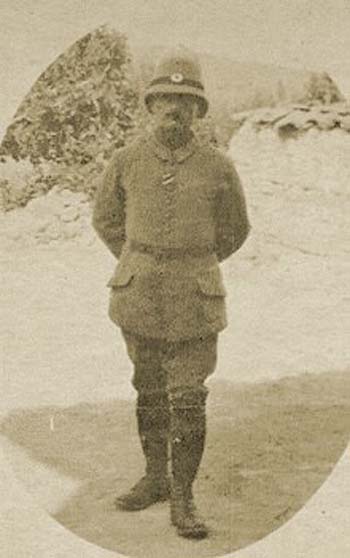
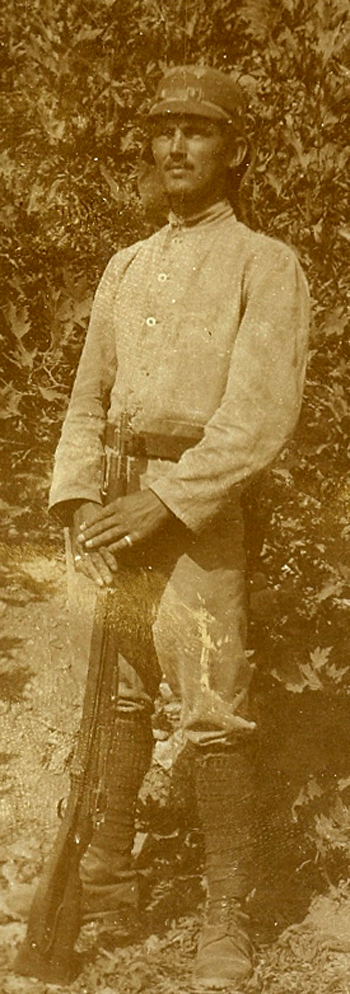
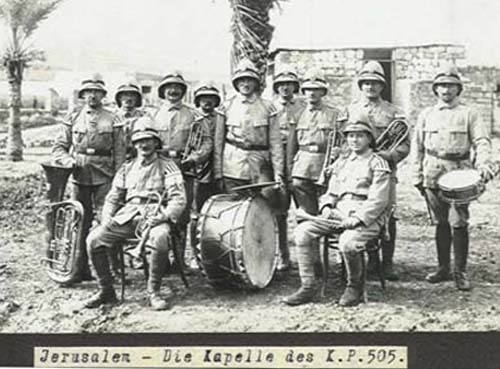
This is the depot in Alexinac that was established for these units. The writer confirms the location, although misspelled. The depot was opened around May 7th, 1917. It comprised personnel for training, medical care etc.
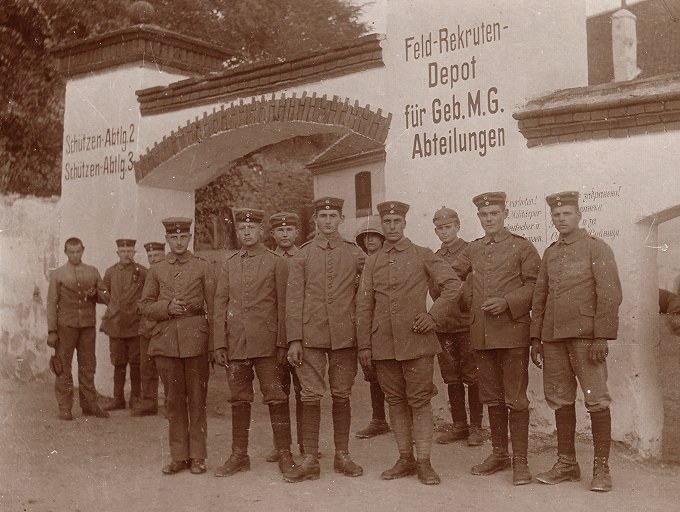
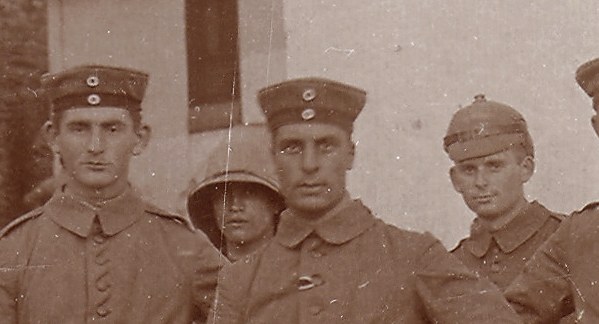
Not much detail there. However, the guy with the big helmet poses another question. Did these units switch helmets?
Who
Gebirgs Maschinengewehr Abteilung
The original Prussian order from the War Minister established scroll helmets for the Gebirgs Maschinengewehr Abteilung 211 through 250. There are several pictures of these mountain machine gun battalions. They were not assigned to divisions and are somewhat difficult to track. All of the pictures of the Gebirgs Maschinengewehr Abteilung have a type 1 and 2 helmet Wappen. While there are questions of timing there is no question really about these machine gun units having a scroll helmet. There is documentation that says that GMGA 211 thru 250 had numbered shields. There is an example of a helmet with a type 1A plate for 212. There are diagrams in references for a type two 227, and 237 and a picture of a soldier wearing a 218, 228, 232, 238, 246, 247 and a 250 type one. The entire empire contributed to these.
Württemberg: GMGA 250
Saxony: GMGA 249
Bavaria: GMGAs 206-209 (later GMGA 262), and 248
Prussia: GMGAs 201-205, 210-247, 251-255 (in 1918, 15 of these these bacame the new units 260, 261 and 263-265)
Order of battle information on these machine gun units is very hard to come by and must be pieced together. There are no unit histories for these units. GMGA 201 through 209 were formed primarily of cavalry division’s on the Western front.GMGA 210 and 251 also seem to have been assigned to Belgium on the Western front. It appears as though GMGA number 242, 244, 245 and 246 were attached to the sixth infantry division in 1917 and transferred out of Macedonia. There is a picture of GMGA 203 in Macedonia in Dec. 1916.
Another researcher by the name of Robert Hinsley has extensively dug into these GMGA. The following paragraphs and conclusion is a quote from Robert that was placed on pickelhaubes.com.
In the following I will translate what is written about the GMGA formation until 1917, leaving out some lenghty passages (marked …) and marking my own notes with square brackets. The orders are usually referenced via footnotes:
“Very soon after war begin the need for special machinegun units besides the regular MG issues for the troops fighting in mountain terrain became obvious in the Vosges and the eastern front. Only whith these it was possible to move firepower quickly to the required places, to support own actions or defend stretched frontlines against superior enemy forces. Upon an urgend request of the OHL [Oberste Heeresleitung, i.e. highest army command], fourty GMGAs numbered 211 to 250 were quickly assembled by the MG training course Döberitz beginning in August 1915. 18 of these units had to be deployable by Sept. 9th, the following 22 by Sept. 20th 1915 (Pr. Kr. Min. Nr. 2002/8. 15 A. 2 D from August 21st, 1915). The mobilization of these troop was so important that all other requests had to stand back and the outfitting of other MG units that were planned for August and September was delayed. All personnel and carriage animals that had been sent to Döberitz for other reasons were assigned to the first 18 GMGA units (Pr. Kr. Min. Nr. 976/8. 15 A. 2 D from August 12th, 1915). The following 22 GMGA units were equipped with personnel and horses by the Stellv. Gen. Kos. [assistant general commands?] by Sept. 7th 1915, with Württemberg providing one of these units. The personnel had to be of good health and suitable for action in mountain terrain. The special mountain equipment and the uniforms were provided by the Pr. Kr. Min. (Prussian war ministery), guns, harnesses and ammunition by the Gew. Prüf. Kom. [Gewehr Prüf-Kommission, i.e. an arms inspection commision?] resp. the field maintenance depot. The mountain MG personnel received the gray-green uniform of the machinegun units with the units numbers on the shoulder flaps, and experimentally a lighweight helmet of felt with matte fittings, ventilation and a neck flap (Pr. Kr. Min. Nr. 1960/11. 15 B. 3 D). The GMGA units were organized in 2 platoons with 3 machineguns each and had a required strength of 4 officers, 175 other ranks, 85 horses (including 48 carriage animals) and 7 vehicles.
Upon this order the personnel for the Württemberg GMGA 250 was assembled at the 1. Ersatz machinegun company 121 in Münsingen and send to the MG training in Döberitz on Sept. 5th. By Sept. 15th the unit was regarded to be mobile and already 14 days later on Oct. 1st it was deployed to the 11. army in order to move to the Oberkommando Mackensen from southern Hungary and participate in the offensive against Serbia.
This way fourty GMGA units were mobilized in a single month. … Upon orders of the OHL, the GMGA units 235-238, 241 and 243-246 were reorganized to MG companies in March 1916 and attached to infantry regiments as first or second MG companies (Pr. Kr. Min. Nr. 1656/2. 16 A. 2 D). At the same time, the remaining GMGAs were strenghtened by 21 men, 20 horses and 3 double-sided vehicles [wagons with two horses] each, the latter being light Gebirgswagen 15 or vehicles of the region. … While this increase of strength became effective, orders of the ADK 11 (army group Mackensen) attached the GMGA units 210, 240 and 247-250 to the 5th Bulgarian division were they served at a streched frontline. This deployment required to increase the number of machineguns from 6 to 9 by the end of July 1916. This state remained until early 1917. On May 7th 1917 a verification of the strength of all GMGAs was again required and confirmed at 9 guns per unit. At the same time, a depot with the name “Feldrekrutendepot für G.-M.G.-Abtlgen der Heeresgruppe Scholtz” was established in Alexinac for the GMGA units in Serbia (*).
* Footnote:
Consisting of command, training personnel, rifleman detachment, carriage animal unit, surgical unit. Total strength: 16 officers, 827 men, 127 horses (including 90 carriage animals) and 7 vehicles. …
After this reorganization the required strength of a GMGA was 9 machineguns, 4 officers, 247 other ranks, 139 horses (including 80 carriage animals) and 21 vehicles, allthough this strength was never reached due to the increasing shortage of personnel and equipment.”
…
Some conclusions:
* The reason that often only the GMGA units 211-250 are mentioned may be that these were the first batch that was mobilized. Evidently, the lower numbers 201-210 followed later.
* The uniforms were provided by Prussia, which is probably the reason why GMGAs from different states have identical outfit (including helmets).
* The special helmet model was intentional and not (or at least not exclusively) the result of the shortage.
* The GMGAs have a quite large number of horses and carriage animals (139/80 after beefing up in 1917) considering their size similar to companies. In other parts of the document it is described how difficult it was to equip the mountain units with suitable carriage animals. Carriage ponys were even imported from Sweden. So evidently the mobility (and independence from other transport units) was regarded a main asset of a GMGA.
However, none of these listings can come close to explaining this picture. While there is nothing on the back it seems to show the number 270. There was no 270 according to these listings. Are the listings in error? Is it not 270? Look at the shoulder strap–what is that?
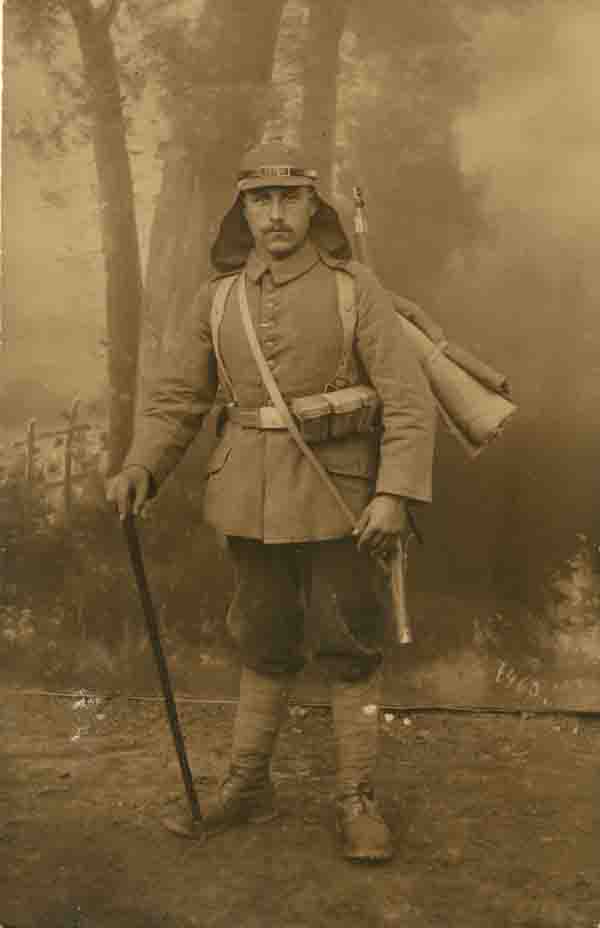
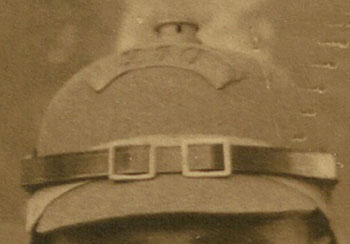
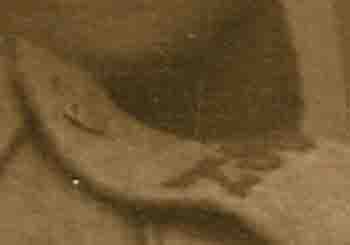
Here are some additional pictures of scroll helmets.
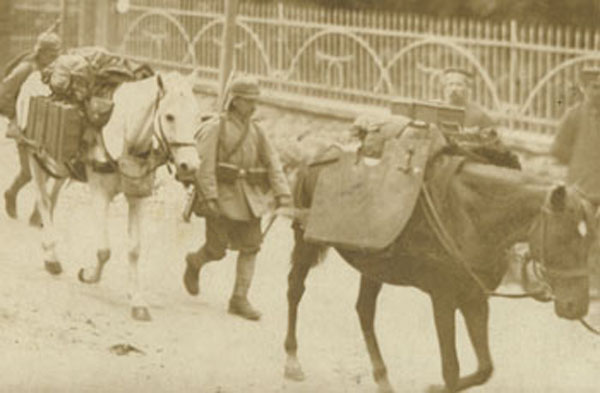
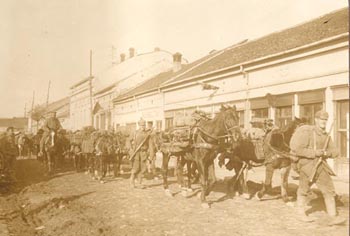

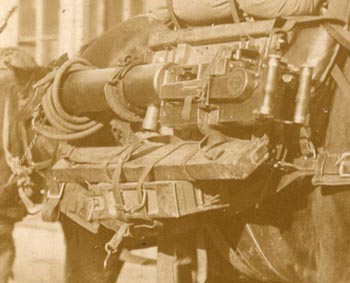
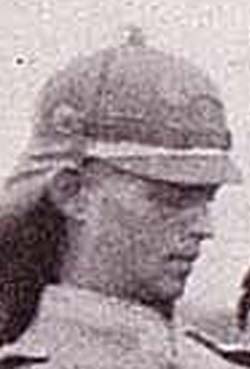

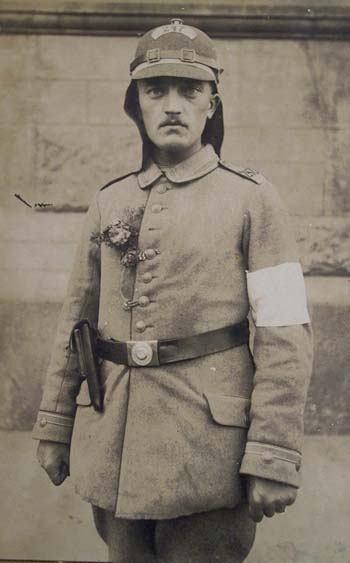
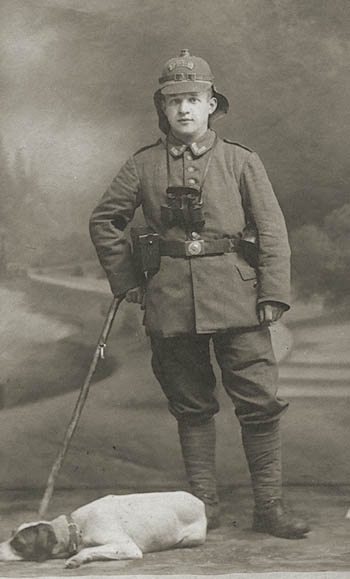
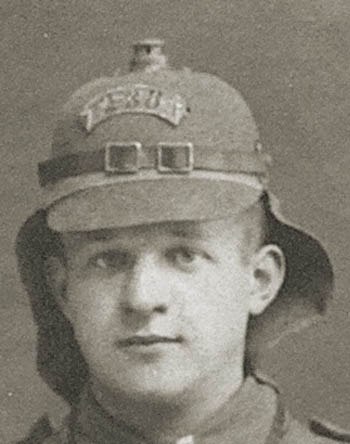
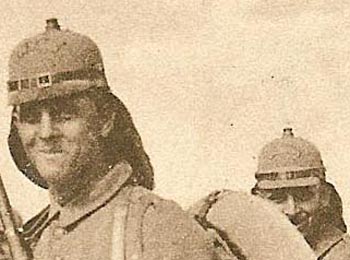
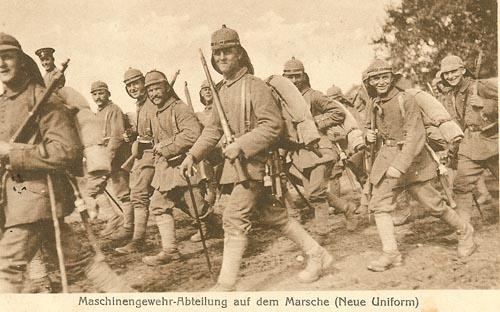
Variations and Holes
Some of these pictures with type 1 helmet scrolls show a hole on the left-hand side of the scroll. It is believed that these are production holes made by the manufacturer to accommodate another type of Wappen on these helmets. There seems to be a convention where if there was an extra space it would be placed in the same area. It is not clear what kind of Wappen was originally designed for these filz helmets.

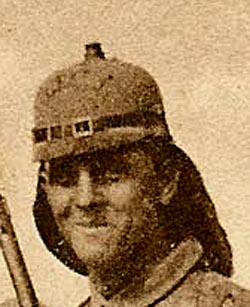
In addition, there is a variation between the plate for 238, 246 and the one for 247. There seems to be an edge design on the 238 scroll.
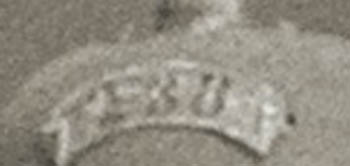


Both the hole and the edge design can be seen in this picture from Fort de la Pompelle. The picture of this helmet was provided by Max Chaffotte.
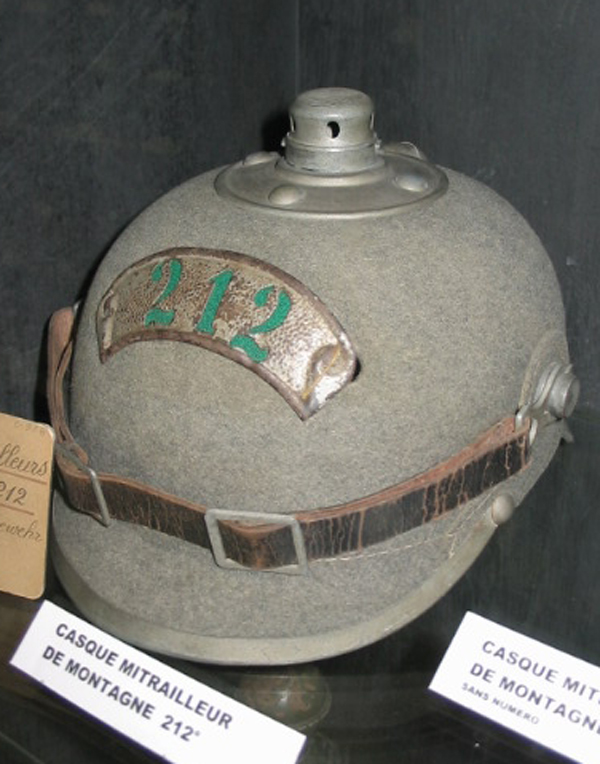
The hole is on both sides in this picture and appears plugged.
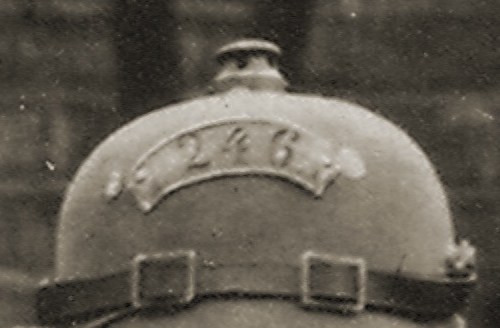
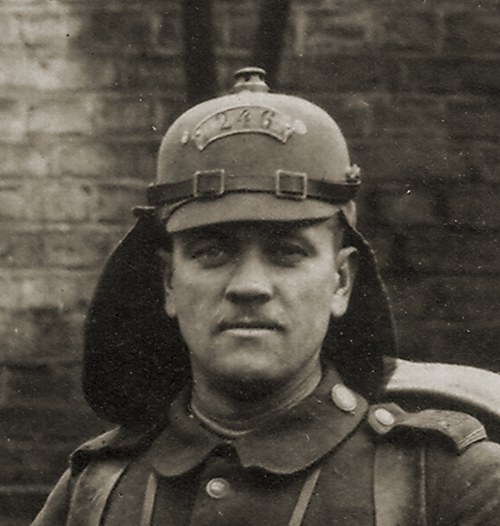
This picture has both a helmet and a shako from GMGA 247.
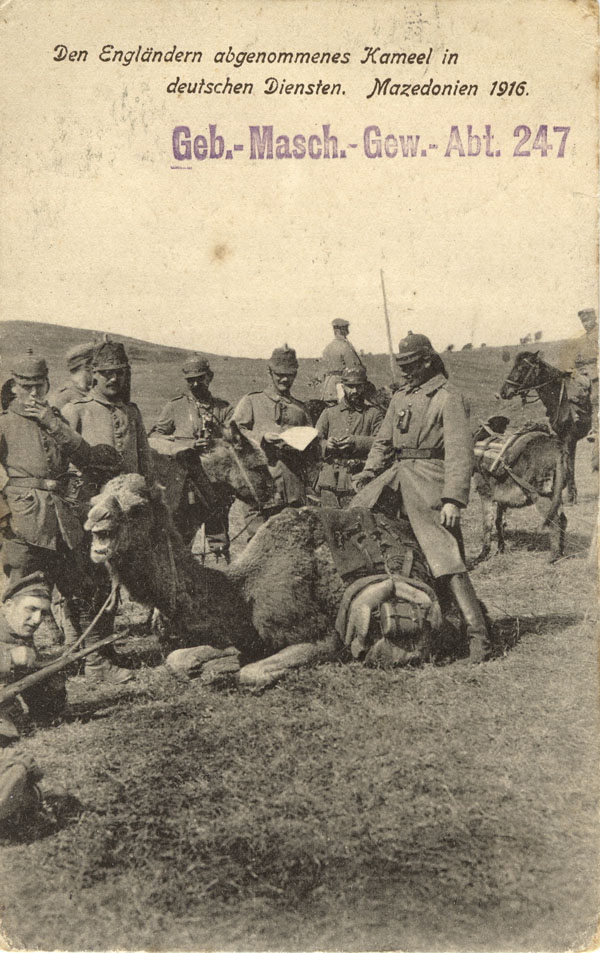

11th Army- Gen der Artillerie von Gallwitz– Regiments
The order of Battle of the 11th Army, which went into Serbia varies a lot depending upon the reference. I don’t mean a little bit — I mean it really varies both corps and division assignments. According to the Histories of the 251 Divisions there are actually two Reserve Infantry Regiment 116 in two different divisions! Having looked and discussed this with other researchers this is my best attempt at an order of battle as of 4 October 1915.
III Corps. – Gen der Infanterie von Lochow
for
6th Division.
20th Regiment.
24th Regiment.
64th Regiment
25th Reserve Division.
118th Reserve Regiment.
83rd Reserve Regiment.
168th Regiment
IV Reserve Corps – Genlt von Winckler
105th Division.
21st Regiment.
122nd Fusilier Regiment.
129th Regiment
107th Division.
52nd Reserve Regiment.
227th Reserve Regiment.
232nd Reserve Regiment
11th Bavarian Division.
3rd Bavarian Regiment.
22nd Bavarian Regiment.
13th Bavarian Reserve Regiment
X Reserve Corps.- Genlt Kosch
101st Division.
45th Regiment.
59th Regiment.
146 Regiment
103rd Division
32nd Regiment.
71st Regiment.
116th Reserve Regiment
XXII Reserve Corps. Operating in Serbia under the Third Austrian Army
43rd Reserve Division.
201st Reserve Regiment.
202nd Reserve Regiment.
203rd Reserve Regiment
204th Reserve Regiment.
15th Reserve Jäger Battalion
44th Reserve Division.
205th Reserve Regiment.
206th Reserve Regiment.
207th Reserve Regiment
208th Reserve Regiment.
26th Division.
119th Gren. Regiment.
125th Regiment.
121st Regiment
122 Fusilier Regiment.
AlpenKorps Division
Of these regiments. There is a diagram of a type 3 R116. This would make immense sense for the 116th Reserve Regiment of the 103rd Infantry Division. The example shown in Kraus of the 205th Pioneer Company with a Nackenshutz but no Wappen at all and the numbers painted on the helmet was assigned to the 103rd Infantry Division during the Serbian campaign. In addition there is this picture of the 122nd Fusilier Regiment.
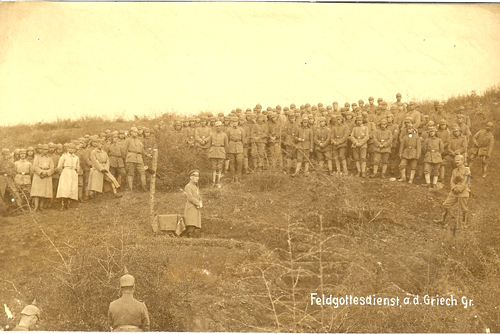
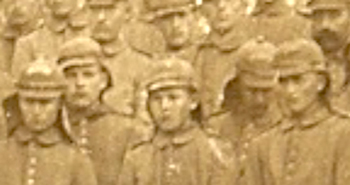
This picture shows a religious celebration on the Greek border. The card is legible on the back where it was sent from East Galatia on the 26th of June 1916. The 122nd Fusilier Regiment did indeed push on to southern Serbia. In June of 1916 the Regiment was sent to Galatia in response to the June Russian offensive. x In that operation, the Regiment was severely decimated. Therefore this picture seems to be taken in Macedonia just before the Regiment left for Galatia. You notice the type 1 helmet Wappen, the Nackenschutz, and the lack of an Uberzug or helmet cover. The mass of enlisted soldiers was accompanied by their officers at this religious service.
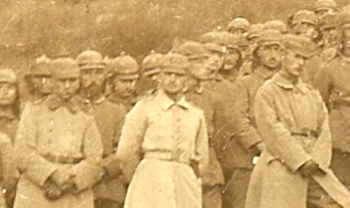
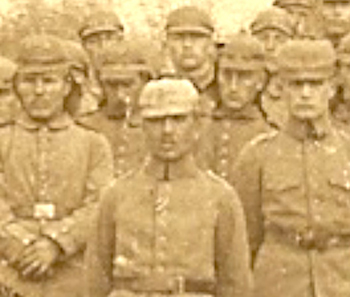
The officers and top NCO wore a spiked helmet with an Uberzug but no Nackenshutz in the picture.
This was the first picture of an officer found wearing a scroll helmet. It is not clear what unit he comes from. There is yet another picture of an officer with the scroll helmet and a Nackenschutz where the helmet has a spike.
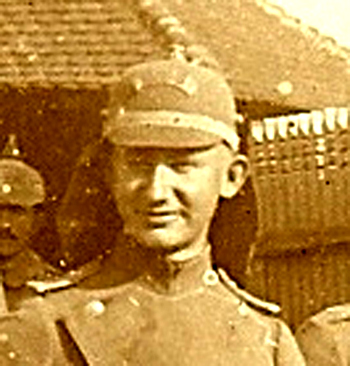
Other Helmets
Here is another example from the collection at Fort de la Pompelle taken by Max Chaffotte. The museum attributes this helmet to the “Würrtemberg mountain train” 4th mule-mounted company of the 101st mountain division. 1916. While this division spent almost all its time in Macedonia it was not a Württemberg division however it is noted according to the 251 Divisions as having had four Württemberg pack trains in 1918. There is no mention of this helmet in the Württemberg book and the cockade on the left side of the helmet appears to be a Reich’s cockade. You will also notice that there is no Nackenschutz on this helmet.
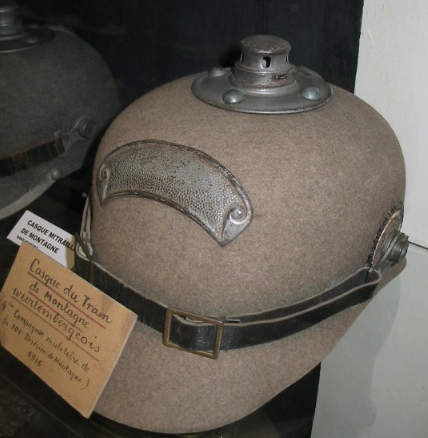
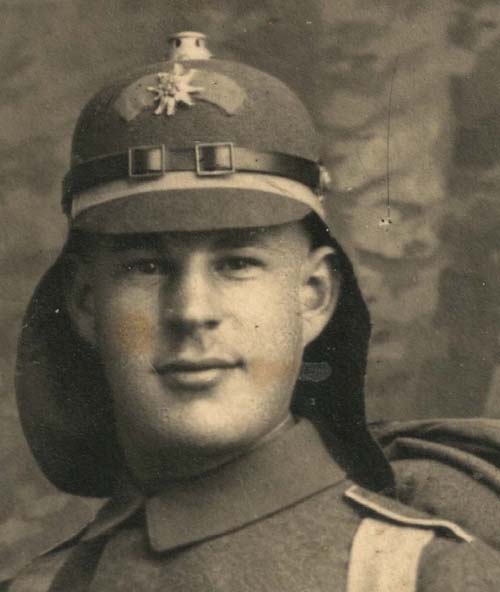
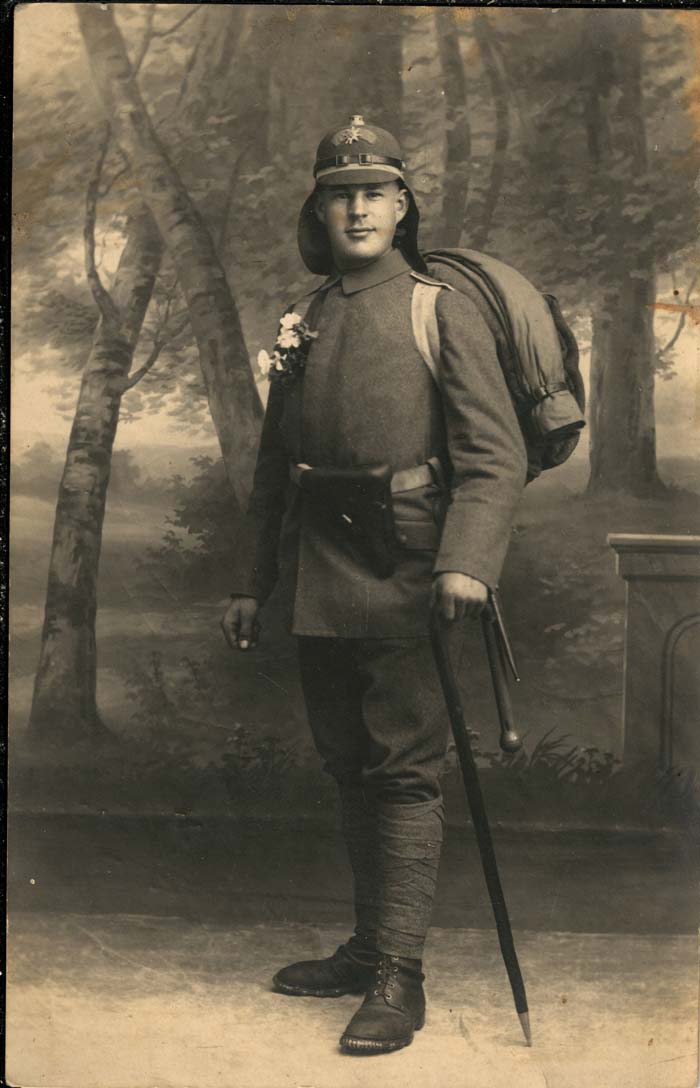
Something is wrong with conventional wisdom
As these helmets continue to be looked at through the lens of Serbia and Macedonia, cracks begin to emerge in the theory. Contrary to previous thought these helmets appear in France.
Given 11th Army order of battle the famous R22 helmet makes no sense. Reserve Infantry Regiment 22 spent its time in the 12th Reserve Division in France until August 1915 then was transferred to the 117th Infantry Division. In August of 1916 the 117th Infantry Division left France — the Somme — and went to Romania; the Carpathian Mountains which are nowhere near Serbia or Macedonia. There is a diagram of a type 3 R116 and an example of a type 2 Wappen that says 116. While Reserve Regiment 116 makes sense — active Regiment 116 does not. Infantry Regiment 116 spent the entire war with the 25th Infantry Division. The entire war was spent in France. 1915 and 1916 were on the Somme and Verdun. Certainly this was far away from a white colored cloth covered cork helmet with a Nackenschutz.
The helmet that Kraus shows with the type 2 — 135 Bekleidungsamt Mark XVI rather then being of unknown origin, sure looks like it would be from 3. Lothringisches Infanterie-Regiment Nr.135 of the XVI Corps. Infantry Regiment 135 spent the entire war with the 33rd Infantry Division. The division never left France and from September 1914 to August of 1916 it was in the Argonne. xi There is no Nackenschutz on the Kraus helmet.
The initial compelling argument about scroll helmets in France comes from this picture.
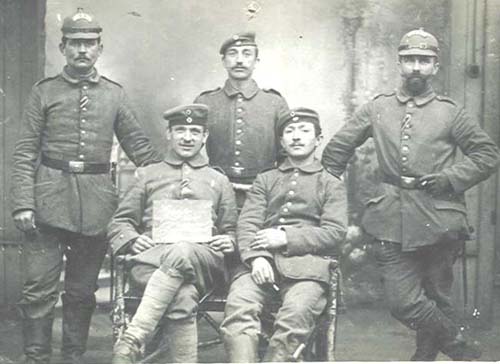
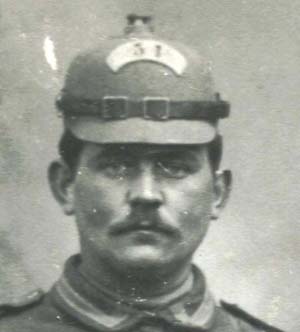

These two soldiers are from Infantry Regiment 51. They do not have a Nackenschutz. The back of the card while not mailed is very legible and says
The best greetings is sending you Michael.
I am well healthy and agile yet; send
in attachment a photograph for
memory to the
conquerors of Frise at the Somme.
The Battle of Frise was a significant accomplishment for the Germans in January 1916. These individuals were obviously very proud of their accomplishment as part of this effort. Looking at the picture sometimes it’s difficult to determine if this is a 51 or 31. It is Koeniglich 4. Niederschlesischen Infanterie Regiment Nr. 51 The translation confirms it. No other infantry unit in 11th Infantry Division (and there is no doubt that the 11th Infantry Division were the ones who ‘stormed’ Frise) could be mistaken for it. The other numbers involved were 10, 11 & 38. Even if it had been IR 31, it would still not support the Serbia theory, because that regiment was part of 18th Infantry Division which spent a large part of the war in various parts of France until early July 1916 when it arrived on the Somme in Champagne.
While the picture above shows the potential of scroll helmets being used by units that never went to Macedonia this picture below provides proof positive that units that had been in Macedonia wearing a scroll helmet returned in some cases to the Western front with those helmets. This postcard from the collection of Hans Dieter Zimmer was written in Vogesen 12.1.16. That is in Alsace-Lorraine. According to a translation kindly provided by Immanuel:
Feldpost An Familie Friedrich Walter
Saarbücken 6
Saargmünderstr. 64
Vogesen 12.1.16
Will Euch meine Lieben auch mal wieder eine Kriegserinnerung geben in unserer alten Uniform. Wir bekommen aber jedenfalls bald wieder andere. Die Pfeife von Heinrich freut mich täglich mehr und raucht sich sehr gut. Hoffe auch wenn das große Paket Tabak alle ist wird auch der Krieg zu Ende sein. Ich grüße Euch alle herzlich Euer Wilhelm.
I just want to send you another war memory in our old uniform. Soon we are going to get some others. The pipe from Heinrich pleases me more and more from day to day and it smokes very well. I hope that the war is over when I finished the big pack of tabacco. Best regards to you all from your Wilhelm
An analysis of this was produced by Xiphophilos:
Wilhelm, the author of the postcard, says that he and his friend are depicted in their old uniform, and he expects that they’ll soon get different uniforms. So I wonder if this uniform was originally distributed to the writer’s unit when they were in a place like Macedonia, even though they were at the time the postcard was written in the Vosges Mountains and still wearing the same uniform.
This unit GMGA 227 was part of the great 12th Landwehr division which had some horrible experiences and losses at the Hartmannswillerkopf in late December 1915.
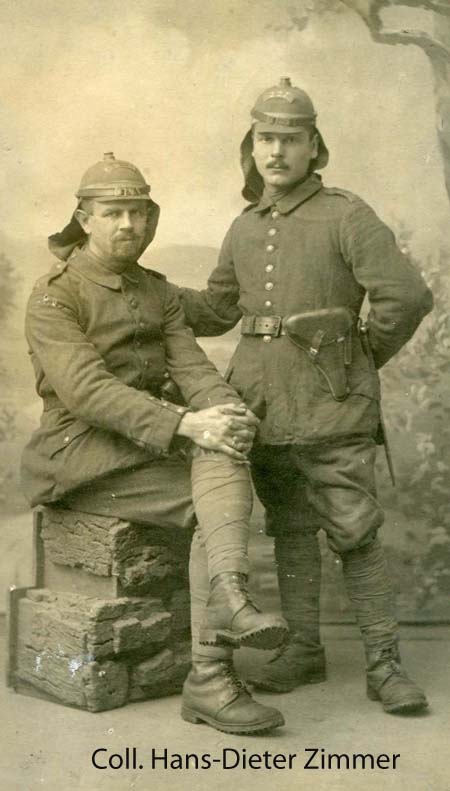
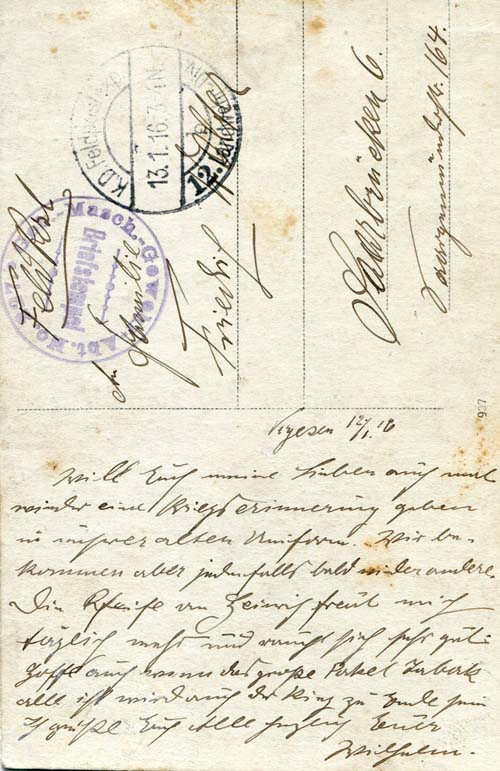
Then there is this, both the scroll and the helmet cover say 23. Infantry Regiment 23 was part of the 12th Infantry Division and never left France until Dec. 1916.
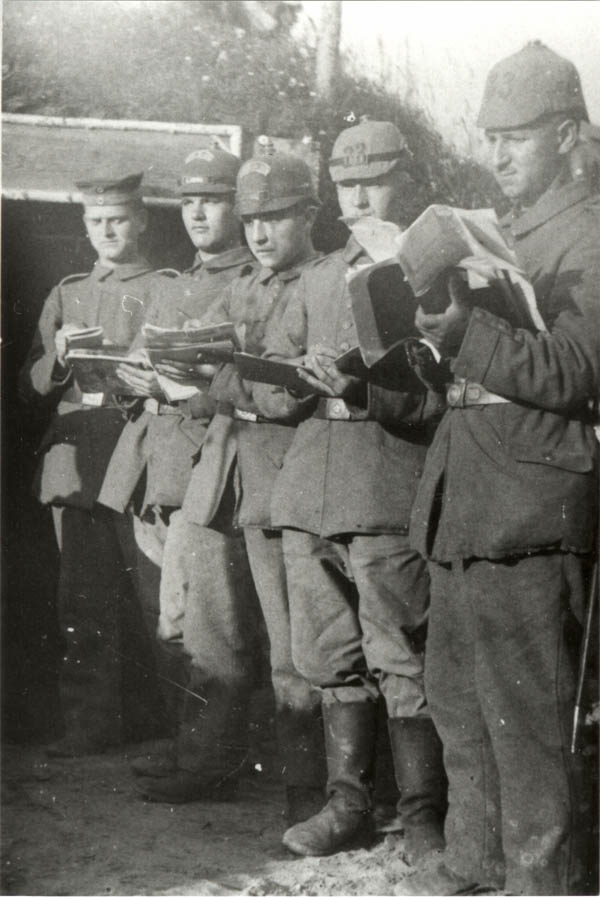
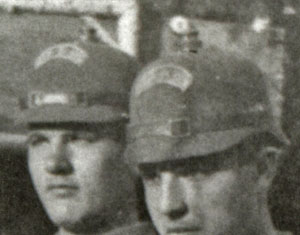
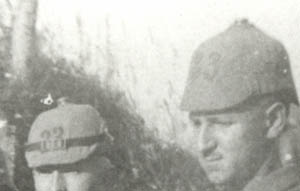
This incredibly nice picture from the collection of Sam Wouters poses more proof and questions. There is a sender’s address on the back that is totally clear. GMGA 218 which was part of the Bavarian 6th Landwehr Division. Based on the number this would be a Prussian unit in a Bavarian Division. It is dated June 16, 1916 from the Vogesen region of the Western Front. Notice that the clear Edelweiss badge on their collar. It looks different from the type worn by the Alpenkorps. Perhaps it is an unofficial variant worn by some mountain units such as this one? Or maybe a real flower?
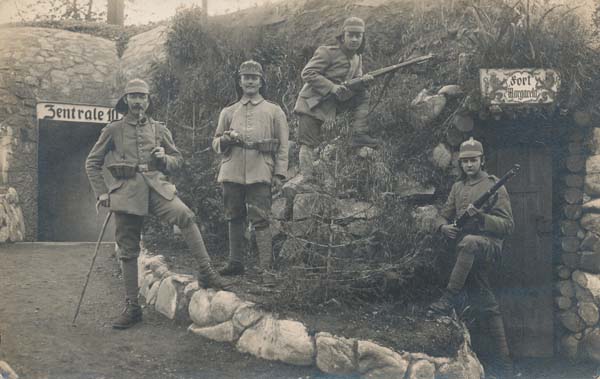
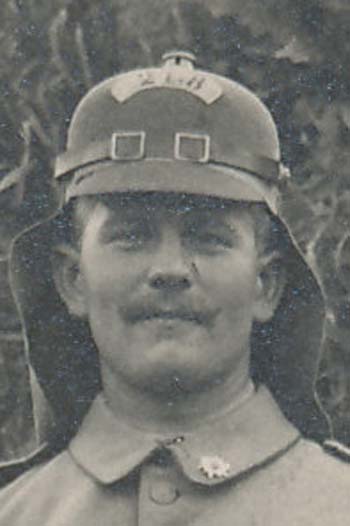
What Does It All Mean?
Precious little! I was once accused of being an obscurantist by a distinguished colleague. Conventional wisdom which had dismissed these helmets as a Serbian anomaly paid it far little thought. Based on expediencies and production these helmets were used in various locations. For instance I’m sure that the 122nd Fusilier Regiment did not exchange helmets upon their emergency redeployment to face the Russians in East Galatia. It also shows that there were several different variations on the theme and that this might help in identifying some helmets that are more legitimate. I would like to formally thank Robert Hinesley who kindly lent me a picture that got me going to finish this. He deserves more credit than you think.
Back to the Beginning
This all started out as a search for Reserve Infantry Regiment 22. Clearly this was a unit that served in France and unfortunately has been the subject of many reproductions. My understanding is that there were two waves of reproductions. One came from the old Czechoslovakia and was easily spotted as the filz was “squishy” instead of very stiff. The second wave came from Great Britain and could most easily be spotted by a brown leather like trim around the helmet. The example in the Johansson book is a type 3 with cut out letters. Most of the reproductions seem to have embossed letters. Here is an example that has the telltale marks of a reproduction unfortunately.
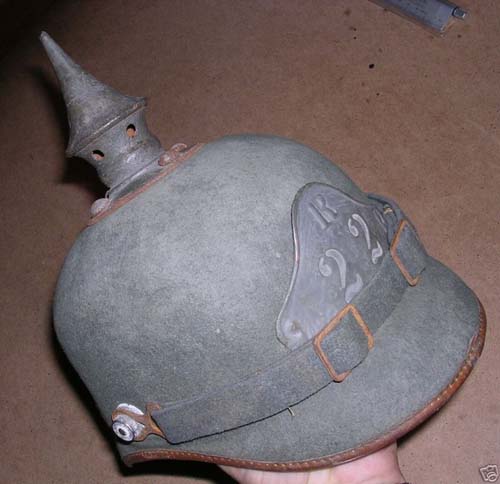
xii
There is a spike, and the telltale brown leather like trim. In addition there is a maker’s mark and a mark from the Bekleidungsamt IX Corps. This too appears faked as simple research would show that Reserve Infantry Regiment 22 was in VI Corps.
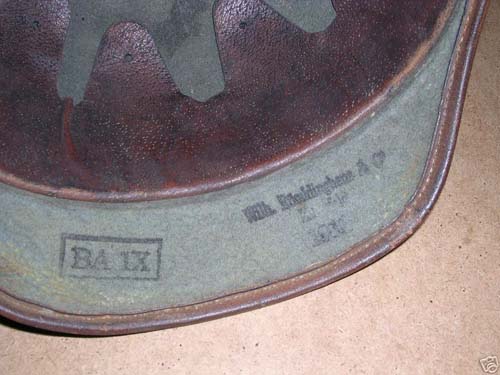
xiii
I wish I had better news about this helmet but I do not.
Please if you have any other pictures or examples that I can use I would be glad to include them in the analysis.

ii Kraus, Jürgen, Die feldgraue Uniformierung des deutschen Heere , Biblio Verlag, Osnabrook, 1999. (German) pg.88.
vi Wannenwetsch & Hilsenbeck , Konigreich Wurtemburg die Militärische Kopfbedeckungen 1869-1919 , Steinach-Verlag,Reutlingen 11 , 1993 (German)
All pictures from GMGA 238 and 247 from the Robert Hinsley Collection.
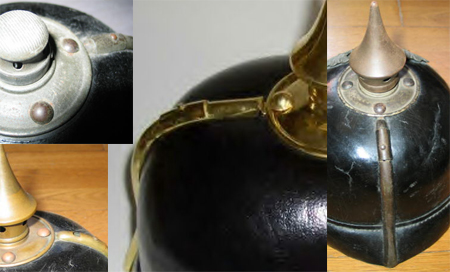
Pickelhaube Fakes and Doctor Jobs
Pickelhaube Fakes and Doctor Jobs
Joseph P. Robinson
22 Nov. 2007
We have all seen our share of questionable items. But how can I be sure? This is a tough one that all collectors sweat over. The guys who collect medals have bunches of fakes they have found. It makes my head hurt. It is a full time job with one or two truly trusted dealers. Pickelhaubes are starting to do the same. More forgeries, fakes and attempts to alter helmets to increase value. I was spurred to do so when I saw a helmet (OR Brunswick) go for over $2200. 100% of the people who wrote me claimed it was phony. It is necessary to get a black light. The black light test is not fool proof but it is a clue. The idea is that modern fabrics and paint will glow under a black light. Something to do with the chemicals used in production. So I though I would ramble about things I have found. Remember I only offer opinion so I might be wrong. If you have anything to send please do and I’ll try to add it.
Depot marks
| Clothing collectors have been fighting inked markings for a while. This on the left is a suspect depot mark. 1. Seems too small
2. The ink is perfect. 3. As one collector said “I don’t like Times New Roman Font on Pickelhaubes.” The easy focus is on the #9. Look at the suspect 9 and the one on the right or at the example in Lacarde Vol. 1 page 154. What would a black light show? We have a large article on depot marks at:
|
Unfortunately the fakes in felt helmets are getting pretty good. Be careful of marks that look like this. The real check is to see right off if the helmet in question could have been in IX Corps. This helmet and one other with the faux markings revered could not have been in IX Corps.
|
Galvano Copies
I know little of the metallurgy required in pickelhaubes. We will see wappen later in the article, but you often hear about galvano copies. Well here is a comparison. Not as easy as I thought to pick out from the front. What is important is to remember how plates were made in those days. A male and female half stamped together. So the detail on both front and back should be just as crisp. These pictures from the Braziel collection
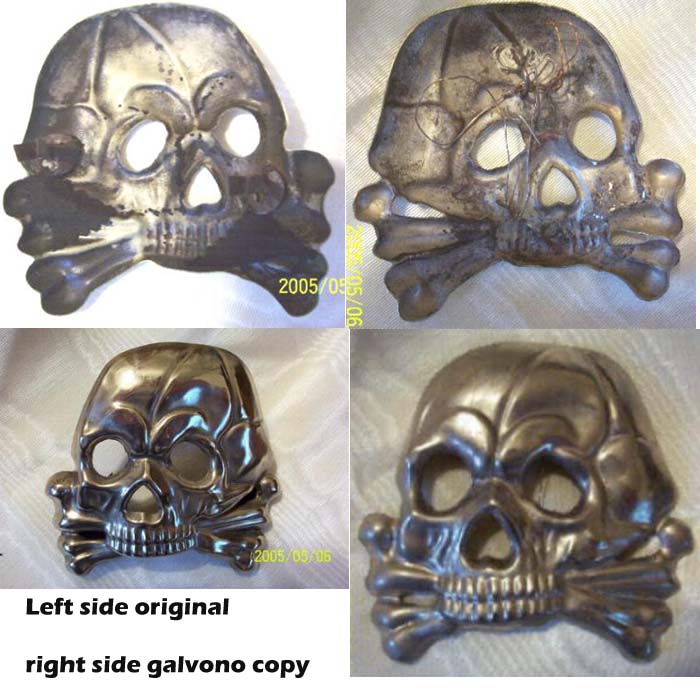

The 162nd and other Hansiatic cockardes.
I have seen too many of these. Pop off the Prussian and pop on the repro. Dig the repro cockade in your garden for a week and claim the helmet came from your grandfather in Hamburg. Charge huge money and some soul will buy it. They are after all very rare. The ONLY difference between a Hamburg Officer and a Prussian Officer is the cockade. If you see anything close to such a cockade be careful. For OR helmets the helmet must be depot marked to the Hansiatic regiment or you are buying a problem. It is instructive that even Saunders in his wonderful collection only has an OR 83rd. The landwehr cross for these regiments is distinct. So finding a landwehr helmet is a more sure bet. The cross has a different motto on it. Instead of the standard 25 mm line cross, the Hansiatic reserve cross only has the motto ‘mitt Gott Furs Vaterland” as they had a Bürgermeister, not a royal prince or titular head. Finding the correct reserve cross to add to a helmet in this case would be much much harder than finding a cockade. No I’m not stupid enough to believe that all Hansiatic helmets have the correct cross on them, but it is an additional clue.
Repro Helmets
Catalog Frankonia and others sell repro helmets complete as repros. Problem is folks turn around and sell them as original. Most of these helmets are very good but have mistakes. Recently I have seen a 2nd Gd. Uhlan “Officer” complete from Frankonia offered from Grandpa’s closet. Flat chin scales, OR Guard star, and wrong corps markings, non-officer field badge (not OR either) and OR brim. Still people bid on it. Others I have seen include a Non-voided line officer from Prussia, Hesse, Bavaria, Wurttemberg, Baden, same as above with ball. A pretty good Saxon OR arty and a series of shakos. Full helmets are mostly officer with very bright fixtures. Brass not gilt.
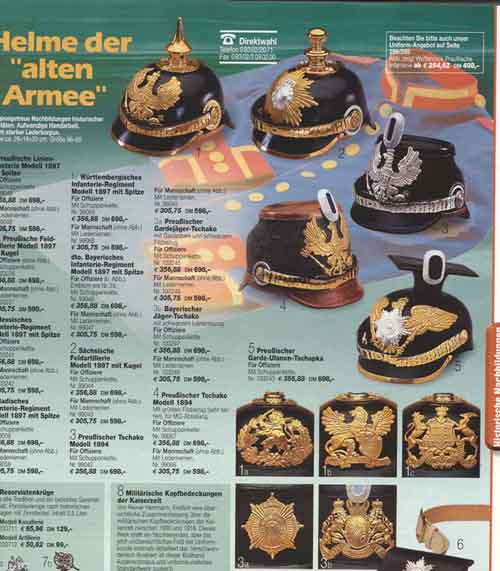
Great Wars Militaria and I’m sure others do a service to the reenactor community and sell a great deal of reproduced helmets. They custom make helmets even officer ones. They are very straight forward about what you are getting. Again the trouble comes from others selling a reproduction as real and duping a collector. Let us compare a few items. Liners can be very easy. Something to alwasys look out for is a very long machine bolt connecting the rear spine.Long bolts are normally a bad sign.

A large space between the helmet base and the vent device is another tell tale. Here are some originals and the one in the middle is a reproduction….too far away from the base. Originals from the Chen collection.
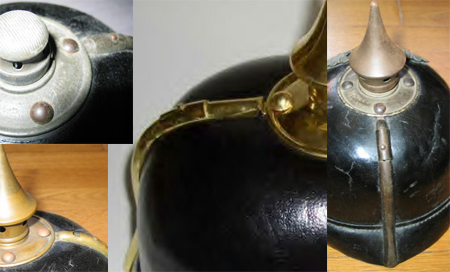
Look at the dome studs. Originals were pretty flat. Reproductions often have tall, big stud tops.The spike in the center top is a reproduction.
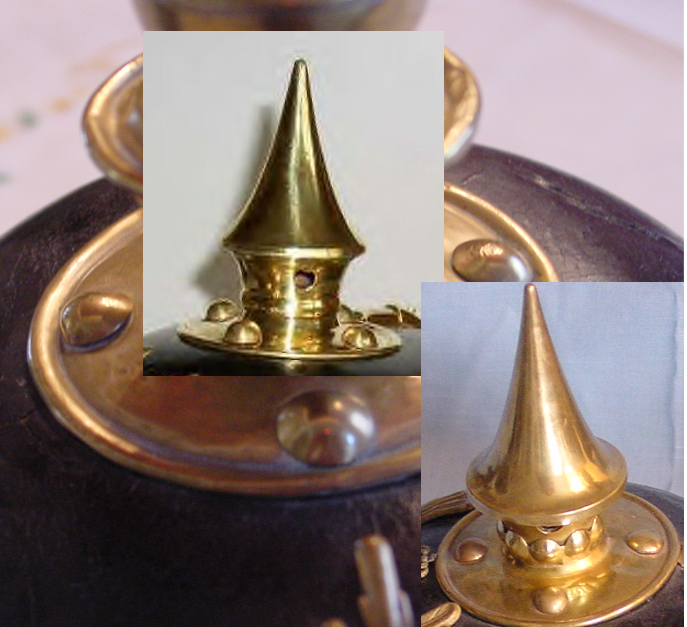
Repro Parts
The easiest and most used item is the chinstrap on OR helmets. Regularly easy to spot. This leather, smooth looks and feels brand new. Sold as repros but you see tons of eBay helmets with repro straps sold as original. If the leather straps were identical to the M16 steel helmet straps it made sense that these were transferred and the cockardes went missing. Many cockardes are repros. I have not been able to always tell which is which. Whole assembly’s are now being reproduced. Look at the spike and supports below newly minted. The repro Arty spike for the M15 is cool and comes with rust!
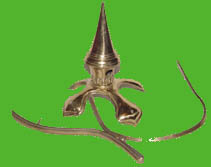

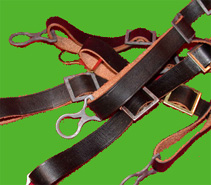
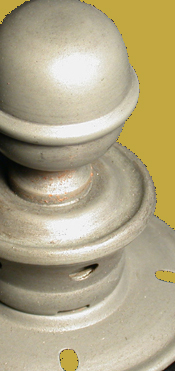
Gromets
The problem here is putting brass parts on a grey M15 helmet. The final tell tale sign is the grommet holes for the helmet plate. Brass on brass good. Grey on brass good. Brass on gray bad in almost all cases.

Its a One Year Volunteer (OYV) Helmet.
Read the article on OYV’s in this section. This is the biggest area of doctor jobs in the industry. Compare the article to dealer write-ups.
Dealer write ups.
Even paranoid people have enemies. Most — not all US based dealers I have seen make bad mistakes. Some are honest mistakes. Some are just trying to make a living by cheating folks. Be careful. Rate the item not the write up or the dealer’s reputation. I have been looked in the eye by a MAX certified dealer and one in England who clearly had doctor jobs. They refused to admit it. The good news is since our articles have started many many dealers and eBay sellers have changed their write-ups and added pictures of depot marks and the rear of plates. We flatter ourselves by believing that we had an impact but in general the level of informed collectors has risen through this and other sites as well as forums.
Double Holes and Doctor Jobs — look at this Hessian (next 2 photos from the Francom collection)
| We all know of double holes. Sort of. Many helmets have double holes or Döppellocher as new plates are added to old leather. So if I have an old helmet and a more valuable plate I marry them together and I make money. As there were hundreds of wappen makers the sizes varied for the placement holes. The very worst I have seen is the Hessian to the right that has double holes punched for a Prussian East-West eagle. Now new plates were added as helmets and went to Landwehr duty or switched regiments. For OR helmets ALWAYS make sure the markings match up. For Officer’s make sure the old holes are professionally filled. Pickelhaube dealers offered a refit service based on the huge price of the haube. |
|
Repro Plates
| Yes Dorothy there are phony plates. Normally called galvano copies these were molded using the galvano method. Less detailed with bubbly backs. A senior collector told me that there were actually inexpensive galvano plates made in period so patina becomes something. Look at the plate below and compare detail and patina with other brass parts. Looks funny don’t you think?
|
The next set of pictures shows a plate post and back made in Poland (with Permission) Look at the bubbles and smooth transition on the post. A couple of thoughts here.
1. Look for old gun metal colored solder. The posts or loops were not part of the plate and if you don’t see old solder something is wrong. Old solder came in globs. Not clean and easy to spot. Painted solder is bad.
2. Old plates were stamped new ones cast. So there is little detail on the back of the new ones.
3. If the finish of an officer’s plate is bright and polished wave off.
These pictures provided by an eBay seller.

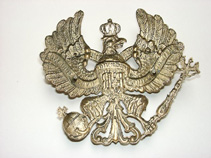
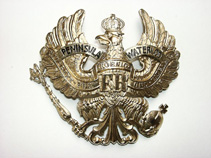
The plates below have all been properly advertised as reproductions.
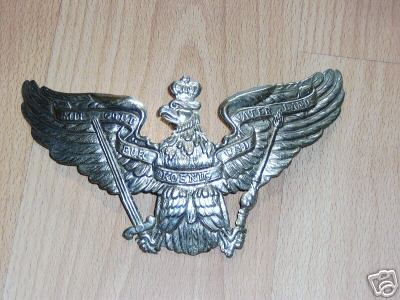

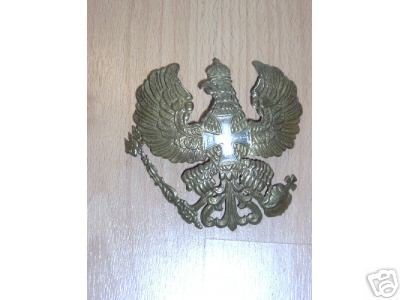
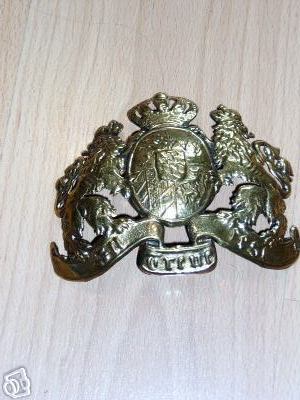
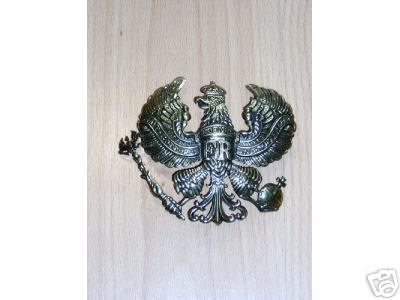
Liner
Look at the sloppy sewing job around the edge of the liner. You can see the machine sewing job as a dark line on the leather.
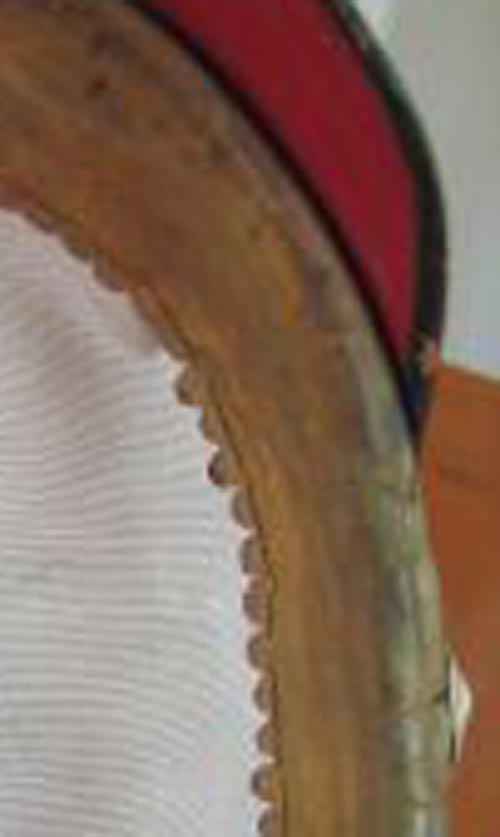
Fake Felt
Lots of fakes here. There is even a web site that tells you how to make a felt spiked helmet. A collector friend’s husband visited a factory in England where felt helmets were being made in the 1970s. There were also some fakes that came in through the Eastern bloc. Those were allegedly squishy. The standard filzhelme is quite hard. Most of the metal fittings look old or are old. There are even reportedly very good stamps of depot marks on the back of these helmets. Frequently they are non-sensical, marked to a Saxon in X Corps for instance. Frequently these depot marks are very clear and brightl. A black-light can work wonders on the threads of the liner. New thread will glow. Many fakes have a leather edge that goes all the way around. These are regularly light in color. I call them the chocolate colored trim. These pictures represent a modern trim and a helmet made to trick. Good example of a fake. Leather trim all around….. I know of no original made of Fliz. (Cork sometimes, very dark trim.) These pictures from the Booth collection.
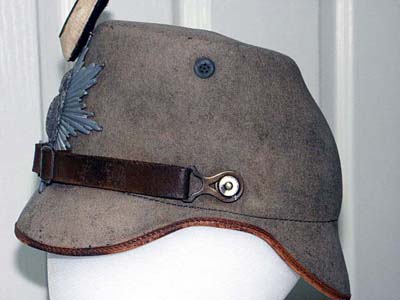 |
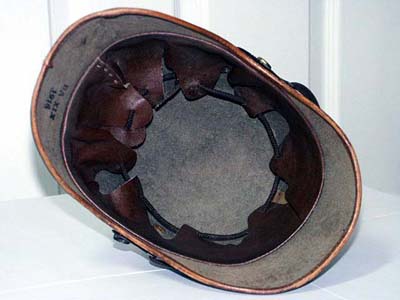 |
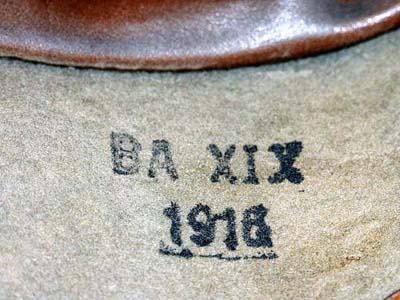
Odd Wappen
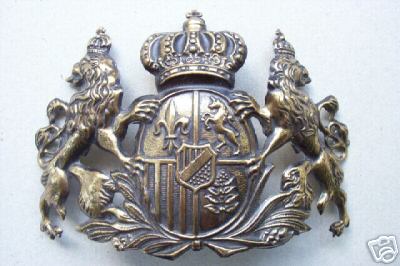
You have to be careful of wappen that you find that are not in reference books. The wappen above looks like a Bavarian wappen at first glance. But the excitement of finding a new, unknown wappen, has to be tempered by the discovery that this is actually a modern device used on a box of cookies.
Labels from Makers
These are getting very convincing. They have been often copied and used to cover holes and other sins. Look at the font! This example with tea soaked in the label might convince but is misspelled!
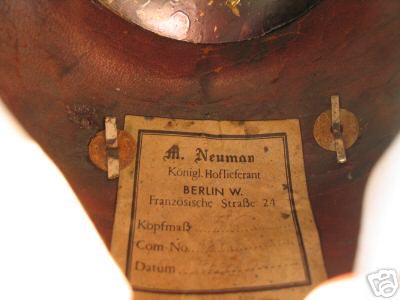
|
The R22 Helmet |
|
|
One of the most frequently encountered fakes is the famous R22 helmet. Also known as a scroll helmet these are discussed in some detail at: http://www.pickelhauben.net/articles/Scroll_helmets.html Johansson has an example of R22 helmet in his book “Pickelhauben” on page 60. It is a filz helmet with a ventilated spike base and a scroll with cut out letters. He calls the metal “pewter”, and states that the R22 designation stands for Infantry Regiment 22. There is no visor trim. It has a black leather chinstrap with gray metal buckles. This was obviously a rare example and if you could fake it you might be able to make a tidy profit and explain away some anomalies in the helmet as a rare variant. While often faked these have changed over time. Due to largess and humility of certain collectors we have two examples here that are 30 or 40-year-old fakes. Trawnik found these in an old collection and is sharing them with the community to help educate others to stay away from such tripe. It may be instructive to see how these were done. |
|
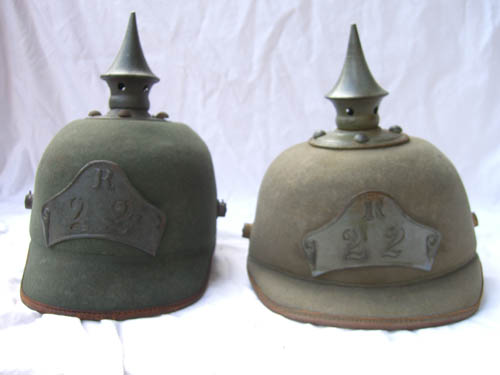 |
|
|
The word on the street was that these fake helmets came from two sources – one from Great Britain and the other from Eastern Europe. I believe these two examples are from Great Britain. Let’s look at the first one. |
|
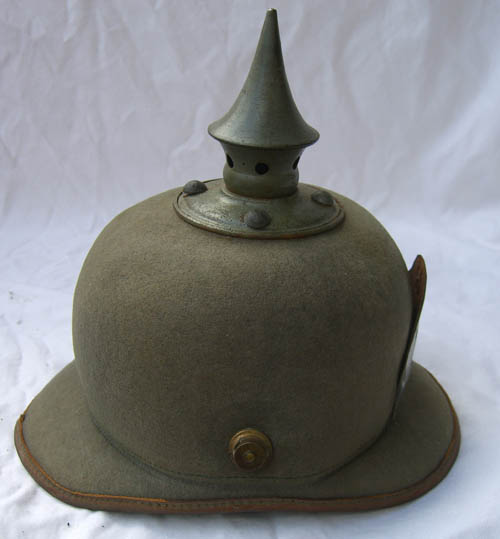 |
|
|
An oddly shaped filz helmet. A very rounded top with a leather trim all the way around. A gray metal spike and a brass M91 post. The gray metal items are magnetic. The Wappen is not flush to the helmet body. The round studs used to apply the spike based to the helmet body are very large. The spike base itself is unusual and the spike does not twist off like a normal M15. There is some sort of lacquer on the spike and spike base and the two pieces are quite static. |
|
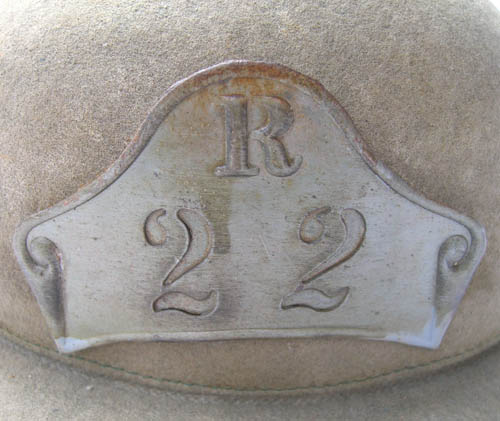 |
|
|
The Wappen appears crude. The letter “R” is embossed and you can see how it was pushed up from the back of the plate. The number “22” is recessed into the plate and you can also see on the back where it is pressed in. |
|
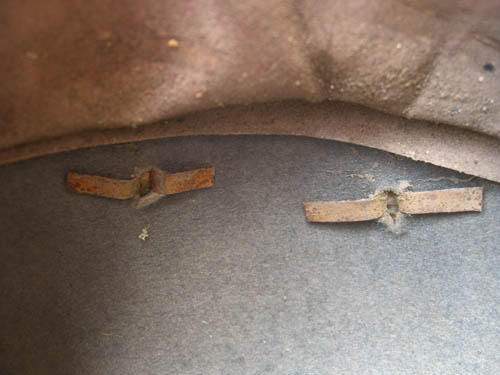 |
|
|
The Wappen is attached to the helmet through the use of metal prongs. These are set very low and resulted in the top of the Wappen not being flush against the helmet body. These prongs are metal. There are no grommets. |
|
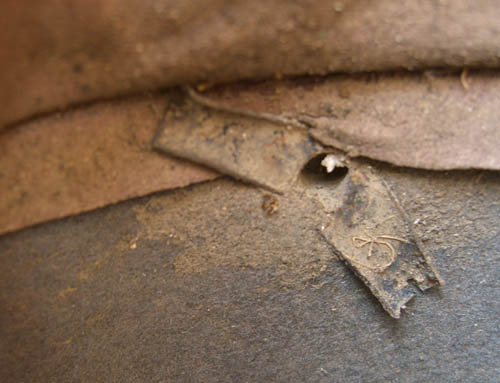 |
|
|
The M91 posts are attached with these metal prongs.
|
|
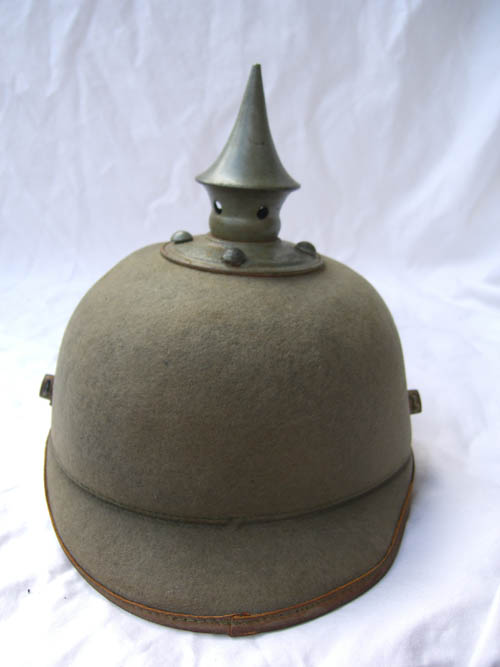 |
|
|
There is no spine on the back of the helmet. |
|
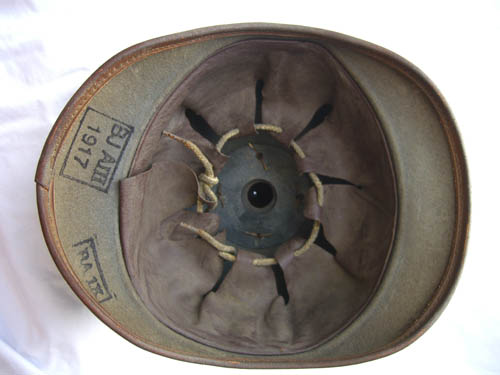 |
|
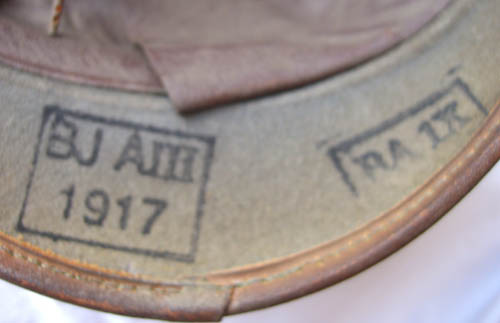 |
|
|
There are a series of faked marks on the rear visor. It is instructive to the collector that both the corps assignments as well as the typeset or font are dead giveaways of the non-originality of this piece. |
|
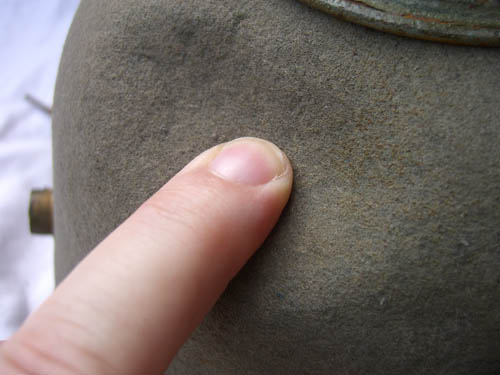 |
|
|
Known to be “squishy” this finger pressure should show a lack of rigidity of the helmet shell. The second helmet has many of the same characteristics but appears to be later production. The Wappen has deteriorated in detail significantly. The reproduction process has taken its toll as you can see by this example. |
|
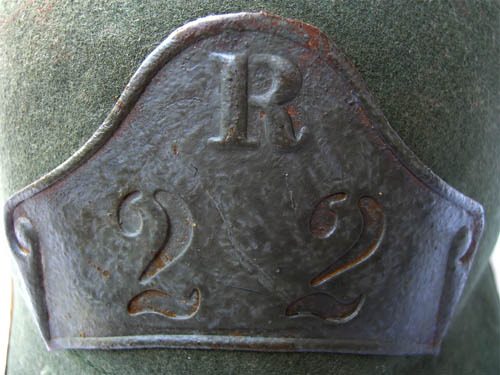 |
|
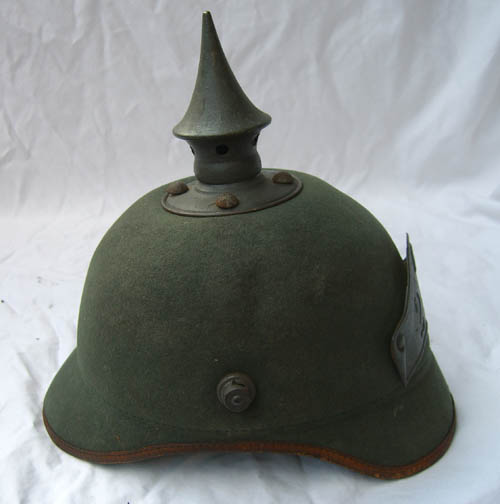 |
|
|
The material of the helmet is darker in color, all metal parts are a gray metal. The spike is still static and the Wappen still has a lean. |
|
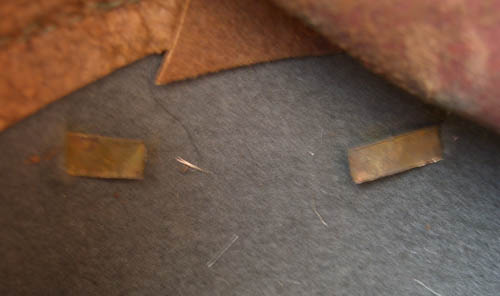 |
|
|
The method of attachment has changed with only one prong per side and this is placed into a slit instead of a larger hole. |
|
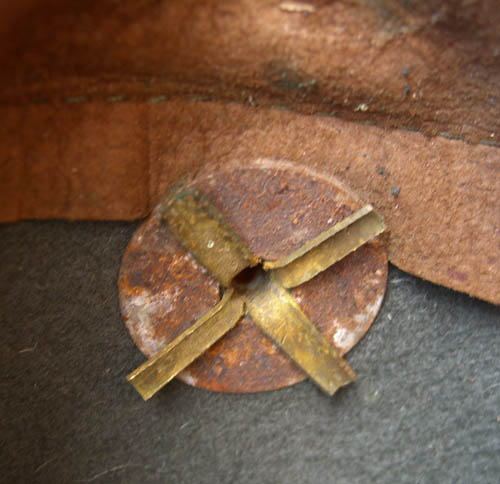 |
|
|
The M91 posts are attached in this way. |
|
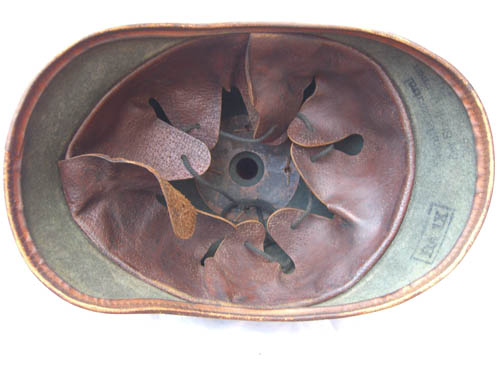 |
|
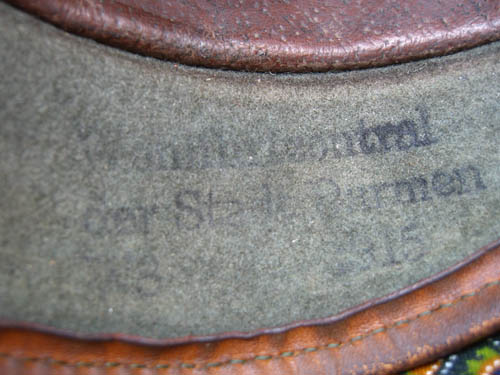 |
|
|
There have been changes to the marks and we are back to well-known fakes. |
|
 |
|
|
This helmet also was squishy. So these are examples of older helmets. Collectors might value seeing some of these characteristics. |
|
|
This article would not be possible without the kind contribution of pictures from a host of sources including the Trawnik, Francom, Booth, Braziel, and Chen collections.
|

Parade Plumes
Parade Plumes
Joseph P. Robinson.
15 November 2005.
Not a great deal has been written about the individual plumes used on pickelhaube. Randy Trawnik, in his new volume “Spiked Helmets of Imperial Germany” devotes an entire chapter to parade plumes. This short article is intended to augment the information in that volume. The book shows many pictures of helmets with parade plumes. This article will focus on pictures from the timeframe. There is no intent to discuss the feathered plumes of generals, nor the plumes on Ulan, Hussars or shakos.
Plumes came in three colors: red, white and black the same colors as a national flag.



These were not standard throughout however, as in general the first two battalions of guard regiments wore white plumes and the third battalion black plumes. Red was reserved for musicians, but also for certain Bavarian artillery. The general rule of thumb was that white was more elite.
The first generalization to ensure we look at is that not all regiments wore plumes. Only those authorized to wear plumes wore them. As a result, many helmets have spikes that do not unscrew to allow a trichter. Many private purchase helmets that were used in regiments that were not allowed plumes still had spikes that unscrewed. This was an inexpensive upgrade and aided in the transportation of the helmet. For some reason there is a legend that says only officers wore plumes; this is absolutely false. The real purpose of the plumes was for parade, those that did not parade, like a zahlmeister, did not wear a plume.
The second generalization is that enlisted soldiers wore horsehair plumes, and officers wore fuzzy buffalo plumes. In reality the plumes were first authorized in 1843. The trichter shape and size changed, and both officers and enlisted personnel wore straight horsehair plumes until 1896. There was a separation of commissioned officer, plumes in that year by allowing the wearing of a buffalo plume instead of a horsehair plume. Horsehair was easy to spot. Straight and kind of scraggly whereas the buffalo plume was more curly or kinky and more full. The buffalo hair came from a yak.



According to regulation of the officer trichter was supposed to be 15 cm long supplanted by a 4.5 cm button on top. There were many different styles of trichters and buttons. Those pictured below are a mere subset.






Another part of the regulation was that the plume itself would be trimmed with a pair of scissors. For troops on foot, the intent was to cut it to the top edge of the front visor. Mounted troops were supposed to have the plume cut to the bottom edge of the front visor. Photographic evidence shows that sometimes it is not easy to determine if length was applied properly.
The man on the left from the 92nd Regiment is cut properly for foot to the top of the visor. The gentleman in the center is from a mounted unit, and you can see how much longer his plume is. The photo on the right below it is of a foot unit, but you cannot tell that on the basis of the plume length alone.



The plume was to be cut to the wearing length regardless of the length of the trichter. Trichters did not always start off that 15 cm and older trichters were shorter as the helmets themselves were taller. Trichters “grew” as helmet size decreased.


Differences in the quality of the plume are easily described in the catalog by M.Neumann. Similar to helmets themselves, the plumes came in different qualities. The higher the quality, the fuller the plume was, and the higher the cost was. It is interesting to note that a white plume could cost as much as 50% more than a black plume.
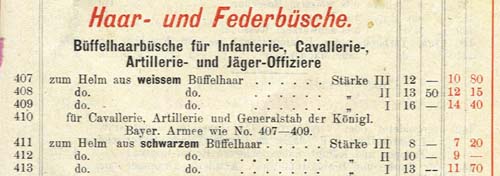
Enlisted helmets came with issued plumes. However, you could also buy one that was in enlisted quality. It is instructive that these came in two qualities. The lower quality was horsehair and the higher-quality was hair from the horse’s mane. As opposed to buffalo hair these were extremely cheap. You can also see on the bottom of the chart that you could get an extra light trichter for a substantial increase in cost.

The 1903 enlisted uniform regulation specifies that the enlisted trichter is somewhat shorter 11 cm high. The button on top is somewhat smaller, and the design on top is plain. Private purchase trichters tended to be shaped like a spike with the plume on top. The issue trichters, looked more like a tube.


As with many items in the enlisted regulation, the weight of the parade plume was very important.

Again, this is only a beginning to supplement the information already available.
Pictures come from the author’s archive, the Kostel collection or with permission of the owner. Translation assistance from Roger Benner. Catalog is price list 29 from Neumann undated. The enlisted uniform rate is a 1903 version printed by Mittler and son.
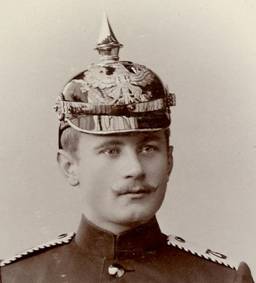
One Year Volunteer (OYV)
One Year Volunteer (OYV)
Joseph P Robinson
June 24 2009
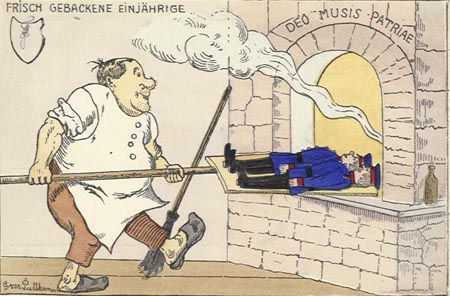
I have been tardy in rewriting this article. The original one was a bit confusing and I have learned more. We are only talking about 2 or 3% of the population. The vast bulk of citizenship did not have the social standing or the finances to join this crowd. In old photographs the one-year volunteer can be identified by the striped nature of the shoulder board edges.
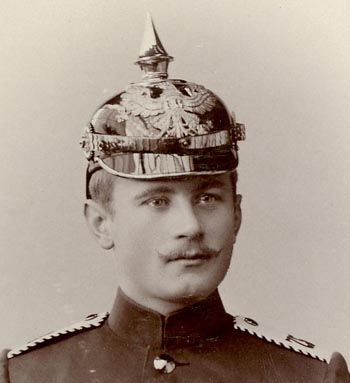
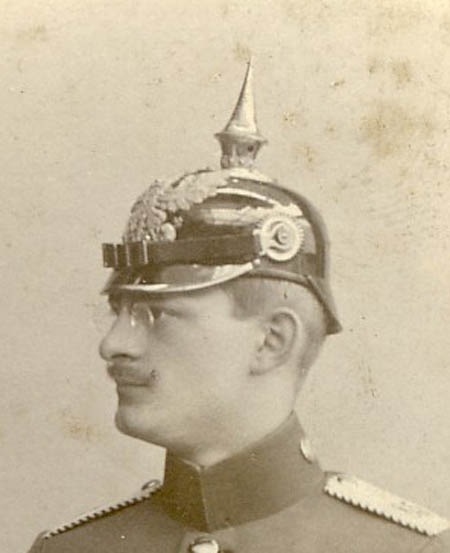
Based on a group of some poorly cited references that existed several decades ago, stories have been told and retold and handed down from collector to collector. Many of those stories are wrong. In the later decades of the 20th century there were few reference texts in the English language about pickelhaube. The volumes entitled The Pickelhaube by J. A. Bowman Imperial Publications, 1989 and 1992) and Pickelhauben, by Eric Johanson (H.S.M. Publications, Independence, MO, 1982), were the choice references in English. These broadened collectors understanding and created a foundation that many collectors still base their beliefs on. I call that conventional wisdom.


Conventional wisdom puts helmets into three categories. Officer, enlisted (OR), and everything else is identified as a One Year Volunteer (OYV). It is how I learned and questioning what I was told led to this research. The famous book by Johansson does not list Fähnrich or OYV in either the glossary or index i.
Many collectors didn’t even understand the term, “one-year volunteer” (in German, “Einjährig-Freiwilliger”). If a helmet had a mixture of officer and other ranks parts, it was identified as being a one-year volunteer helmet. To many collectors it had long been common knowledge that OYVs would become officers at the end of their year and possibly change helmet parts over time to show their new status. Eventually the officer might move to the reserves or the landwehr. References came out showing the Allerhochsten Kabinettsordres (AKOs) changes to officer and other ranks helmets. Many collectors decided that anything that didn’t fit these AKOs was a one-year volunteer helmet.ii Much of this understanding is wrong.
Everyone who could afford it became a one-year volunteer – wrong, wrong, wrong.
The education system in Imperial Germany was significantly different than American understanding. The vast bulk of the common population attended a free Volkschule. This ended at age 14. Only a very few had the family resources to continue on and fund the education.
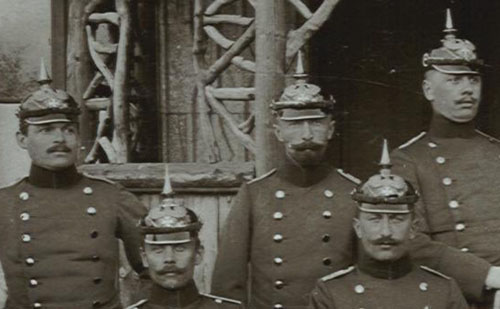
Receiving a reserve commission was the most sought-after goal of students, even those with the Abitur. There was a huge difference between a regular officer and a reserve officer. Reserve officers sometimes tried to pretend they were regular officers but they were not. Considering that you had to do universal military service time, the law gave the educated student a way out. Young men who had earned their One Year Certificate could elect to serve just one year of their compulsory military service on active duty to avoid delaying their university education or other employment. This does not equate exactly to American school understanding. A One Year Certificate was actually earned at the end of the Untersekunda year through an examination. Students in the six year school could take this examination as well as students after their sixth class of the nine year school. Only one third of those eligible and possessing a one-year certificate continued on into the military. Most were discharged being found not physically fit. (It is not the intent of this article to discuss eligibility, acceptance or Musterung.)
There were two different types of Freiwilliger; multiyear and one year. Multiyear Freiwilliger were basically enlistees. Given an application to a specific unit substantiating parental permission, and the family’s ability to do without them, they could apply for two, three or four year status. The Unteroffizieres would vote to accept them or not. This was not comparable to a one year volunteer and the family did not pay for the equipment and sustainment of this kind of a volunteer. While much understanding goes into the volunteers 96% of all soldiers were draftees.
Religion played an important part in the acceptance process. It is instructive however that in 1913 almost 46% of all Jewish soldiers were one year volunteers. This is as compared to 2% of the Protestants and 1.5% of the Catholics. Here you have the Jewish soldiers being of higher social standing than many of the common soldiers creating a resentment. iii.
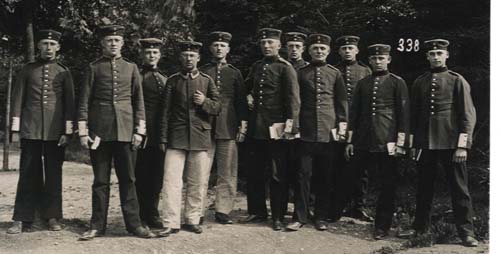
One year volunteers became officers – wrong, wrong, wrong.
Some one-year volunteers became officers. The OYV could become an officer aspirant in the reserves if he wanted to, was recommended by his active company commander, and passed or requisite tests at the end of his year of service. If the one year volunteer did not meet all these criteria he could be passed into the reserves as a normal OR or as an aspirant NCO. If all of the criteria were met, he would become an officer aspirant in the reserves and promoted to supernumerary Unteroffiziere if he was not already at that rank. The officer aspirant was intended to go to two different training sessions. One session per year after he took the aspirant test and left active duty. While only two sessions were required, these were normally accomplished over a period of several years. In some cases this took quite a few years and commissioning was delayed until the ages of 27 or 28. During this first session, he was instructed on how to be a platoon leader and took a test at the end of the eight week session. If the individual passed this test, he would be promoted to Vizefeldwebel. iv.
Of those completing their one year only every second recruit was recommended by the company commander as a potential officer. One third of those who entered military service went on to become reserve noncommissioned officers. And 13% were discharged without any promotion. v. A Bavarian army example in 1906 showed that 43% of the one year volunteers left service with the recommendation of the company commander. Of that group only another 43% or a total of about 18% of the 1906 one year volunteer intake, actually received a reserve officer commission. vi.
One-year volunteers were like officers – wrong, wrong, wrong.
OYVs were neither officers nor officer aspirants. They were OR types. They were enlisted men. Fritz Nagel was an OYV. In his 1962 memoirs he detailed his position as a OYV. “And nobody spoke to us. In our battery we were five one year men completely separated socially from the others. We were still considered common soldiers.” vii. Yes, they were different and privileged and after time they could become officers but calling a OYV an officer and looking at them that way is wrong.
A one year volunteer (OYV) had to equip themselves (rations, quarters, uniforms and equipment). They had to pay for it all to include a horse (if needed) or had to pay into the remount fund. The cost was pretty substantial. It was considered to be generally equal to the cost of a year at university, and very much dependent upon which kind of unit a one year volunteer decided to go into. He could choose his regiment; however, infantry, jägers, engineers, and foot artillery were expected to pay between 1750 and 2200 marks for their year. Field artillery and train increased the cost from 2300-2700 marks. But for cavalry and mounted field artillery, the costs soared to 3400 to 3600 marks a year. viii.
The payback was.
1. The OYV only had to do one year of active service before being transferred to the reserve. This was in place of the 2-3 year active requirement.
2. The OYV could start military training at age 17 at the earliest. The normal guy, who was more like a draftee started at age 20.
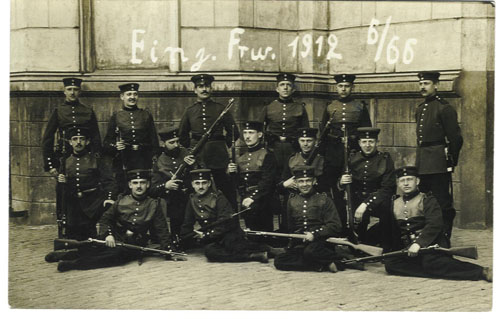
OYVs could join the service with their class on the first of October each year. They were grouped together with the other one year volunteers and their training was separate. Often their training consisted of only a few hours a day.ix. After three months they could be put into a special course, and after six months, if all went well, they could be promoted to supernumerary Gefreiter. The best of the class after nine months, could be promoted to supernumerary Unteroffizier. All this talk about supernumeraries is a reinforcement of the understanding that these guys were extra or supernumeraries to the establishment. One year volunteers were sometimes allowed to eat in the officer’s mess. Not with the officers of the regiment but in a separate room. x.
There was a conscious class distinction between the one year volunteers and the “common soldiers”. Not only was the training separate but the one year volunteers were from a higher social standing. The only way the “common soldiers” got back was to require the one year volunteers to buy a round of drinks. For many of the one year volunteers military life was the first time they had come in contact with the lower levels of German society. One of the most common ways to differentiate these classes was that the one year volunteers refer to each other using the formal “Sie”. Lower-class soldiers also use this form of address for one year volunteers. “Common soldiers” used the more familiar “du” when addressing each other. xi.
Medical OYVs were yet different with a 6 month OR requirement in the active force and they jumped to full commission in the Medical department for the last 6 months as an Assistant doctor, Einjahrfrewilligeartz. xii.
The uniform equipment of the one-year volunteer required everything to be purchased privately wrong wrong wrong.
All of the four armies of Imperial Germany followed this basic method. one-year volunteers had to pay the unit for their service. Additional equipment and uniforms could be taken at their own expense and risk. You need to read in detail first this section of the army order. Then read the further clarification in one of the one-year volunteer manuals. This one is particularly clear even though it is specific to the field artillery.
Attachment 2 to § 19 of „Heerordnung“
Uniform, food and equipment of one-year volunteers
1. Any OYV has to buy the required pieces of equipment and uniform out of his own money. During their one year of service they have to care about food and accommodation by themselves during peace-times.
Pieces of equipment including horse-riding equipment are supplied by the respective military unit against payment of an annual compensation for use, wear and tear of such equipment. Weapons shall be supplied under the condition of due care by the OYV who has to keep them in proper and serviceable condition and who has to hand them back after leaving active military service.
2. If a OYV is using his privately purchased uniform he is doing so under the risk that his unit may refuse this uniform in case it is not properly manufactured according to military specifications.
Any OYV therefore may be interested in purchasing his uniform and equipment through the Garment Committee (Bekleidungskommission) of his unit against paying the officially budgeted prices (Etatspreise).
3. If a OYV may find himself in the difficult position to officially declare that he won’t be able to further financially support himself during his remaining period of service and if it doesn’t seem to be justified to support him granting free access to free meals and accommodation through his unit according to § 94,12 of the “Wehrordnung”, he may lose his status of being a OYV and therefore will not be transferred to reserve status after one year of service. Costs incurred by purchasing uniforms and equipment will not be redeemed in such case.
4. Any pieces of uniform remain being property of the OYV after regular discharge (after regularly being transferred to reserve status). Pieces of equipment have to be handed back to the military unit.
5. In case of mobilization a OYV will be fed and equipped on expenses of the army like regularly enlisted men. Field serviceable pieces of uniform in the property of the OYV can be kept and used; garrison serviceable pieces may be transferred to the respective “Ersatz” unit; in both cases the estimated value has to be paid to the OYV by his unit. Any compensation paid by the OYV to use official pieces of uniform and equipment shall be redeemed by his unit of the first day of the month in which mobilization was ordered.
6. Upon demobilization the OYV shall hand back all pieces of uniforms and equipment he has received from his unit. If they are not transferred to reserve status upon demobilization the OYV again has to care for uniform and equipment by himself. If he would like to keep pieces of uniform and equipment after demobilization he has to refund the respective estimated value to his unit.
| Wernigk, Major and battalion commander in FAR 57 Handbook for OYV of the field artillery 11th edition, E S Mittler & Sohn, Berlin 1908 I Uniform and equipment, horses, food and accomodation of OYVs 1. OYVs have to purchase and maintain uniforms and equipment on their own expenses. If it may be assumed that of each piece of uniform, except the coat where just one piece will be sufficient, two pieces will be required, the estimated value of the uniform pieces supplied by the regiment will be 129.40 M = approximately 130 M All pieces of uniform paid that way shall become personal property of the OYV. Extra pieces Estimated need of repair Additional costs Total costs of uniform and equipment for a OYV are as follows: Uniform pieces supplied by unit 130,– M Altogether 784.55 M of costs of uniform and equipment of which 134.55 M had to paid to unit right at the start of the one year service. |
One year volunteers with thick visor trim helmets.
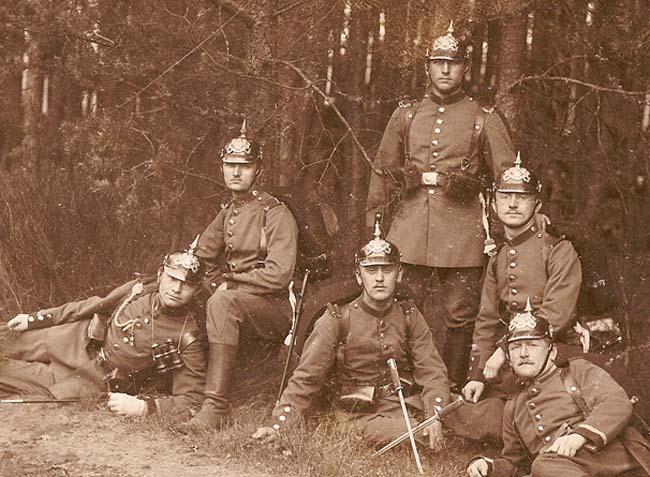
The Helmets (you will often see Fähnrich helmets and one-year volunteer helmets advertised interchangeably – later you will see that the helmets were pretty much identical) The reader should be cautioned that the helmets attributed to one year volunteers could also have been bought by a simple private, simply a purchase which adds to the confusion.
The one-year volunteer had to buy their own helmet ( private purchase or Eigentums helms) amongst other items. There were in general three different kinds of helmets. One-year volunteer helmets are easily identified by having some or most of the “officer” embellishments – but not all. There does not seem to be any specific guidance as to which “officer” embellishment would be added or not and one-year volunteer helmets vary greatly. It seems as though the driving force was how much you were willing to pay for the helmet. Cockades size does seem to have mattered.
The first kind of helmet is one bought by a one-year volunteer from a retail vendor for the purpose of being a dress helmet. If the individual was going to go on to be an officer, this type of helmet could be converted by the retail vendor in to an officers helmet. These are the most commonly found helmets—and also the ones that are changed the most. Unfortunately some collectors look at these helmets and say: “Gee there is something wrong with this – if I just change this one thing, I can fix it and return it to being an officer helmet.” Remember that only 18 to 20% of one-year volunteers ever became officers – reserve officers.
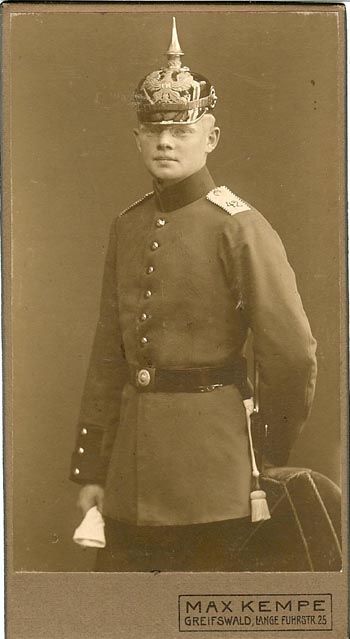
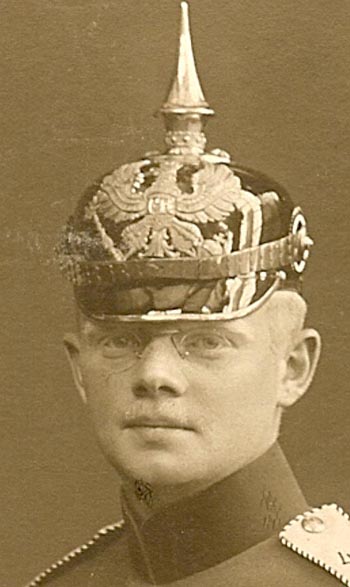
Let’s look at the standard one-year volunteer type helmet. This one, from Bavaria, offers a mixture of parts that can confuse some collectors. The front visor trim is thin, the rear spine and the liner are clearly officer quality. There is no pearlring, the chin scales are clearly for enlisted helmet, the front visor trim is round, and the spike base is round like an enlisted helmet. It has enlisted 48 mm cockades. So this is an enlisted helmet with some fancy upgrades. A classic non-converted one-year volunteer helmet. It could also be a helmet use by a standard private and purchased by that individual.
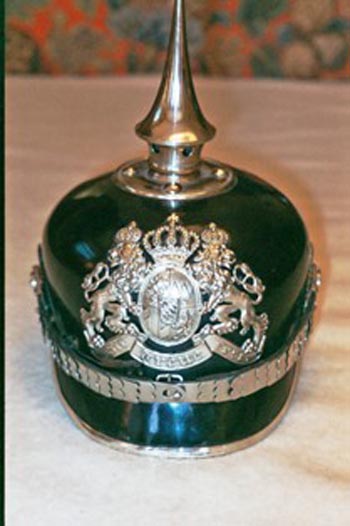
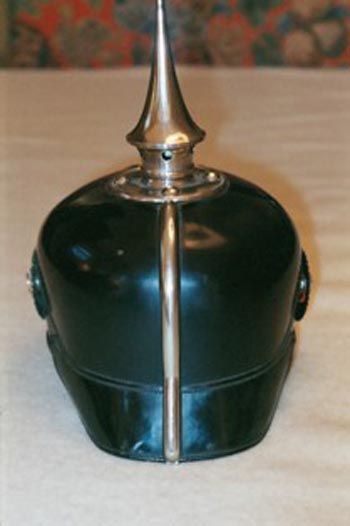

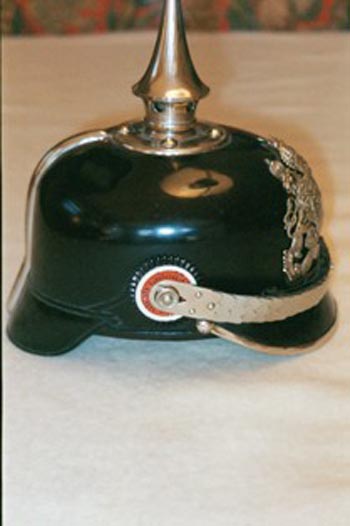
The second kind of helmet is called a Diensthelme—or service helmet. These were a lower quality helmet used for everyday use and were as a result less expensive. The most identifiable parts of these helmets is that regularly the visors are leather colored underneath, and they often have a thick visor trim. A Diensthelme could and often would be converted should the one-year volunteer become an officer. These are found in many varieties to include leather liners as well as a more traditional officer style liner.
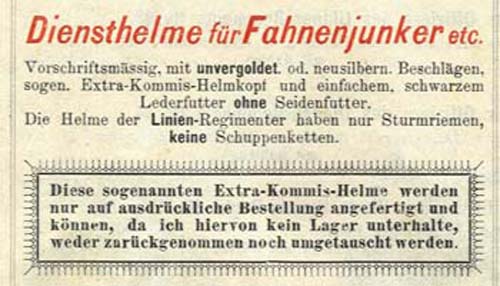
The Baden helmet pictured below is a classic Diensthelme. Private purchase, fully converted to Officer grade. That telltale sign of the conversion is that the undersides of the visors are leather color. Many retailers during that time put disclaimers in their catalogs that said they would not be responsible for conversions.
The third kind of helmet is an issue helmet use by one-year volunteer. These were literally rented from the unit for the year and had to be returned. It seems as though everyone had one. They are often found as a normal enlisted helmet complete with depot marks but then having a owner’s tag identifying the owner as a one-year volunteer. As the one-year volunteer was supposed to buy all of his equipment, it is not clear how the one-year volunteer ended up with the issued helmet. The two possibilities seem to be that the company actually issued them some of their equipment or that the one-year volunteer was allowed to buy issue equipment for their own use. As a subset to the first idea, it is possible that issue helmets were used during reserve and Landwehr call up times for training. A soldier could then stick a personal tag into the helmet.
Let’s look at an example. This helmet is clearly for the Guard Train Battalion. There are depot marks, a wide visor trim, enlisted chin scales and spike. Yet it is clearly identified as a one year volunteer.
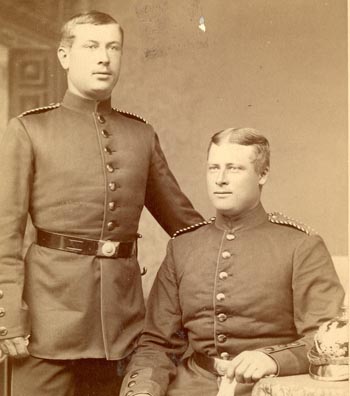
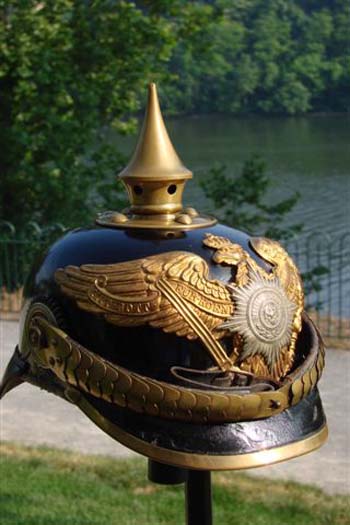
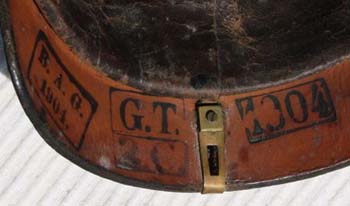

Conversions
Clearly not all helmets had to be converted. If you had no desire or ability to become an officer why bother? A one-year volunteer that did not go into the commission ranks of the reserves still did their reserve time just like a normal draftee. Still considered something special – these more educated soldiers often ended up doing administrative functions.
Those that were to go on to commission had to make several decisions. Should they get new helmets? Very expensive but very nice and often given as gifts to the new officer. For a far less cost the helmet could be converted. Much of this could be done by the owner himself. For instance, star studs, cockades, and a reserve cross could be upgraded at minimal cost.
Some conversions were significant. It is a monument to frugality that Bavaria and Württemberg converted helmets. For those two kingdoms the spike base itself and the visor had to be changed. Officer helmets had cruciform spike bases and squared front visors. One-year volunteer helmets for those kingdoms had round spike bases and rounded visors. Let’s look at an example that clearly shows old holes left over from a round spike base.
This is a fully converted helmet from the Avery collection. A wartime M15 officers variation that still has the telltale holes from the older round spike base.
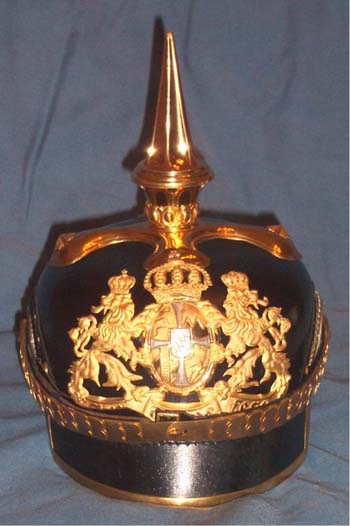
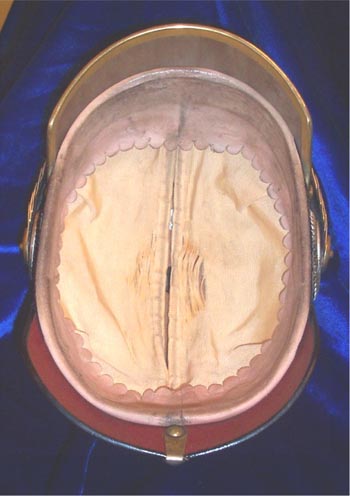

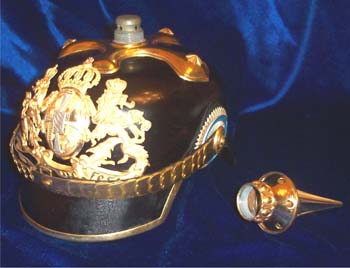
The helmet above has a nice reserve Wappen with a Landwehr cross. This is totally consistent with a reserve officer. The one-year volunteer however chose what ever regiment he wanted and in peace time there were no reserve units to choose from. So the one-year volunteer helmet would be an active Wappen. Then during the change, as a reserve officer he would add a cross. This necessitated plate changes in many cases. As a result, many double holes were caused by the conversion of active one-year helmets to reserve officer helmets. Finding a helmet with double holes from a former one-year volunteer should not be a showstopper. However, most collectors think all double holes are bad. This picture shows the double holes from the helmet above.
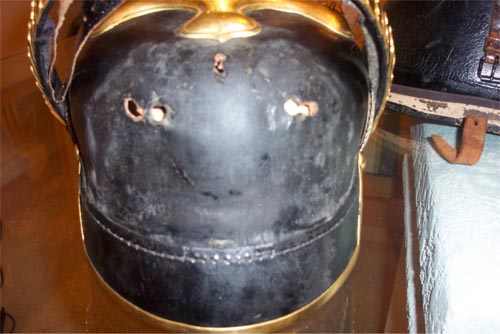
In addition to the holes there was often a problem with the Wappen themselves. For instance, the Baden plate for a reserve officer had no motto. The motto itself was found on the Landwehr cross. An active Wappen for a one-year volunteer should have a motto on the bottom of the Wappen. When converting the one-year volunteer faced a choice. Buy a completely new Wappen with out the motto or just spend a few cents to buy a cross and attach it to the old Wappen. Various forms of attachment and mottos are found on many converted one-year volunteer helmets. The Diensthelme from Baden shown above has the correct Landwehr cross attached to a formerly active Wappen with motto. This Landwehr cross is only primitively applied. As to be expected without a Wappen change there are no double holes.
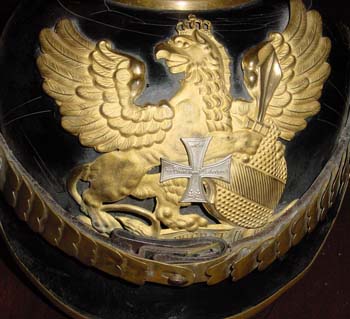
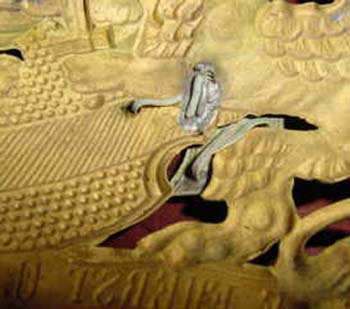
Metal Helmets
There were one-year volunteers in the units that had metal helmets also. And while these were expensive they could also be converted.
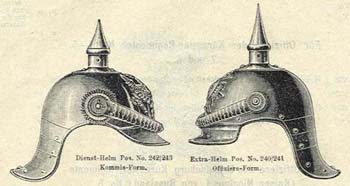
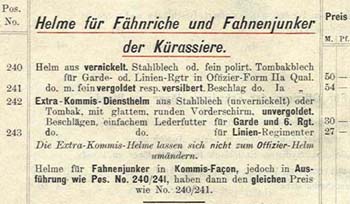
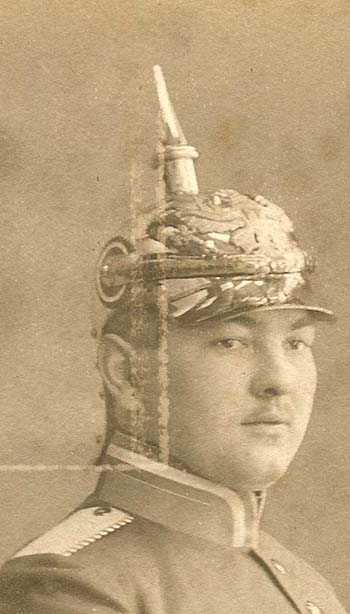

The Individual States
Some states had some very distinct issues when dealing with one-year volunteer helmets and their conversion to officer helmets. Remember the one-year volunteer was in an active unit and therefore there was no Landwehr cross. The one-year volunteer got a reserve commission. Therefore he needed a Landwehr cross.
Baden From the Baden example above you can see that Baden’s significant difference comes from the motto on the Wappen. Absolutely correct would have no motto on a reserve Wappen only the motto on the cross. Many if not most Baden reserve officer Wappen have both the motto on the Wappen and the cross.

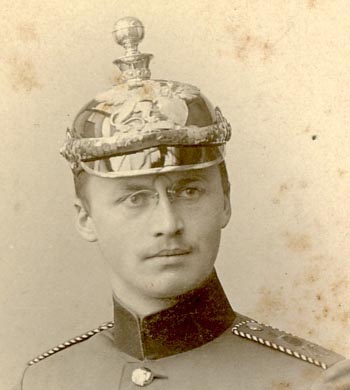
Bavaria There were significant differences between a one-year volunteer helmet and a commissioned officer helmet. The one-year volunteer had to replace both the spike base as well as the front visor. One-year volunteers also needed a reserve Wappen.
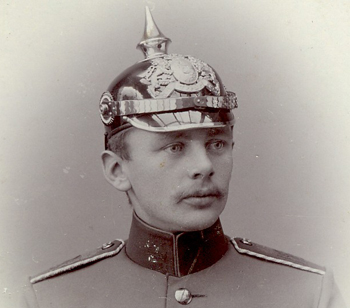
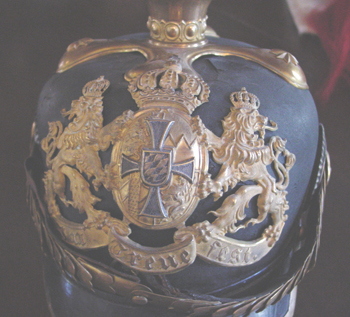
Hanseatic States Only the cockade need to be replaced in addition to the upgrades needed to make it officer helmet.
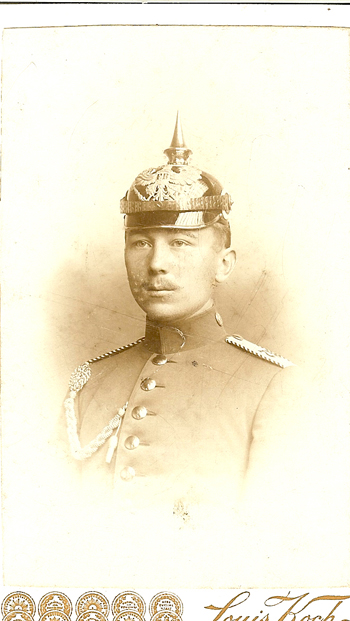
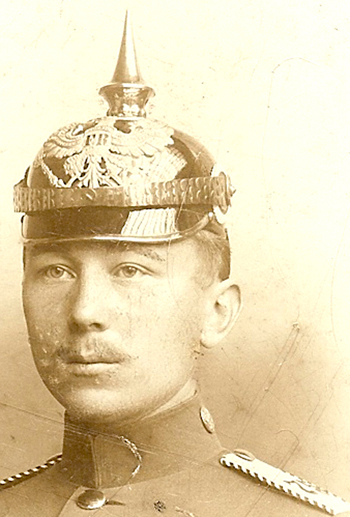
Hesse These were always significantly different anyway. Photographic evidence seems to show these helmets being more officer like requiring few upgrades.
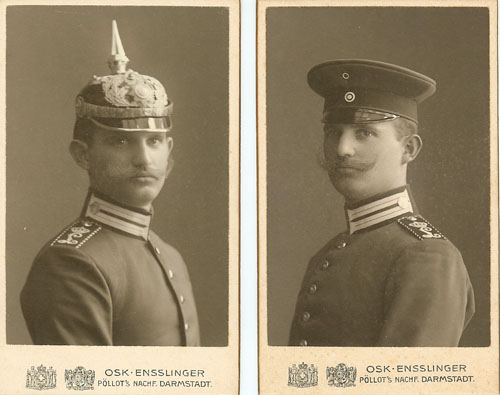
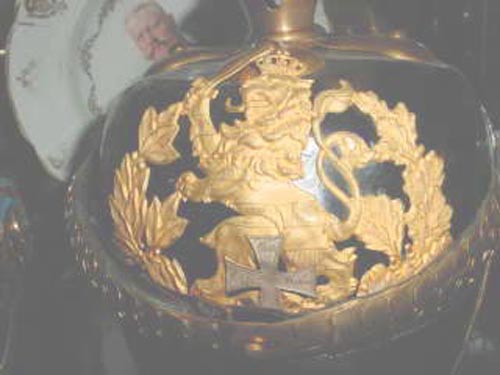
Mecklenburg In addition to any upgrades required for the officer helmet, the one-year volunteer needed to add a Landwehr cross to the Wappen.
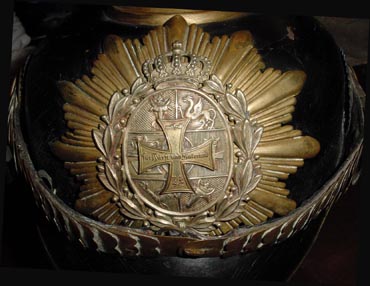
Prussia In addition to any upgrades required for the officer helmet (which could include adding enamel – or a whole new Wappen), the one-year volunteer needed to add a Landwehr cross to the Wappen. Absolutely correct would have no motto on a reserve Wappen only the motto on the cross. There was a different reserve Wappen from the active Wappen. The reserve Wappen had no motto but a large FR on the chest of the Eagle. Landwehr crosses are found on both kinds of Wappen.
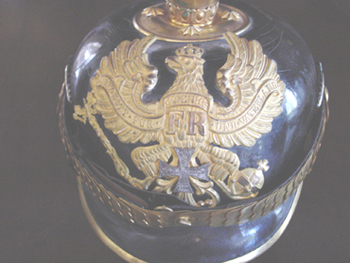
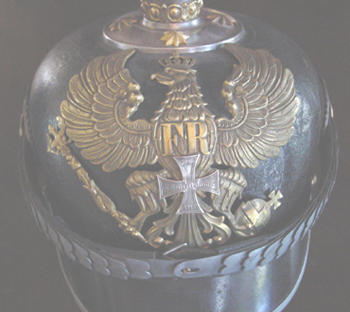
Prussian States Those states such as Oldenburg, Brunswick and the Thuringian States generally follow the same rules as Prussia. However, there is still controversy whether in all cases the distinctive crest of the state covered an FR or existed on a Landwehr eagle.
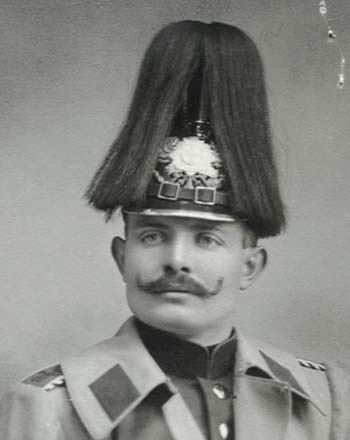
Saxony In addition to any upgrades required for the officer helmet, the one-year volunteer had to replace the Wappen from an active Wappen to a reserve Wappen with a built-in Landwehr cross.


Württemberg Similar to Bavaria, There were significant differences between a one-year volunteer helmet and a commissioned officer helmet. The one-year volunteer had to replace both the spike base as well as the front visor. The one-year volunteer could add a Landwehr cross to the existing Wappen.

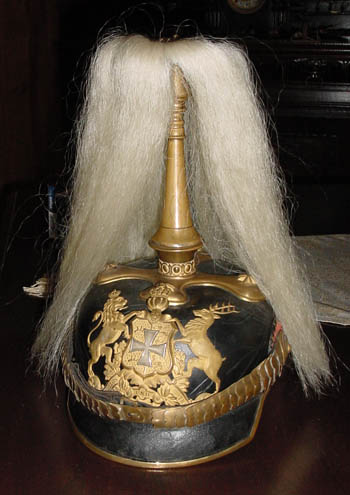
The Fähnrich
Over the last couple of years, there have been some changes to “conventional wisdom” as Fähnriche helmets have been rediscovered. xiii. Of course, there is no equivalent to Fähnrich or ensign in the U.S. Army so collectors had to stretch their knowledge base to comprehend this rank structure. “Conventional wisdom” had it all wrong. Even the recent volume, Imperial German Military Officers’ Helmets and Headdress 1871 by by Thomas Stubbs (Schiffer Publishing, Atglen, PA , 2004) included the incorrect premise that Fähnrich helmets were the same. xiv.
The commissioning process is covered in another article. However, from a helmet perspective they are in most ways identical to OYV helmets. Officer aspirants were either a Fahnenjunker or a brevet Fähnrich. Then you became a Fähnrich in conjunction with the Kriegschule, then you became a PortapeeFähnrich (or DegenFähnrich) if you passed the Officer test. At this point he could wear officer cockades. Up to that time OR cockades. In 1899 we confused everyone by just calling all Fähnriche– Fähnriche.
Only Fähnrich that had passed the officer exams wore officer cockades. OYV xv. and early (non-test taking) Fähnriche wore OR cockades. Helmets for all Fähnrich and OYVs wore Eigentums helms and had mixtures of officer and OR items. The only thing you can tell is that officer cockades = upper level, test passing Fähnriche and OYVs had OR cockades. You cannot tell between OYV and lower level Fähnrich.
Other Headgear
There were one-year volunteer headgear for all of the different kinds of headgear. There is no intent to cover all of them in this short article.
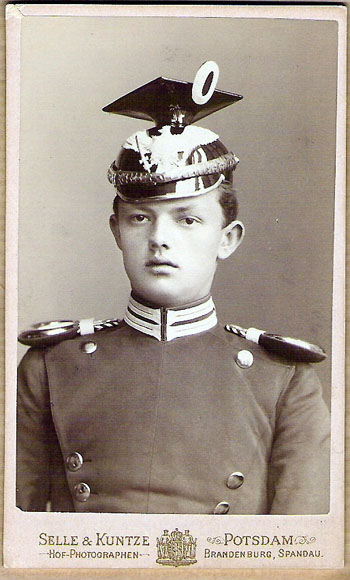
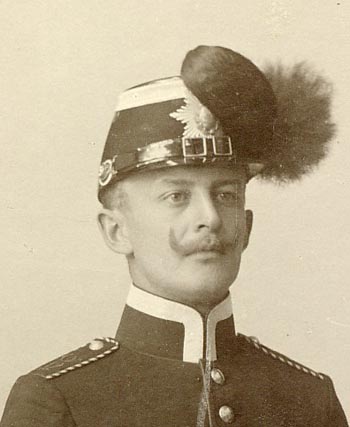
Private Purchase Studio Photos
There are many studio photographs of privates who are not one-year volunteers that have private purchase helmets. This was allowed. However, it is not clear if these helmets belonged to the individual, the unit, or were a photographers prop.
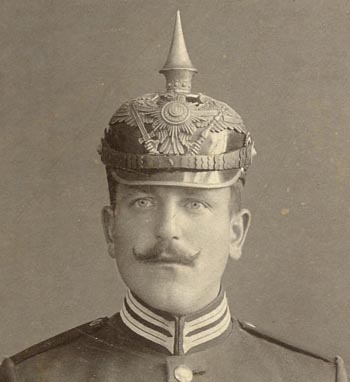
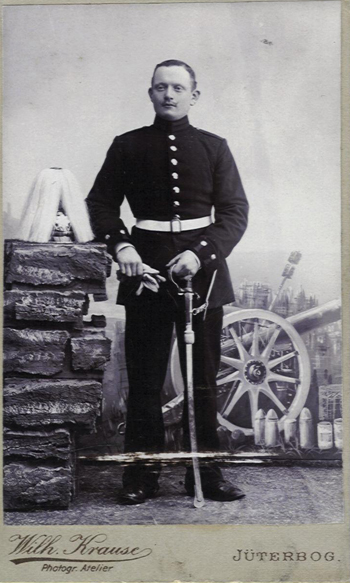
OYV helmets have been the bane of people fighting fakes and doctor jobs. This is compounded by Stubbs rightfully including “bad” helmets as “good” in his recent text. xvi. The recent book by Charles Woolley focuses on the difference between regulation and field use. There are several Fähnrich helmet pictures in the Stubbs book which can be grist for thought. Pg 96,148, 187, 188, 290, 291, 300, 301, It is instructive that this recent book changes the conventional wisdom but does not “fix” it. There are no OYV helmets shown in that book, only Fähnrich. I point to the caption for the helmet on pg 148. “Helmets of Fähnrich were normally fitted with officer cockades.” Tilt.
- Johansson, Eric, Pickelhauben, H.S.M. Publications, Independence , Missouri , 1982. pg. 175-180.
- Bowman, J.A., The Pickelhaube Volume 1, Line Infantry, Imperial Publications, Lancaster England 1989 pg 26-49.
- Exner, Moritz, Der Weg zum Einjährig-Freiwillinen, Verlagbuchhandlung von F.F. Weber, Leipzig, 1897
- Frevert, pg 159-160
- Frevert, pg. 225.
vii. Nagel, Fritz, Fritz,Der Angriff Publications, Huntington W. VA., 1980 pg 11.
viii. Exner, Moritz, Der Weg zum Einjährig-Freiwillinen, Verlagbuchhandlung von F.F. Weber, Leipzig, 1897, pg 102-104.
xii. Stubbs, Thomas N.G., Imperial German Military Officers’ Helmets and Headdress 1871, Schiffer Publishing, Atglen , PA , 2004, pg 32.
xiii. Robinson, Joseph P. , Colonel J’s Imperial German Pickelhaube Musings, Colonel J’s LLC, 27 March 2004.
xiv. Stubbs, Thomas N.G., Imperial German Military Officers’ Helmets and Headdress 1871, Schiffer Publishing, Atglen , PA , 2004.
- Bowman, J.A., The Pickelhaube Volume 1, Line Infantry, Imperial Publications, Lancaster England 1989 pg 74 states OYV wore NCO cockardes. I think this is fantasy as I can find no AKO backing. One of many Bowman mistakes.
xvi. Stubbs, Thomas N.G., Imperial German Military Officers’ Helmets and Headdress 1871, Schiffer Publishing, Atglen , PA , 2004, pg 174 for example.
There are many people who contributed to this article. There are helmets from the collection of Steve Flanders, Bruno Peault, Mark Avery, Randy Trawnik and the author. Frank Buchholz translated the two different articles. The pictures of Brian Kostel and Max Chaffote are located in the article. If I have forgotten a contributor it is an accident and I will correct it. Please let me know.
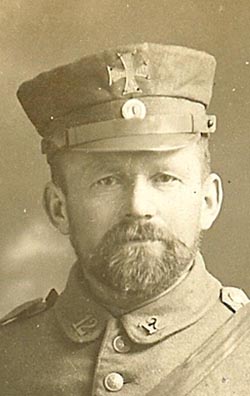
Landsturm
George Wylie and Joe Robinson
20 March 2009
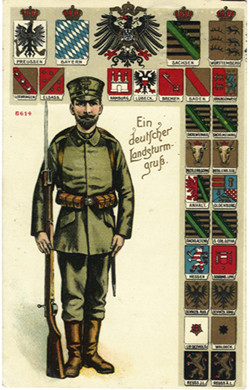
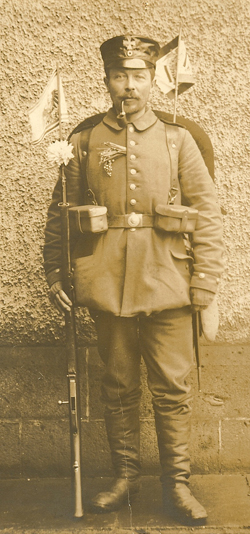
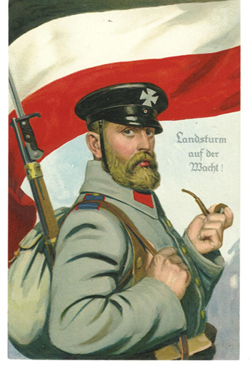
There are lots and lots of confusing pictures about Landsturm. This is easily traced to the fact that most people do not understand the Landsturm and that there was no real standardization. With the exception of a paper drill, before World War I they did not exist. They existed only on paper.
In the Wehrordnung of 1888 the Landsturm was laid out in two separate and distinct levies or bans. They’re really one along the lines of young boys and old men. Between the first of January and the middle of February, a list of service eligible young men from the subject class year was put together. Requests for exemption from service were considered by the lowest recruiting committee. Citizens were categorized by class designated by the year in which they were born. So the class of 1892 for instance would be the recruiting process in 1912 at the age of 20. This is often confused because the French system used the year in which they reported in as a class number or year. There were basically two divisions of manpower, active military service (Dienstplicht and Landwehr) being one; and the Landsturm being number two. In certain theory, this was supposed to cover the ages of 17 through 45.
Most guys got out of Volksschule at the age of 14. Required active service started at the age of 20. Between the ages of 17 and 20 you were not part of the Dienstplicht. You actually were assigned to the Landsturm, ban 1. So going back to our example the class of 1892 would enter Landsturm ban 1 at the age of 17 or in 1909. The entire class – really almost everyone was entered on the rolls of Landsturm ban 1. These individuals had no military training, were not organized into standing units, and were really there for reporting purposes.
The first ban included all untrained folks that were not on Dienstplicht from the ages of 17 through 39. There were individual exceptions based upon officer and noncommissioned officer training and a few folks who enlisted or were in the one-year volunteer program.
During the year the class turned 20 there was a large local event known as the Musterung. The ritual Musterung was supposed to announce the class into the military – Dienstplicht. Reality was different as not nearly all of the individuals entered Dienstplicht. Not everybody served. Look at this table from 1907.
Number of men liable 556,772.
Physically unqualified 35,802.
Voluntarily enlisted before required age 57,739.
Sent to Navy 10,374.
Available as army recruits 452,857.
Assigned to active military service 212, 661.
Assigned to Landsturm 240,196.
While the top line continued to grow, the percentage of soldiers needed varied by year’s requirements for replacements and maneuvers. The population had grown from 56 million to 67 million from the turn-of-the-century to 1913. Yet in 1912, only 240,000 were assigned to active military service, and in 1913, 304,000 were assigned to active military service.
The second ban of the Landsturm included all soldiers and untrained individuals between the ages of 39 and 45. Second Ban Landwehr soldiers joined the second ban of the Landsturm at age 39. This was a really rough militia. There was no training requirement. A home guard at best. This was the way individuals were controlled throughout their lifetimes. Not only were the reserve and Landwehr controlled by the Bezirkskommandos the Landsturm was controlled by the Army Corps District in the same way – Bezirkskommando. Administratively Landsturm soldiers were grouped by town and the lowest recruiting organization.
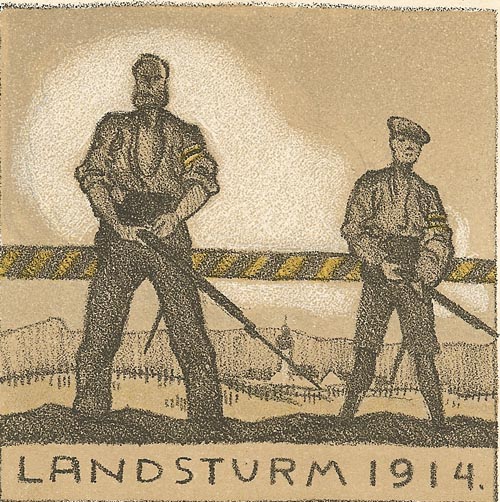
At the age of 45 the class would be mustered out as in the picture below. Note the lack of uniforms. There was a great deal of pressure to get Landsturm soldiers to join the veterans organization and be put in the “reliable” group of citizens.
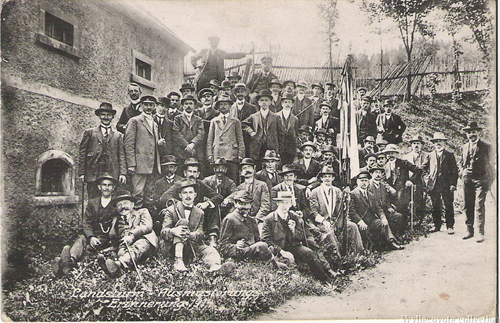
War 1914
When war was declared the Landsturm ran towards the colors. Those with military training were formed into battalions. Below are Bavarians from Landsturm Btn. Rosenheim (3rd Btn.), and are identified as such by the words on their white armbands. This photo was sent from Munchen on 8 Sept. 1914, 1 week after mobilization. The guy kneeling with the shooting award is also wearing a “Kaiser Centenary” medal, as well as another ribbon in his left top button hole. Note the lack of any metallic collar devices, but there is a metallic Arabic number one on the shoulder straps for I Bavarian A.K.
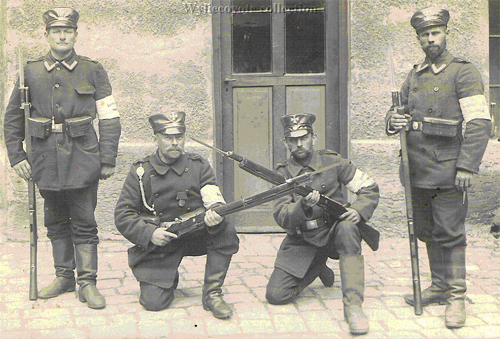
These battalions vary greatly and standardization was not found anywhere. The people with military training came from ban two and the organization was formed into battalions named after the town such as:
Ldst.- I.-Btl.-Schneeberg .
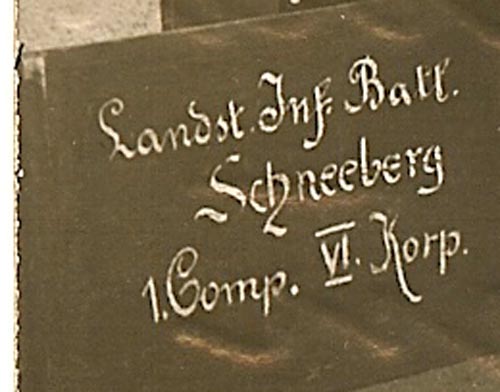
There were 334 Landsturm battalions established. Of these 142 were considered “mobile”. Most of the Landsturm were placed towards the Eastern front and eventually they were used in the area of communication to replace Landwehr soldiers. There was even some use of Landsturm on the Western front in quiet sectors.
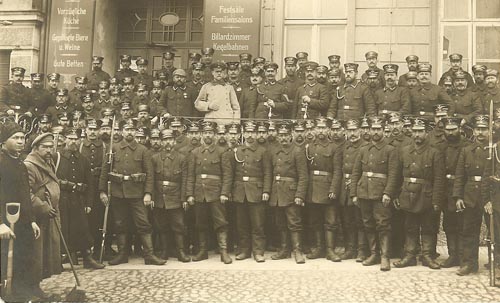
The battalions that fell under the Bezirkskommandos were administratively grouped into brigades that followed the peacetime brigade boundaries of the Army Corps District. So as far as the number of battalions per brigade — it varied greatly. Determining factor was how many battalions were located inside the geographic boundaries of the brigade area. This brigade assignment can be easily seen in pictures as the individuals wore 25mm metallic Arabic numerals or “Collar Dogs” to display brigade affiliation as these from the 89th,43rd & 5th Brigades. This was an administrative brigade number. This did not reflect an employment capability.
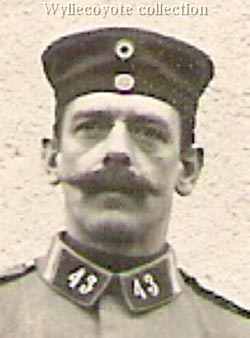
Landsturm brigade organization is really a bit of a misnomer. There was no brigade for the Landsturm as in a commander and a staff. There were administratively grouped into brigade organizations only because they were administered by the Army Corps District which was itself broken down into brigades. It gets even a little more foggy because the battalions were administered through the Bezirkskommando. This is the same as a Landwehr soldier. Some battalions did not fall under a Landwehr Bezirkskommando. There was such an organization as a “Landwehr inspection” which took the place of a Bezirkskommando in some instances. I do not believe that these individuals wore any kind of collar dog.
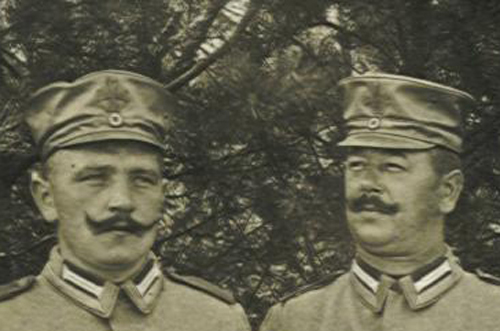
Those Landsturm units that were used in the opening order of battle were often placed into Mixed Landwehr Brigades. This did not follow perhaps any logic at all. For example the first and second Landsturm infantry battalions of the XVII Army Corps were part of the 70th Mixed Landwehr Brigade which was part of the Landwehr Corps of the 8th Army! The collar dogs did not reflect the number of that brigade.
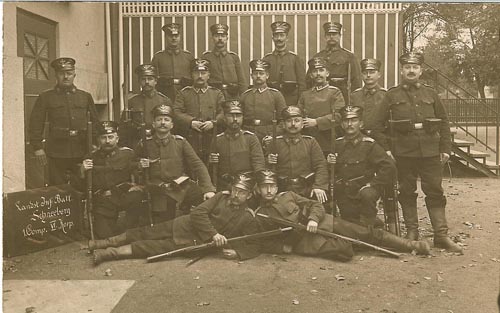
Putting equipment on these soldiers was a ragtag operation. The Army Corps District had stockpiled some equipment but not nearly enough to handle the influx. Old equipment was heavily utilized for the Landsturm. In many cases Landsturm units that had superior equipment issued had to turn around and surrender that equipment to frontline soldiers.
What constituted a uniform was relatively interesting. The German psyche was built around experiences in the Franco-Prussian war. The great moral dilemma was identifying enemy combatants as opposed to civilian partisans known francs-tireurs. Even this was at times distasteful for the Germans as irregular warfare was not considered quite “right”. Perhaps one quarter of the German troops during the Franco-Prussian war were tied up defending the lines of communication against the francs-tireurs.
The senior German commanders of World War I in 1914 had participated on the German side during the Franco-Prussian war and those memories were deeply emplaced. The Hague convention of 1899 required in article 2 that militias such as the Landsturm or francs-tireurs be under responsible command, have a distinct uniform emblem, carry arms openly, and observe the laws of war. The distinct uniform emblem and following this convention when convenient became a mantra of the German forces and eventually led to many excuses for atrocities.
Note the white armbands utilized in the pictures below. Armbands were often used to indicate a uniform.

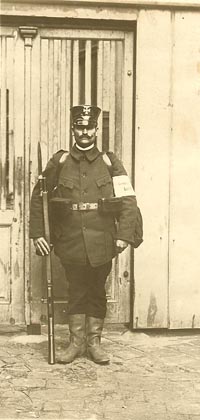
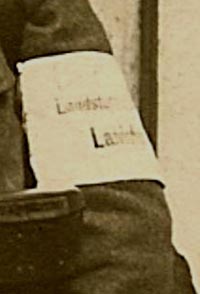
The standard Landsturm headgear was supposed to be an oil cap. This was known as a
Wachstuchmüzte and came in many forms. As you can tell from the regulation below the real intent was to wear the oilskin cap over the Feldmütze.

There was supposed to be a cockade from the land on the bottom and a yellow or white metal Landwehr cross on the top. This did not always happen and there were far fewer oilskin caps than were needed. While many of the caps were indeed from oilskin, some were of cloth. Standardization of the insignia left much to be desired.
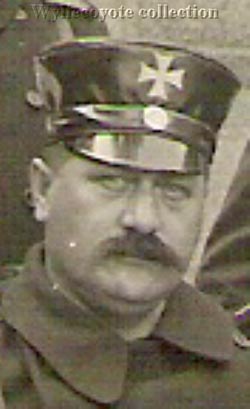
This first example is a basic oilskin cap, which has the metallic Landwehr Cross over the Landes or State cockade. Notice the absence of any collar devices. This photo was very early War, he was also wearing an armband with the name of the city / town where his Btn. was raised. Not all crosses were what one usually expected. The Prussian cross had the normal motto. However, Bavaria, Hesse, Saxony, the Hansa cities, and Wurttemberg had unique mottos like the examples below. There also were Fürst crosses. These crosses were sewn on to the oilskin cap or attached by two prongs. For some reason a cross with the date 1914 shows up.
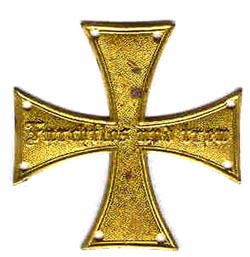
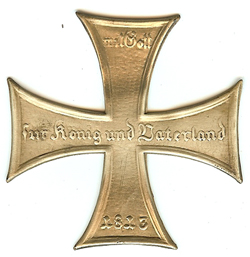
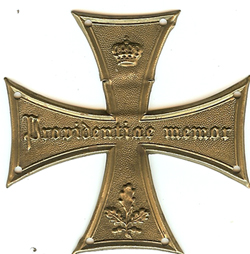
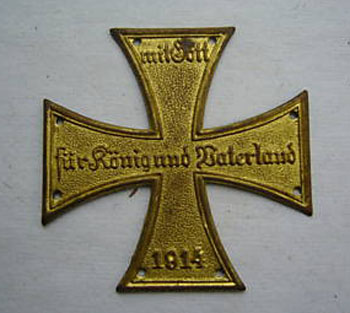
This NCO on the left is wearing a feldgrau cloth type wachstuchmutze also with the Landwehr Cross on top and the Landes cockade on bottom. It retains the black leather visor of the oilskin mutze. The photo is undated & there are no shoulder straps to identify his unit. The individual at center from 41st brigade has a Landes cockade with a Landwehr cross on it, and a national cockade centered above. The fellow at right has both cockades centered above and below the Landwehr Cross. The hat visor appears feldgrau.
His picture is dated April 1915.
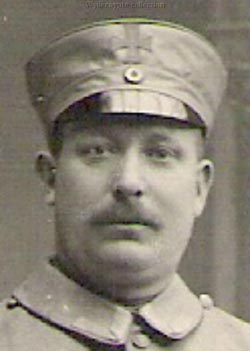
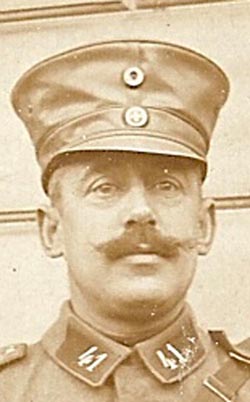
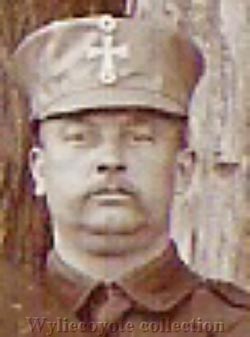
These three hats have a chinstrap which were not common to all caps. This individual on the left was assigned to the 12th brigade. The number 12 on his collar is called a “collar dog”. The one at center displays the upper Reich & lower Landes cockades. His photo was sent from Nordheim / Hannover 4 Sept. 1915. The one on the right has a visor which appears it may be feldgrau. This one has the lower Landes cockcade and the upper Reich cockade is centered & mounted over the Landwehr Cross. This set up is truly uncommon. Photo was undated, and there are no shoulder straps or collar dogs to identify his unit.

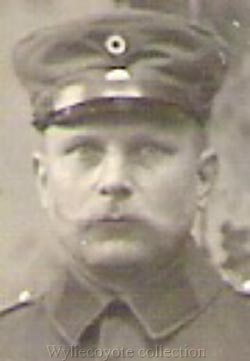
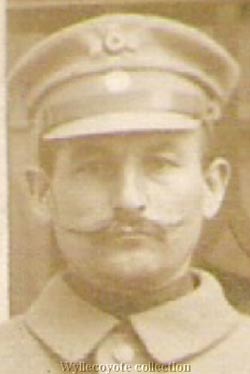
The variations on the types of hats seems endless. As the picture below will show you variations in even one unit were significant.

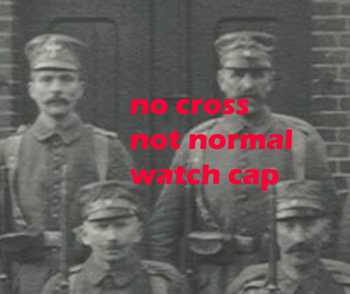
In addition to the wachstuchmutze, there was also an uberzug (cover) to eliminate the nighttime glare from metal devices attached to the hat. The gent at right has a different variant, which does not have a cover over the visor, and seems to use a drawstring to hold it onto the mutze.
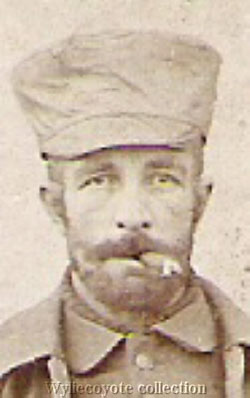

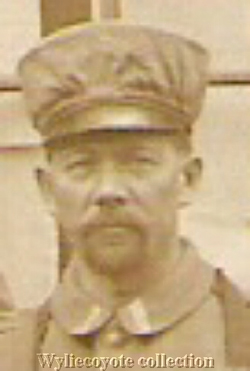
Shakos
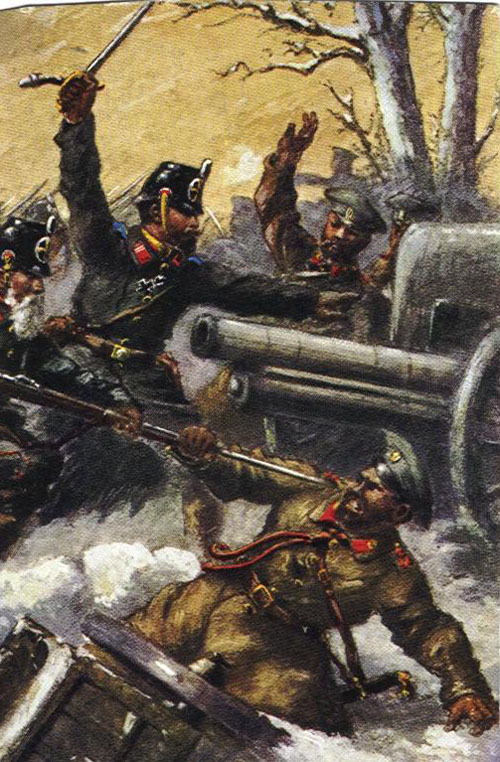
There were not enough oilskin caps to go around. The first step of substitute headgear was to revert to the old Landwehr shakos. Units just dusted off the old helmets and reissued them.This was not always clean as there was a mix and match in the picture shown below.

Using old shakos created further standardization problems. Not only were there shortages of oilskin caps but there was a shortage of standardized old Landwehr shakos from earlier than October 1899.

In October 1899 the Landwehr was allowed to wear helmets. However, they were instructed to maintain the shakos. Exactly what this last directive amounted to was probably carried out differently in different areas.
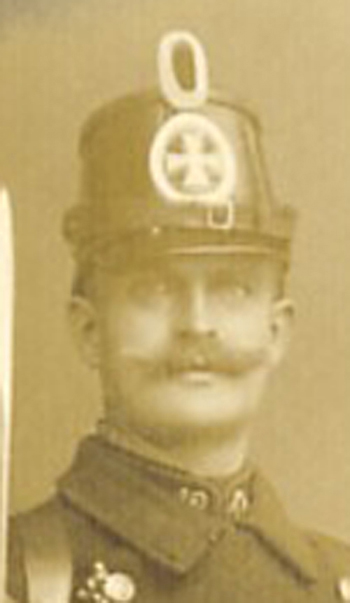
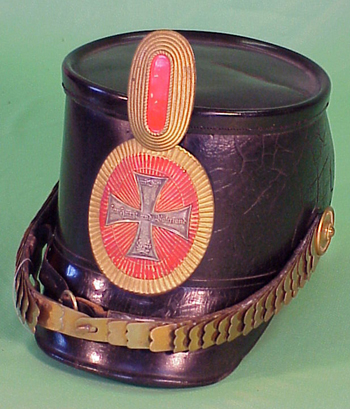
Most shakos were supposed to be leather with a large Landwehr cross and blazoned over the colors of the land. However, all kinds of shakos were pressed into service. Sometimes it is difficult to determine any kind of standardization within a unit as some photographs show old Landwehr shakos mixed in with shakos with Prussian eagles on them. Shakos also became part of the Ersatz world. Not only was there an endeavor to make Landwehr shakos out of filtz but there were also shakos such as this one from the Cotbus Battalion.
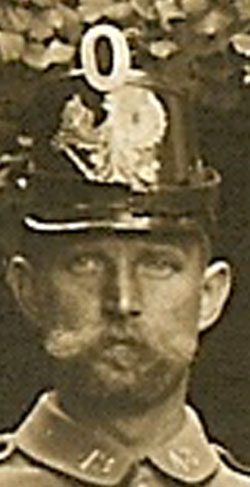
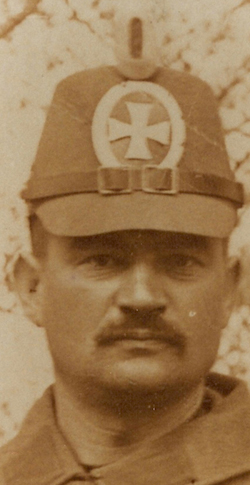
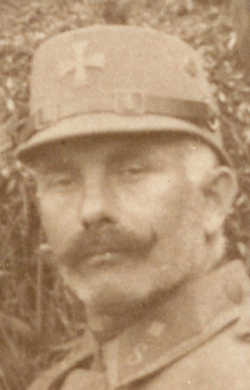
Other old shakos existed for the Landsturm including these old Hessian shakos.
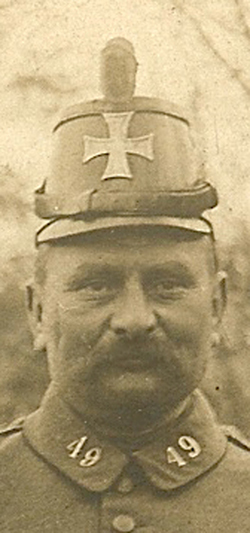
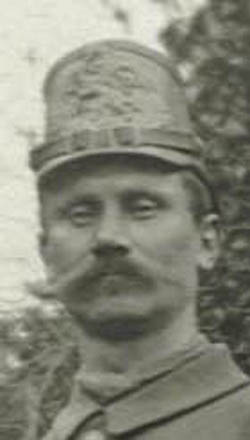

Here is a twist. This photo on the left has a sign that reads “Andenken an Russland 1914”. It appears the tschacko, feldzeichen , wappen & chin strap were painted feldgrau. If you look at the upper part of the Landwehr wappen, bottom right of the feldzeichen, you can see some white paint that was chipped or not painted over. There is no explanation for this. Was it on a trail basis or the work of an overzealous commander? In addition to the Landsturm Tschako there was also an uberzug as the 37th Brigade man on the right has.
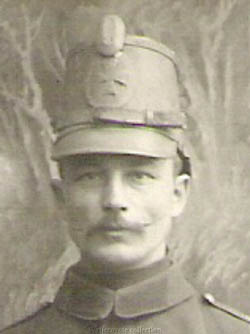
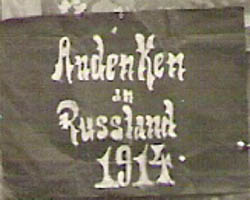
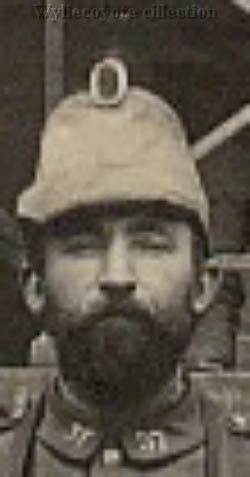
One cannot jump to the conclusion that shako automatically means a Landsturm soldier or unit. In addition to the many units equipped with more modern shakos the older ones were used for other units also as this ersatz battalion photograph shows.
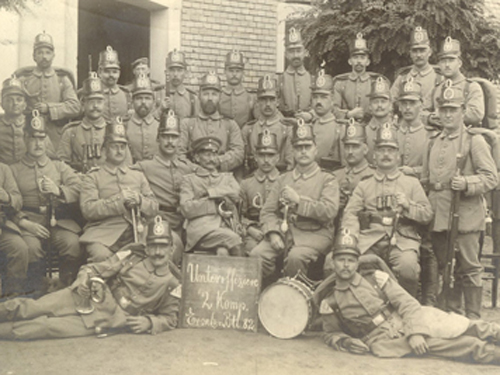
Corps Collar Dogs
It is very difficult to keep track of individual battalions as their name changed throughout the war and organizational structure was scattered in different directions. In the spring of 1915 the use of corps number and battalion number within that corps became the standard for naming battalions. In our example Ldst.- I.-Btl.-Schneeberg became example Ldst.- I.-Btl.-Schneeberg (XIX. 17). In theory the collar dogs changed at the same time showing a Roman numeral corps number and an Arabic battalion number.
The brigade collar dogs were eliminated on 14 April 1915. There was an AKO that detailed all of the different insignia of the Landsturm.

While this directive was all-encompassing it is not clear how well it was followed or to exactly what chronology. An allowance was specifically made to use up the existing brigade numbers — what ever that meant.
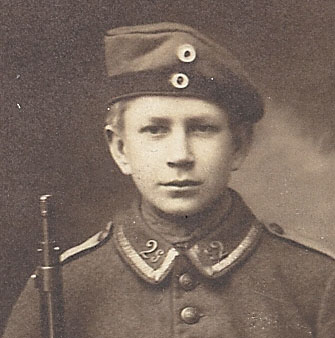

What the AKO did not do is indicate the exact size of the collar dogs. It also did show them to be displayed on top not side by side. It also directed a specific corps symbol to be used for the Guard Corps. While the symbol looks like some sort of a fancy “G”, the actual symbol looked very much like an S.
A series of different collar dogs ensued. New smaller corps numbers were added along with smaller battalion numbers. Old-style big numbers were used in conjunction with the small numbers when they were available and the AKO was followed — sort of. In the picture below this Landsturm on left uses a combination of small corps numbers and large battalion numbers. The individual on the right has small numbers all around and the individual in the center has corps numbers only.
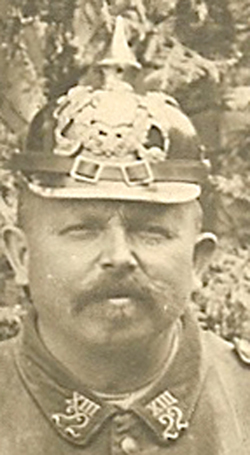
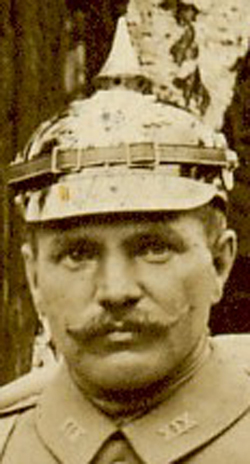
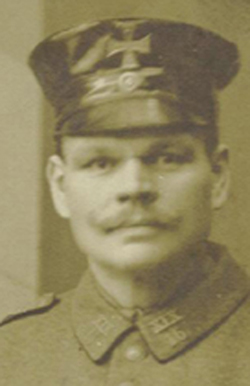
While the contingent elements of the Imperial Army melded into the Prussian corps system, as the soldiers from Württemberg and Saxony above show, Bavaria had their own corps structure. In collar dogs and this was reflected by the letter “B” co-located with a corps number.
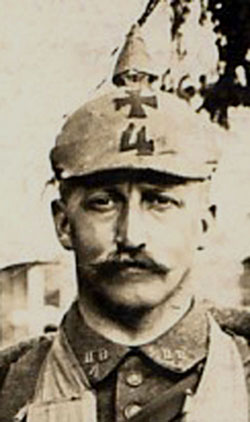
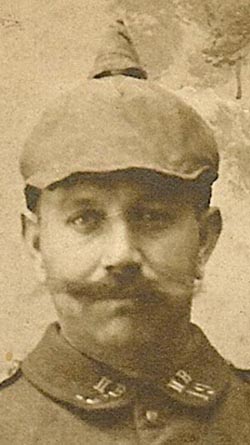
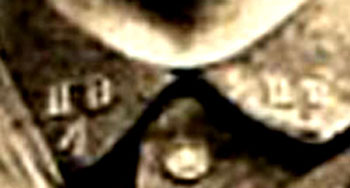
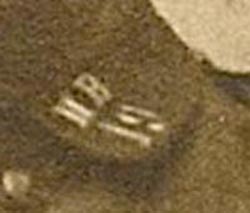
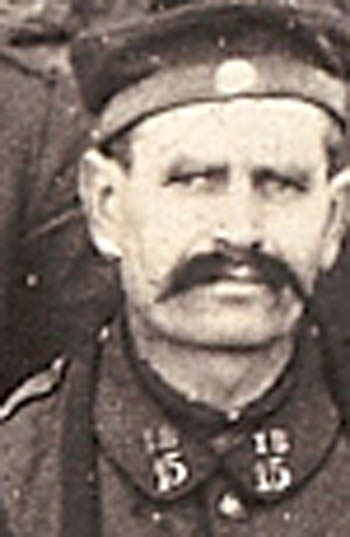
Collar dogs that were improperly displayed side-by-side were also displayed in different ways. Some have their battalion number first and some had the corps number first.
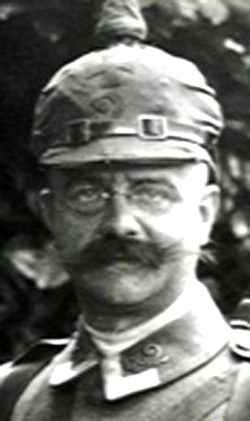
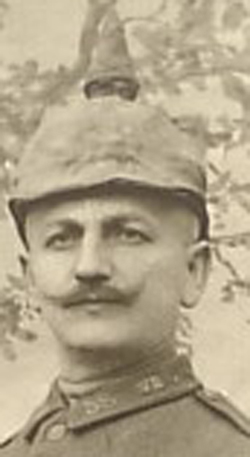
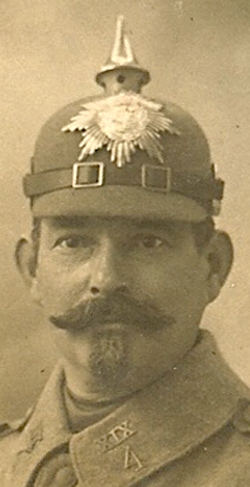
Some of the units displayed combinations and often times no collar dog was displayed at all.
Spiked Helmets
Spiked helmets were issued to Landsturm soldiers as the helmets became available in early 1915. As with most things regarding the Landsturm there were exceptions to the rule as the photo of the 44th Brigade Nieder Zwehrin Btn.below confirms.
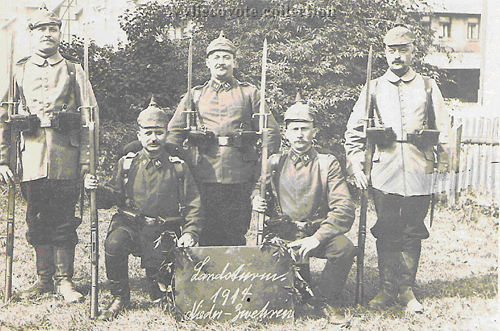
The Landsturm helmet cover or Uberzug (M1892) was issued after 2 March 1915. The Uberzug was directed to have a green Landwehr cross and battalion number underneath. This was accomplished by sewn on felt or cloth, or use of stencils. As you can see from the picture below the individual at the left has a battalion number on his collar dog but no battalion number on his helmet.
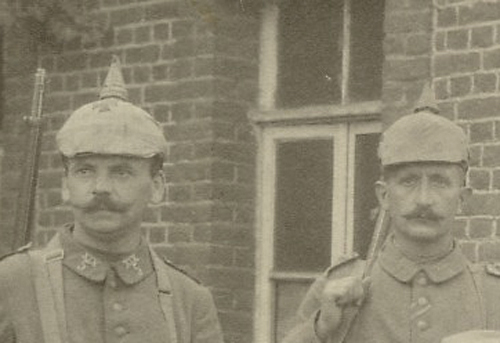
As with all Landsturm regulations the guidance was followed somewhat. The endeavor to identify the Landsturm soldiers from a distance was codified by the large Landsturm AKO on 14 April 1915. A large Landwehr cross and bn. number in arabic were authorized. There are many variations on the Uberzug identification. The individual on the left correctly displays a corps number and a battalion number on his collar and the Landwehr cross and battalion number on his Uberzug. The individual in the middle has a blank Uberzug. The soldier on the right uses a metal Landwehr cross from an oilskin cap on his Uberzug.
The forlorn individual on the left below has a combination with a Landwehr cross corps number and battalion number all on the Uberzug. He only has the corps number on his collar dog. The individual in the middle has complete information on his collar dogs but there is no Landwehr cross on his Uberzug. The individual on the right has the Landwehr cross corps and battalion numbers on his Uberzug but it is displayed vertically. He has guard Litzen and not collar dogs and there is no real explanation of this.
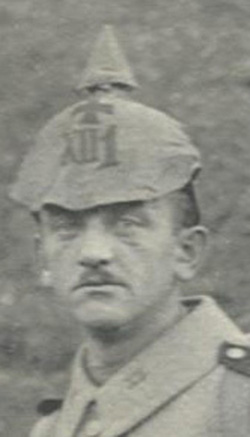
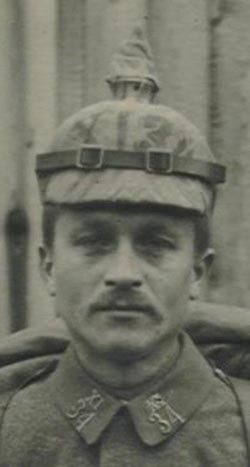
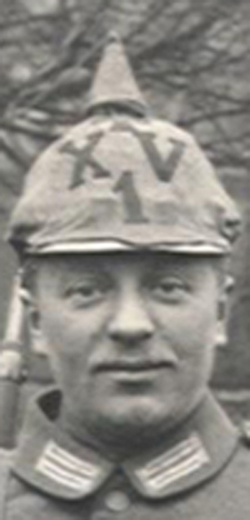
Finally this picture shows a soldier of XIII 26 but his Uberzug has the letter “L” which was used not for Landsturm but by AKO only for the Landwehr!
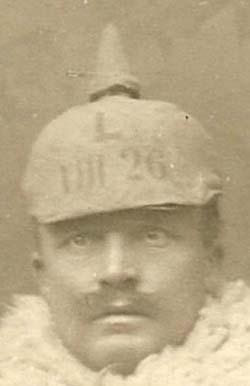
As mentioned above, the Landsturm Uberzug was directed to have a green Landwehr cross with battalion number underneath, as the III Armee Korps man on the left from the 11th Btn. illustrates. The Landwehr Cross and Btn. number are sewn on. The M1915 Uberzug was issued 28 June 1915, at the same time that initial issue of the M1915 pickelhaube occured. This uberzug had a removable spike cover, and had slits on the sides that allowed the chinstrap to be passed through the cover. An AKO of 21 September 1915 required all helmet tops to be the bayonet style, and all troops at or near the front were ordered to remove their spikes, as the III A.K. 50 Landsturm Btn. soldier in the center illustrates. On 27 Oct. 1916 all troops were ordered to remove all unit Identifiers & numerals from all Uberzugen, as this man from XIX A.K. 20 Btn. — Ldst.-1st Btl. Rochlitz formed August 1915 on the right illustrates.
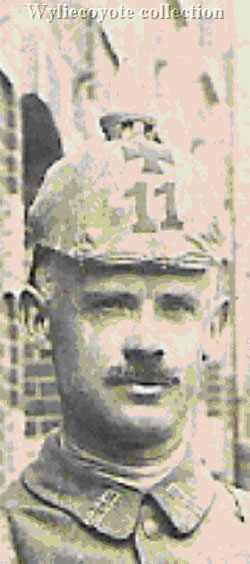
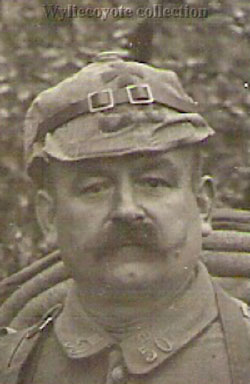
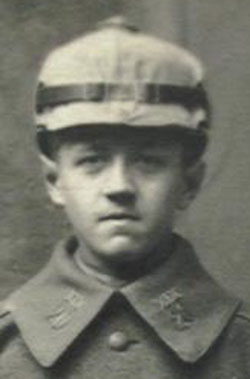
Men of the 3rd Kompanie of Bavarian Landsturm Infantrie Btn.Gunzenhausen, III B.A.K. 6th Btn., sent 29 April 1917 from the “Front”.
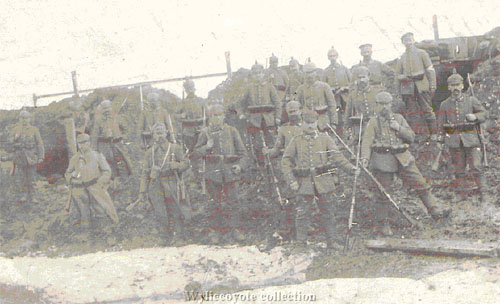
Steel Helmets
The first shipment of German steel helmets or stahlhelms arrived at the Western Front for field-testing in December 1915. The first 30,000 helmets were issued to assault troops serving in Verdun at the end of January 1916. 22 January 1916, Gen. Ludendorf, Chief of the General Staff, announced the priority that German troops were to be issued stahlhelms: Infantry, active cavalry, pioneers & mortar units, Foot & field artillery batteries. Chief of Staff of the Field Army, General von Falkenhayn authorizes the introduction of stahlhelms in February of 1916. Helmets were designated Modell 1916.
So it came to pass that Landsturm troops were issued stahlhelms. All German troops Troops with steel helmets were ordered to turn in their pickelhauben to the replacement troops sections 11 Feb 1917.xv Oilskin became rare as the war progressed and in 1918 the oilskin caps were eliminated. Collar dogs became less obvious in photographs.
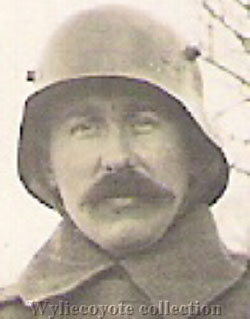
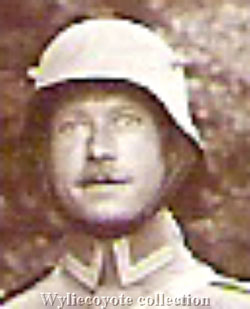

However, the Landsturm battalions maintained their identity and the last division formed in the war 303 Infantry Division consisted entirely of Landsturm battalions: Landsturm Bns I/25, Bavarian I/25, Bavarian I/26, XI/35, XIX/27, III/50, III/51, XVII/12, XVIII/54 and XX/22. This unit served on the Eastern front. Unfortunately the photo below is undated and the unit is not identified. If you look closely you can see the collar dogs on their tunics.
Landsturm soldiers continued to serve throughout the war. In the West, we tend to think of the Landsturm as operating mostly in quiet sectors, guarding Prisoners of War, used as Occupation & Fortress Troops and rear echelon support truppen who rarely went into combat. This is probably because that was the observations coming from our countrymen who were involved in the conflict on the West Front. But in the Ost Front, Landsturm troops were more heavily relied upon in combat formations. Their contributions to the overall Imperial German War effort are under appreciated and little understood. Some Landsturm battalions were combined into Landsturm regiments. some of those became mixed with other elements such as the Landwehr. Eventually Ersatz regiments merged into guard Regiment and as Cron said: “…the original clear distinction accorded to active status, Reserve, Landwehr etc. had become completely blurred.”

This is a small primer on Landsturm. We welcome your comments and corrections! There are several pictures in this article from the collections of Randy Trawnik and Brian Kostel, we thank them.
PS- as a side note I still find things I have no explanation for. Look at this one. A Landsturm guy with a brigade collar dog and a tropical helmet. Why? The collar dogs like this went out long before there was a Macedonian front.
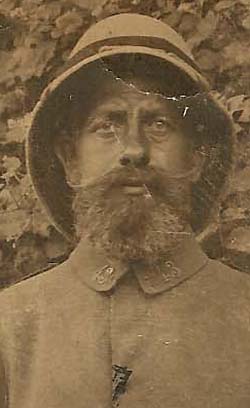
Notes on the German Army in the War, Translated at the Army War College, Government printing office, Washington, 1917, pg. 28.
Harrell John, L, Regimental Steins, The Old Soldier Press, Hagerstown, MD, 1983.
Berghahn, Volker, Imperial Germany, Berghahn Books, Providence, 1994, pg.43.
It is important to remember that the abbreviation Korp. Stands for Korporalschaft not Army Corps. So this is a small group of trainees organized in a Korporalschaft.
Horne and Kramer, pgs. 140-148.
The only reference I know of that has the Landsturm Battalion identification in is the Busche manuscript. This specific Battalion is located on page 112.
xv Ludwig Baer – The History of the German Steel Helmet 1916–1945
Trawnick Collection
 Look at this picture. When one thinks of the invasion of Belgium we think a wide open plains. Easy terrain for both cavalry and infantry. No hills. Some rivers. But looking at the picture of the 30 or so kilometers between the German border and the fortress at Liège you can see that this is pretty rough country. This terrain had to be covered before anybody started attacking any forts in Liège. In addition, and more importantly, the railroads leading from the homeland through Liège had to be open and free to move along with large amounts of supplies. Supplying the German army was a function of railroads cars. Therefore, we would expect that the Great General Staff of the German army would ensure that their plan included clearing these railroads. But that part of the plan proved to be too tough of a nut to crack. So the Germans kind of ignored it and hoped for the best. This alone should be reason to run out and purchase the book.
Look at this picture. When one thinks of the invasion of Belgium we think a wide open plains. Easy terrain for both cavalry and infantry. No hills. Some rivers. But looking at the picture of the 30 or so kilometers between the German border and the fortress at Liège you can see that this is pretty rough country. This terrain had to be covered before anybody started attacking any forts in Liège. In addition, and more importantly, the railroads leading from the homeland through Liège had to be open and free to move along with large amounts of supplies. Supplying the German army was a function of railroads cars. Therefore, we would expect that the Great General Staff of the German army would ensure that their plan included clearing these railroads. But that part of the plan proved to be too tough of a nut to crack. So the Germans kind of ignored it and hoped for the best. This alone should be reason to run out and purchase the book.
In this rough terrain along the railroads were four tunnels that the railroads ran through. If the tunnels were not there the Germans would not have any choice but to build a bypass which could take months. So the Germans in the original Handstreich plan sent cavalry squadrons to secure the tunnels. Yes that’s right. The only plan was to assume that there would be no enemy resistance and send a few horsemen galloping many kilometers to secure this absolutely crucial point.
The Belgians were not stupid. They planned on dynamiting these tunnels prophylactically. While all four tunnels were rigged with explosives, they had serious problems with the age of those explosives and their vitality. Only one tunnel was permanently blocked through the use of these explosives. This picture shows the Trois-Ponts Tunnel.The plan was to create an obstacle in its middle. Six of the eight charges detonated caused an obstruction such that on August 11 the Germans started constructing a bypass track. They finished on August 30. Meanwhile, trains stopped on one side of the tunnel, and their cargo transshipped. German accounts said that on August 11 the line was cleared up to the tunnel of Trois-Ponts but with a break of forty-two meters in the middle it would take months to reopen. In consequence, the Germans then opted for a 1.75-kilometer bypass to span the River Salm, building a 120-meter long and twelve-meter high wooden bridge. That work lasted until August 28.
After that tunnel repair was entrusted to a private German company, Grün und Bilinger, which started work on August 30 and cleared the passage on one track by November 26. In early 1915, the Germans decided to rebuild the tunnel for two tracks while maintaining traffic on a single track. That work ended in December 1915.

